Introduction
In the dynamic realm of retail, where efficiency and innovation are paramount, Robotic Process Automation (RPA) emerges as a transformative force. By harnessing the power of software robots to automate repetitive tasks, retailers can not only streamline operations but also enhance accuracy and speed, ultimately allowing human employees to focus on strategic initiatives that elevate customer experience.
From inventory management to customer support, RPA applications are reshaping how businesses operate, enabling them to respond swiftly to market changes and consumer demands. As retailers navigate the complexities of implementation, understanding the myriad benefits and potential challenges of RPA becomes essential for driving sustainable growth and maintaining a competitive edge in an ever-evolving landscape.
This article delves into the profound impact of RPA on retail operations, illustrating how it can revolutionize the industry and empower organizations to thrive in the face of change.
Defining Robotic Process Automation (RPA) in Retail
RPA in retail represents the use of software robots, commonly known as ‘bots’, to streamline and automate repetitive, rule-based tasks that have traditionally been managed by human workers. These tasks encompass a wide range of activities, including:
- Data entry
- Order processing
- Inventory management
- Addressing customer service inquiries
By implementing RPA in retail, businesses can significantly enhance accuracy, speed, and overall efficiency, enabling their human workforce to pivot towards more strategic roles that foster customer engagement and satisfaction.
Notably, tools like EMMA RPA and Microsoft Power Automate serve as innovative solutions to enhance operational efficiency and employee morale. EMMA RPA revolutionizes automation by offering seamless digitalization and user-friendly applications, while Power Automate transforms operations through powerful automation capabilities. In a case study showcasing a mid-sized company’s success, GUI automation effectively reduced data entry errors by 70%, accelerated software testing by 50%, and improved overall workflow efficiency by 80%.
Such results exemplify how RPA in retail can not only address staffing shortages and task repetition fatigue but also modernize outdated systems, ultimately driving productivity. Furthermore, RPA in retail leverages predictive analytics algorithms to forecast sales and suggest promotional offers, providing retailers with valuable insights to enhance decision-making. In today’s fast-paced marketplace, characterized by constant change and competition, RPA in retail stands out as a pivotal solution for achieving operational efficiency—a critical factor for sustaining a competitive edge.
Leading digital transformation firms stress that the incorporation of RPA must focus on security and compliance, following industry regulations such as GDPR and HIPAA, thereby strengthening trust and dependability in business activities.
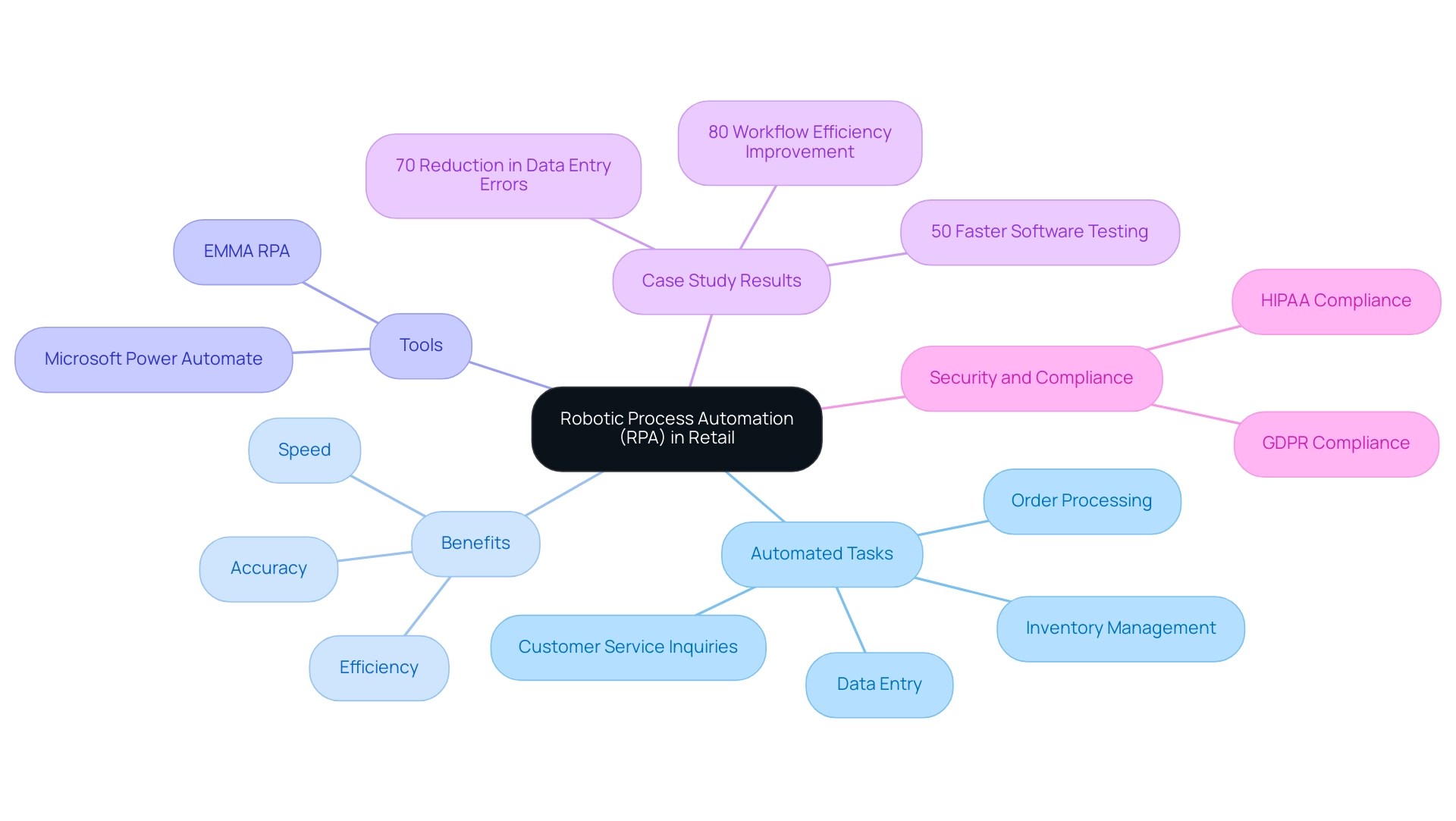
Key Applications of RPA in Enhancing Retail Operations
Robotic Process Automation (RPA) is transforming commerce operations by streamlining various critical processes, particularly in the following areas:
-
Inventory Management: Automating stock level monitoring and reordering processes is essential for maintaining optimal inventory levels. This approach not only prevents stockouts but also curtails overstock situations, enhancing overall efficiency. As noted by Colleen, a marketing specialist at Canary, > Inventory management is a critical component of your supply chain that presents numerous challenges. However, by understanding these challenges and leveraging advanced technology, you can navigate these issues with professionalism and efficiency. With the trend towards smaller warehouses, where sizes are decreasing from an average of 400,000 square feet to as small as 200,000 to 50,000 square feet, efficient inventory management through RPA in retail becomes even more critical for success.
-
Order Processing: RPA bots are adept at handling order entry, verification, and tracking tasks, effectively reducing processing times and minimizing human error. This leads to faster fulfillment and improved customer satisfaction, showcasing the benefits of RPA in retail by addressing the common challenge of staffing shortages and allowing teams to focus on more strategic tasks.
-
Customer Support: Deploying RPA for customer inquiries through chatbots enables instant responses, freeing human agents to manage more complex issues. This shift enhances service quality and responsiveness, combating employee exhaustion from repetitive inquiries.
-
Data Management: Automating data entry and reporting tasks allows retailers to access real-time analytics, facilitating informed decision-making. This capability is crucial in today’s fast-paced commercial environment, particularly as outdated systems can hinder productivity and stifle innovation.
-
Compliance and Reporting: RPA plays a vital role in ensuring compliance with regulatory requirements by automating documentation and reporting processes. This minimizes the risk of non-compliance and improves reliability, facilitating organizations’ adaptation to technological changes.
Additionally, 3PL warehouse management solutions assist various clients and boost service efficiency, further illustrating the role of RPA in retail for optimizing commerce activities. A relevant case study illustrates this: a manufacturer adopted a cloud-based WMS, resulting in improved inventory visibility and a 10% decrease in stockouts. The incorporation of these applications not only simplifies commercial processes but also promotes a more adaptable and responsive atmosphere, crucial for addressing technology implementation obstacles.
By modernizing outdated systems, RPA reduces errors and frees up teams for more strategic, value-adding work.
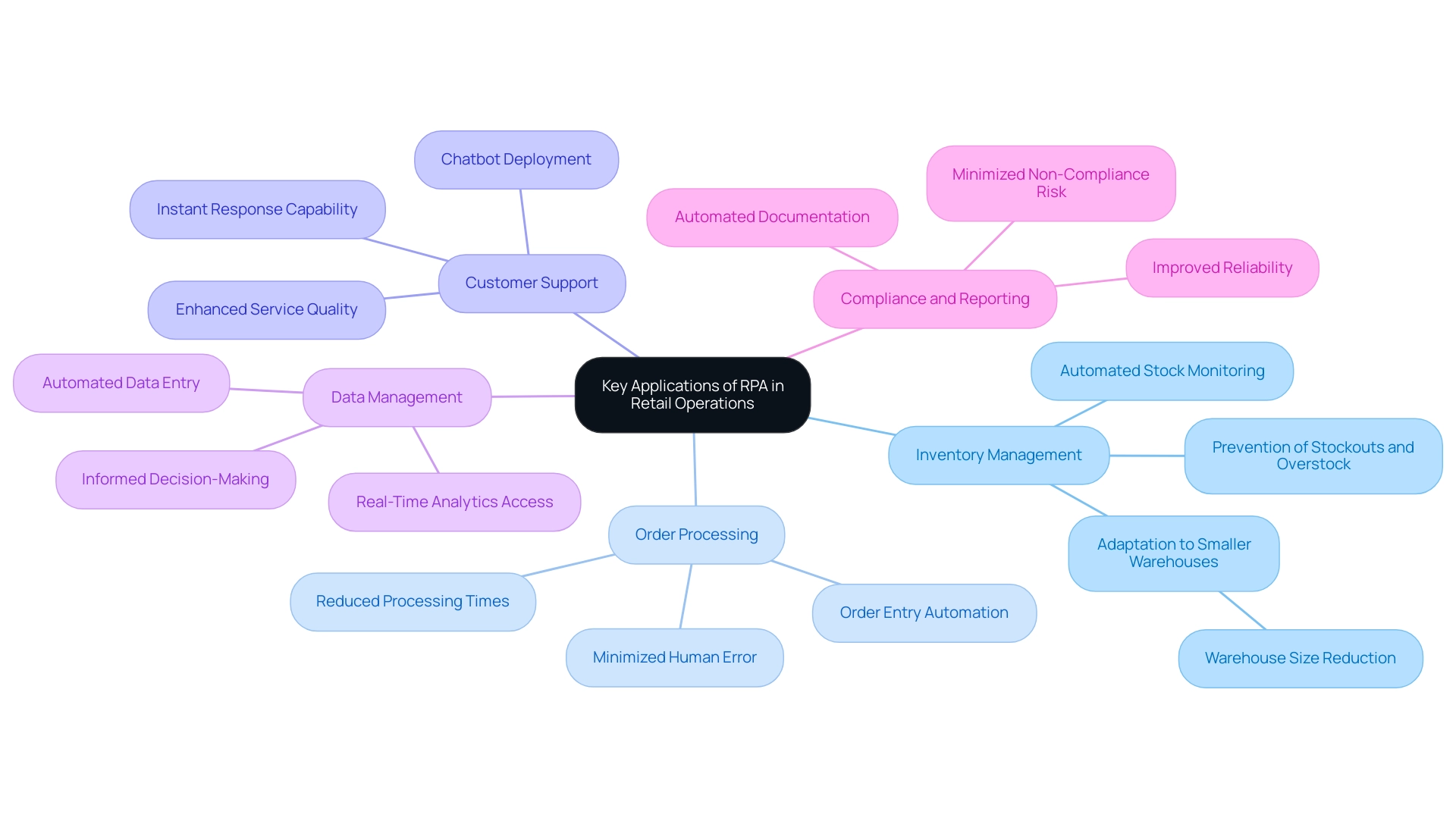
Transformative Effects of RPA on the Retail Landscape
The integration of RPA in retail activities goes beyond mere efficiency—it’s a powerful catalyst for transformation. By automating mundane tasks, businesses unlock a multitude of benefits that significantly enhance their operations:
- Enhance Customer Experience: RPA leads to faster processing times and greater accuracy, providing customers with a seamless shopping experience that boosts satisfaction and fosters loyalty. For example, RPA enables quicker turnaround times on quotes to clients, allowing human employees to concentrate on strategic activities.
- Drive Innovation: With RPA, businesses can explore new models and services without the constraints of manual processes, nurturing a culture of innovation that is essential in today’s competitive landscape. This adaptability is crucial in a rapidly evolving AI landscape where tailored AI solutions can help navigate challenges.
- Adapt to Market Changes: The agility afforded by RPA enables businesses to respond promptly to market dynamics, such as fluctuations in demand and disruptions in the supply chain, ensuring they remain relevant and responsive.
- Optimize Workforce Utilization: By utilizing RPA in retail to automate repetitive tasks, companies can reallocate human resources to more strategic roles, enhancing employee engagement and productivity, which ultimately drives better performance.
Furthermore, integrating tailored AI solutions and Business Intelligence with RPA can provide deeper insights and enhance decision-making capabilities. These transformative effects position RPA as a strategic asset in the changing marketplace. Alan Hester, President of Nividous, emphasizes that with over 30 years of experience in applying technology to solve real-world business problems, the role of RPA is pivotal.
He notes that the RPA market is projected to reach $50.50 billion globally by 2030, highlighting its growing importance in business. For instance, a case study from an eyecare practice illustrates this transformation: by automating claims processing, the practice saved skilled staff over 37,000 hours annually and reduced the claim-to-cash time by nine days. As RPA in retail continues to evolve, its significant impact on innovation metrics and customer experience is set to grow, making it essential for businesses aiming to thrive in 2024 and beyond.
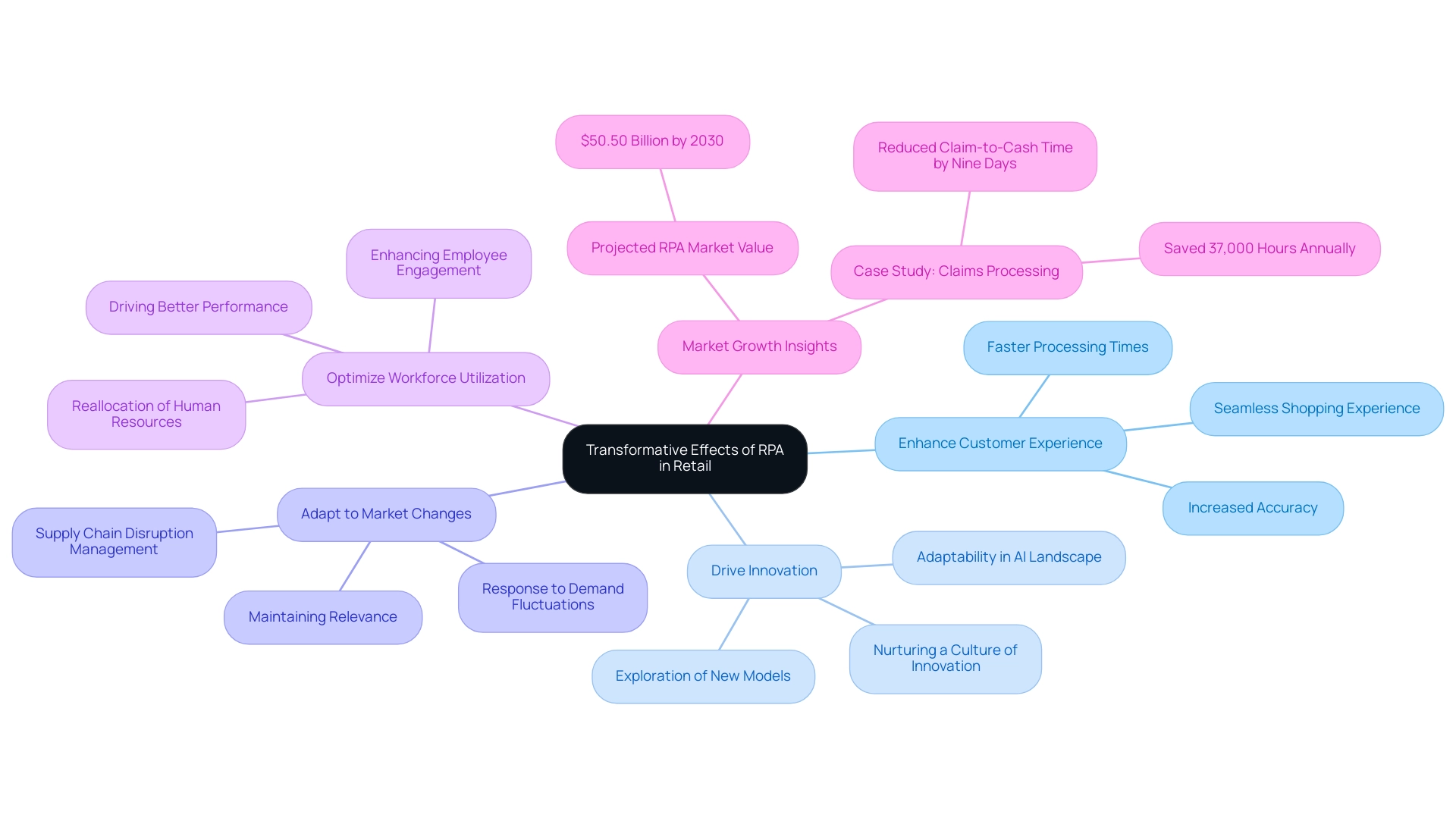
Benefits of Implementing RPA in Retail
The implementation of RPA in retail presents an array of transformative benefits, propelling organizations toward enhanced operational capabilities. Among the primary advantages are:
- Increased Efficiency: By automating repetitive tasks, retailers can achieve remarkable time savings, streamlining operations and enabling teams to focus on core business functions.
- Cost Reduction: RPA significantly minimizes the need for manual labor while reducing errors, contributing to lower operational expenses and improved profit margins. Retailers that have adopted RPA have reported substantial cost reductions, with reductions as high as 30% in operational costs.
- Enhanced Accuracy: With RPA, the likelihood of human error in data management is greatly diminished, ensuring superior accuracy in transactions and financial reporting.
- Scalability: Retailers can effortlessly adjust activities to meet fluctuating demand levels without the cumbersome task of workforce reconfiguration, ensuring agility in a fast-paced market.
- Improved Compliance: Automated processes maintain consistent adherence to compliance requirements, significantly lowering the risk of incurring penalties.
A pertinent example is seen in the case study titled “Return Processing Automation for a Large Distributor,” where a distributor faced significant challenges managing 5,000 returns per month, which tripled during the holiday season. After partnering with iNymbus to implement RPA, the distributor optimized their workforce, enhanced accuracy, improved employee morale, and became better prepared for peak season volumes.
These compelling benefits highlight how RPA in retail can transform activities, paving the way for sustained business success. In today’s data-rich environment, where extracting meaningful insights can be a challenge, RPA can play a crucial role in transforming raw data into actionable insights. However, as highlighted in the Global RPA Survey by Deloitte, scaling RPA remains a challenge, with only 3% of organizations successfully expanding their digital workforce:
“Yet scaling RPA is clearly proving more difficult than anticipated.”
This statistic serves as a motivation for retailers to adopt effective strategies that leverage RPA’s capabilities while avoiding common pitfalls, ultimately leading to enhanced operational efficiency and market competitiveness. Additionally, iNymbus provides automated solutions for suppliers to manage deductions seamlessly, enabling them to focus on essential business activities.
To learn more about how RPA in retail can enhance your operations and help you navigate the complexities of the rapidly evolving AI landscape, explore our tailored solutions.
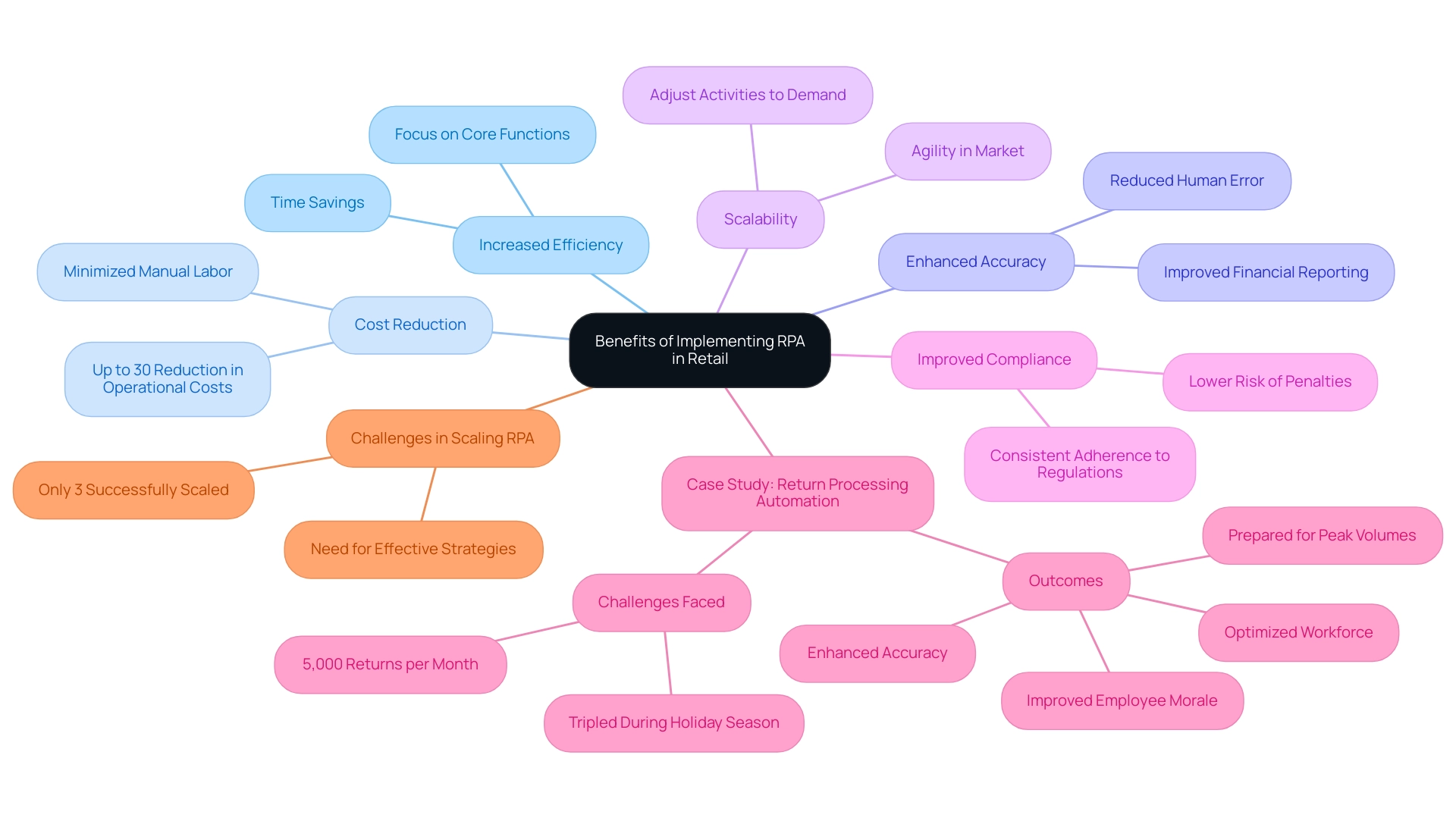
Challenges in Adopting RPA in Retail
While the advantages of Robotic Process Automation (RPA) are substantial, retailers often face specific challenges during its adoption, including:
-
Resistance to Change: Employees may express hesitance towards automation, driven by fears of job displacement. To combat this issue, effective change management and transparent communication are crucial. Engaging staff in the transition process can foster acceptance and alleviate concerns. Notably, nearly 70% of organizations report that RPA enables employees to have more human interactions, highlighting its potential to enhance rather than diminish employee roles.
-
Integration Complexity: The process of integrating RPA with existing systems can pose significant challenges, necessitating meticulous planning and execution. Retailers must ensure that their technological infrastructure is conducive to seamless automation, allowing for enhanced productivity and operational efficiency.
-
Initial Investment: The upfront costs of implementing RPA can deter some businesses. However, it’s important to recognize that the long-term savings and efficiency gains often justify this initial expenditure, especially with the implementation of RPA in retail, transforming it into a strategic investment. Furthermore, the implementation of RPA in retail can lead to significant cost reductions by minimizing manual labor and streamlining processes. This perspective aligns with the case study titled “RPA as a Tool for Empowerment,” which illustrates how RPA can serve as a mechanism for job creation and employee empowerment rather than a predictor of unemployment.
-
Skill Gaps: To maximize the benefits of RPA, businesses must address potential skill gaps by investing in training programs. Equipping employees with the necessary knowledge to work alongside RPA technologies ensures that teams can effectively leverage automation to enhance productivity and make informed decisions, supported by tailored AI solutions. Additionally, RPA provides valuable data-driven insights that can inform strategic decisions and optimize operations.
By recognizing these challenges and proactively addressing them, businesses can lay the groundwork for successful RPA in retail implementation. This approach not only boosts operational efficiency but also enhances overall competitiveness in a rapidly evolving market. As Guy Kirkwood aptly noted, “I ultimately believe that customer intimacy could become the only true differentiator in the future of business.”
By empowering employees through RPA, retailers can focus on fostering deeper connections with customers, thereby driving long-term success.

Conclusion
The integration of Robotic Process Automation (RPA) in retail operations offers a transformative approach to enhancing efficiency and achieving sustainable growth. By automating repetitive tasks such as:
- inventory management
- order processing
- customer support
retailers can significantly improve accuracy and speed, allowing human employees to concentrate on strategic initiatives that elevate customer experience. The successful implementation of RPA not only streamlines operations but also empowers organizations to adapt swiftly to market changes and consumer demands.
Despite its numerous benefits, adopting RPA comes with challenges, including:
- resistance to change
- integration complexities
However, by addressing these hurdles through effective change management and training, retailers can unlock the full potential of RPA, fostering an agile and responsive operational environment. The case studies highlighted throughout the article demonstrate that organizations that embrace RPA can achieve remarkable improvements in efficiency and accuracy, leading to enhanced customer satisfaction and loyalty.
In conclusion, RPA stands as a vital catalyst for innovation in the retail sector. As the industry continues to evolve, leveraging RPA will be essential for retailers looking to maintain a competitive edge and thrive in an increasingly digital landscape. The time to invest in RPA is now, as it not only addresses immediate operational challenges but also positions retailers for long-term success in the face of ongoing change.
Introduction
In the rapidly evolving landscape of business operations, organizations are increasingly turning to Robotic Process Automation (RPA) as a powerful tool to enhance efficiency and drive growth. By automating repetitive tasks, RPA not only liberates employees from mundane duties but also integrates seamlessly with existing systems, paving the way for smoother workflows.
As companies strive to stay competitive, understanding the key concepts and functionalities of RPA becomes essential. This article delves into the transformative potential of RPA, exploring its applications across various sectors, the challenges organizations may face during implementation, and practical strategies for building a scalable RPA framework.
With a focus on continuous improvement and innovation, businesses can harness RPA to unlock new levels of productivity and operational excellence.
Understanding Robotic Process Automation (RPA): Key Concepts and Functionality
Robotic Process Automation (RPA) is a groundbreaking technology that allows entities to set up software, or ‘robots’, to mimic human actions within digital systems, thereby carrying out business workflows efficiently. Understanding the core concepts of RPA strategy is essential for crafting a strategic approach that aligns with your organizational goals:
-
Automation of Repetitive Tasks: A primary advantage of RPA is its ability to automate mundane tasks such as data entry, processing transactions, and managing records. This liberation from time-consuming duties not only minimizes errors but significantly enhances productivity, allowing your team to focus on more strategic initiatives.
-
Integration with Existing Systems: RPA tools like EMMA RPA and Microsoft Power Automate seamlessly operate across various applications and systems without necessitating extensive coding or modifications, facilitating smoother workflows and quicker implementations. This is crucial for overcoming the challenges posed by outdated systems and ensuring that your entity remains agile and innovative.
-
User Interface Interaction: RPA robots are designed to mimic user actions, allowing them to interact with applications just as a human would. This capability ensures a seamless workflow, preserving the integrity of existing methods while optimizing efficiency.
-
Overcoming Technology Implementation Challenges: Implementing RPA can address common challenges such as resistance to change and integration with legacy systems. By offering targeted training and support, companies can ensure a smoother transition and better acceptance among employees.
-
ROI and Risk Management: Investing in RPA solutions not only leads to significant cost savings through enhanced efficiency but also mitigates risks associated with manual errors. By calculating potential time savings and enhancements, companies can better understand the ROI of their RPA initiatives. Furthermore, small and medium-sized enterprises (SMEs) are projected to adopt RPA solutions at a growth rate of 25% annually, underscoring the increasing relevance of this technology in the sector. For instance, integrating RPA into appointment scheduling can lower no-show rates, which vary between 5% and 39%, demonstrating a tangible benefit of automation. Additionally, BPO companies in sales and marketing utilize RPA for lead generation and campaign management, enabling teams to concentrate on customer engagement and ultimately leading to higher conversion rates. Grasping these key concepts is imperative for developing a robust RPA strategy that addresses immediate operational needs while positioning your organization for future growth.

Leveraging RPA: Use Cases and Benefits for Effective Strategy Development
RPA can be utilized across diverse sectors and workflows. Some notable use cases include:
- Finance and Accounting: Automating invoice handling and reconciliation tasks to minimize human error and expedite workflows.
- Customer Service: Implementing chatbots and automated responses to manage common inquiries, allowing human agents to focus on complex issues.
- Human Resources: Streamlining employee onboarding activities by automating document collection and verification.
In particular, a recent case study highlights how a mid-sized healthcare company tackled challenges such as manual data entry errors, slow software testing, and the difficulty of integrating outdated systems without APIs by implementing GUI automation. This solution, as part of our RPA strategy, resulted in a remarkable 70% reduction in data entry errors, a 50% acceleration in testing processes, and improved workflow efficiency by 80%, achieving a return on investment within just 6 months. The benefits of adopting RPA, in line with our RPA strategy, include:
- Increased operational efficiency and productivity.
- Reduced costs associated with manual processes.
- Enhanced accuracy and compliance in data handling.
- Greater employee satisfaction as teams can focus on more strategic tasks.
By leveraging tailored AI solutions alongside an RPA strategy, entities can unlock the full potential of their data and drive informed decision-making, further enhancing productivity in a rapidly evolving landscape.
The transformative impact of GUI automation on healthcare service delivery is evident, showcasing how technology can revolutionize operations and improve service quality.
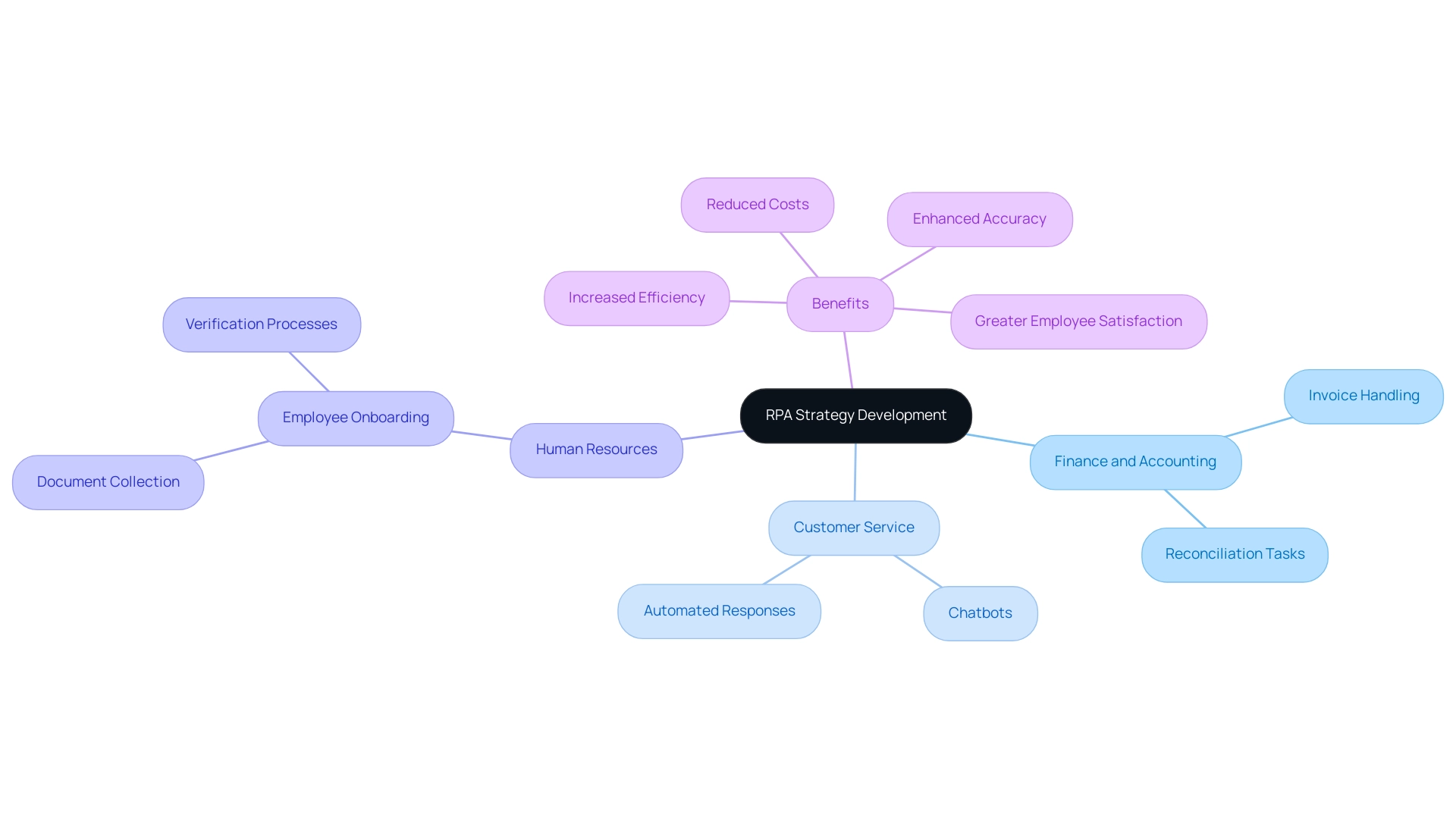
Navigating Challenges in RPA Implementation: Strategies for Success
While the advantages of an RPA strategy are substantial, organizations often encounter hurdles during implementation that can impede progress. For instance, a direct-to-consumer retailer is grappling with operational efficiency due to outdated automation systems, highlighting a common challenge in the industry. Key challenges include:
-
Resistance to Change: Employees may exhibit reluctance towards adopting new technologies.
To combat this, it is essential to effectively communicate the benefits of the RPA strategy and actively involve staff in the transition, fostering a sense of ownership and understanding. -
Integration Issues: Ensuring RPA tools integrate seamlessly with existing systems is vital. To mitigate this risk, conduct thorough testing of the selected RPA solutions and prioritize tools known for their integration capabilities.
-
Lack of Clear Objectives: Without well-defined goals, RPA initiatives can stall. Establishing clear Key Performance Indicators (KPIs) and objectives is essential to guide the implementation activities of the RPA strategy and measure its success.
To enhance the likelihood of successful RPA integration and operational efficiency, consider the following approaches:
- Engage stakeholders from the outset to cultivate buy-in and support across the organization.
- Provide comprehensive training programs that equip staff with the skills necessary to work alongside RPA technologies effectively.
- Regularly review and adjust implementation techniques based on feedback and performance metrics to ensure continuous improvement and alignment with organizational goals.
A case study titled ‘Robotic Process Automation Approach for D2C Retail in Competitive Market’ illustrates how a direct-to-consumer retailer improved customer experience and reduced operational costs through an effective RPA strategy. This underscores the potential benefits of overcoming implementation challenges and highlights the importance of an RPA strategy in driving efficiency in today’s rapidly evolving AI landscape. Moreover, by implementing an RPA strategy to automate repetitive tasks, it alleviates the burden on employees, leading to improved morale and productivity. Furthermore, combining Business Intelligence with RPA can improve decision-making activities, allowing organizations to utilize data-driven insights for growth and innovation.

Starting Small: Building a Scalable RPA Strategy
To develop a scalable RPA strategy that effectively addresses workplace challenges and enhances productivity, follow these essential steps.
- Identify Quick Wins:
Start by targeting activities characterized by high volume, repetition, and clear rules. For example, automating data entry tasks within your finance department can lead to immediate and significant benefits, streamlining operations and freeing up valuable resources.
Organizations implementing RPA have reported time savings of up to 30% in these tasks, significantly improving employee morale and productivity. Additionally, by alleviating repetitive workloads, RPA can help attract and retain talent, as employees are more likely to stay in roles that allow them to focus on strategic tasks rather than mundane ones.
- Pilot Projects:
Launch RPA initiatives within a controlled environment using a small, dedicated team.
This approach allows for testing and refining processes before broader implementation, minimizing risks and setting the stage for successful expansions. As shown in the North Sea’s cross-border CCUS collaboration, a focused pilot can lead to effective execution and improved talent retention by alleviating workload stress. Moreover, these pilot projects can serve as a model for modernizing outdated systems that hinder operational efficiency.
-
Measure Success:
Tracking key performance metrics such as time savings, error reduction, and employee satisfaction is crucial. These indicators provide a comprehensive view of the pilot project’s impact and effectiveness. Industry experts emphasize that measuring these metrics helps organizations enhance their approaches and demonstrate the value of their RPA strategy in overcoming technology implementation challenges, including staffing shortages and system inefficiencies. -
Gather Feedback:
Engage directly with users involved in the pilot projects to collect insights and feedback. Understanding their experiences highlights areas for improvement and fosters a culture of continuous refinement within your RPA initiatives. Expert opinions accentuate the importance of user feedback in driving successful automation strategies, ensuring that the solutions remain aligned with team needs and help address outdated processes. -
Scale Gradually:
Once initial pilot projects yield positive results, systematically expand RPA to other processes and departments. A measured approach to scaling ensures that lessons learned are applied, enhancing the overall impact of automation throughout the entity. By referencing successful collaborative efforts, such as those in the North Sea, entities can draw parallels and implement best practices to enhance their RPA approaches.
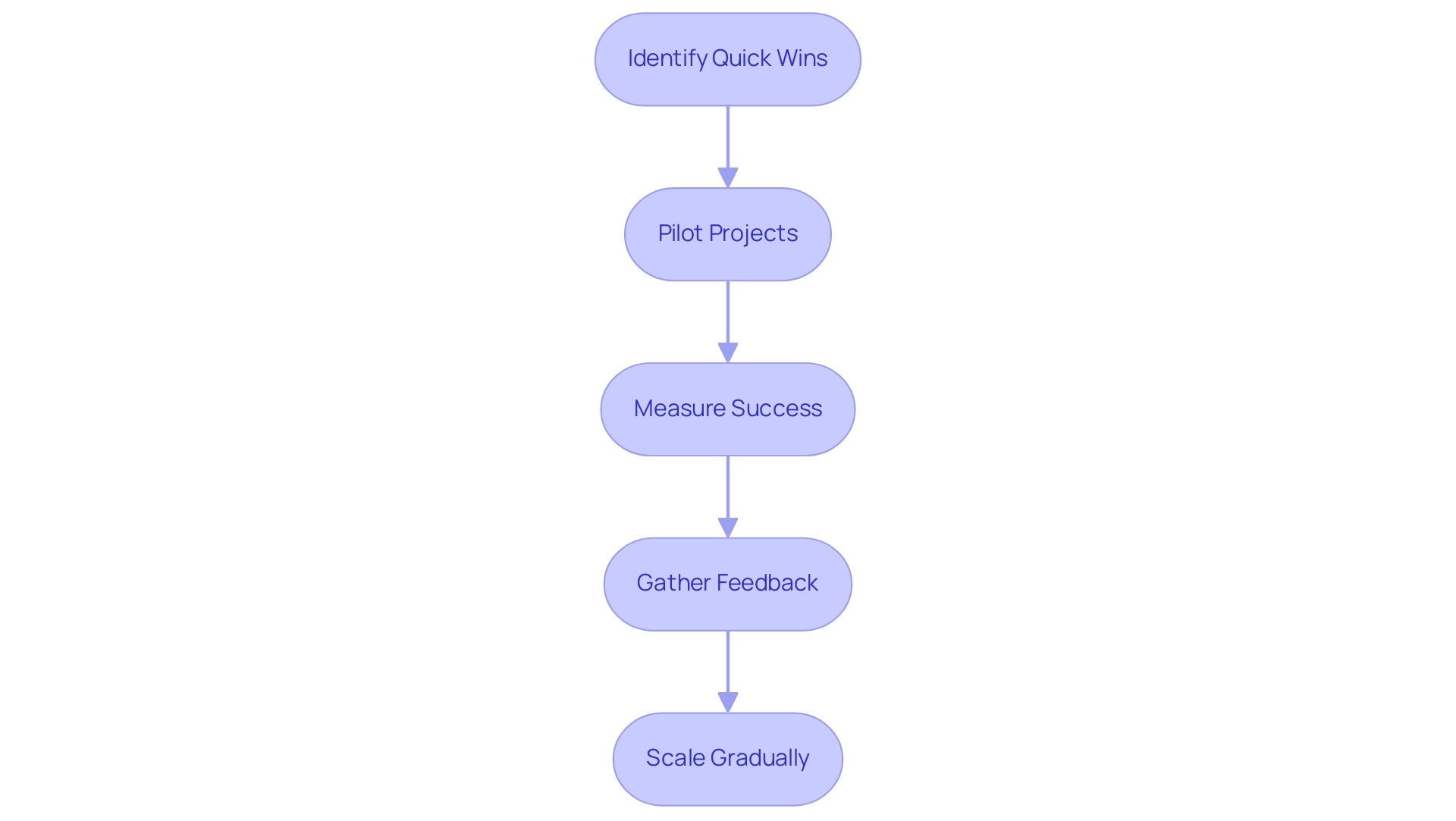
Future-Proofing Your RPA Strategy: Continuous Improvement and Adaptation
To effectively future-proof your RPA strategy, it is essential to continuously monitor industry trends and advancements in RPA technologies. Staying updated allows you to identify new opportunities for enhancement and ensures your entity remains competitive in a rapidly evolving landscape. Recent events scheduled from September 12-14, 2023, highlighted key advancements in RPA that can inform your RPA strategy.
- Invest in Training: Prioritize regular training sessions for your staff focused on the latest tools and best practices related to your RPA strategy.
Empowering your team with knowledge enhances their ability to leverage new capabilities, ultimately leading to better implementation and utilization of RPA solutions. This training is crucial for a successful RPA strategy, as it equips employees with the skills necessary to adapt to evolving technologies.
-
Encourage Innovation: Cultivate a culture of innovation within your establishment. Encourage teams to explore and experiment with new applications of RPA, fostering an environment where creative solutions can flourish. This proactive approach can lead to unique efficiencies and applications that align with your RPA strategy, ensuring that you effectively review and optimize your RPA initiatives. Periodically reviewing performance metrics allows you to make necessary adjustments to your RPA strategy, optimizing processes and effectively addressing any emerging challenges. These technologies can enhance decision-making by providing insights that drive efficiency and innovation, aligning with your specific business goals.
-
Transform Data into Insights: Utilize RPA to extract meaningful insights from your data, enabling informed decision-making. This capability is crucial for sustaining a competitive advantage in today’s data-abundant landscape.
By focusing on ongoing enhancement and merging RPA with customized AI solutions and Business Intelligence, organizations can ensure their RPA strategy aligns with current business objectives and remains flexible to future requirements. As Kim Collins aptly stated, ‘Strive for continuous improvement, instead of perfection.’ This mindset is crucial as industries evolve and expectations shift.
Drawing from the example of Waste Management, where Thomas A. Edison noted that waste is more detrimental than loss, focusing on minimizing waste directly relates to an RPA strategy by enhancing efficiency and resource management, ultimately leading to improved operational outcomes.

Conclusion
Robotic Process Automation (RPA) stands as a transformative force in modern business operations, offering organizations the capability to streamline workflows, enhance productivity, and drive significant cost savings. By automating repetitive tasks, RPA not only minimizes errors but also allows employees to redirect their efforts toward more strategic initiatives that contribute to overall growth. The seamless integration of RPA tools with existing systems ensures that businesses can adapt quickly to changing demands, thereby maintaining a competitive edge in their respective industries.
While the advantages of RPA are compelling, successful implementation requires a strategic approach. Organizations must navigate challenges such as:
- Resistance to change
- Integration issues
By fostering a culture of buy-in and providing comprehensive training, establishing clear objectives, and measuring success through defined key performance indicators, organizations can guide the implementation process and ensure long-term effectiveness.
Starting small with pilot projects can yield immediate benefits, paving the way for scalable RPA strategies that address workplace challenges. By systematically expanding automation initiatives and focusing on continuous improvement, businesses can not only enhance operational efficiency but also empower their workforce to thrive in a technology-driven environment. The integration of tailored AI solutions further amplifies the potential of RPA, enabling organizations to extract valuable insights and make informed decisions that propel them toward future success.
In conclusion, embracing RPA is not merely a trend; it is a strategic imperative for organizations aiming to achieve operational excellence. By prioritizing innovation, investing in training, and cultivating a culture of adaptability, businesses can unlock the full potential of RPA, ensuring they are well-positioned to meet the demands of an ever-evolving landscape.
Introduction
In the fast-evolving landscape of technology, Robotic Process Automation (RPA) is emerging as a game-changer for organizations seeking to enhance their operational efficiency, particularly in test automation. By harnessing the power of software robots, businesses can streamline repetitive tasks, reduce human error, and accelerate testing cycles, ultimately leading to faster product releases and improved quality assurance.
As companies navigate the complexities of integrating RPA into their existing frameworks, understanding the transformative benefits, potential challenges, and best practices becomes essential. This article delves into the multifaceted world of RPA in test automation, showcasing its strategic advantages and offering insights into future trends that will shape the industry’s trajectory.
Introduction to RPA in Test Automation
Robotic Process Automation (RPA) is transforming how entities tackle repetitive and rule-based tasks by utilizing software robots, frequently called ‘bots.’ In a rapidly evolving AI landscape, RPA is not just a tool for efficiency; it is a strategic asset that enables organizations to streamline manual workflows effectively. For instance, a recent case study emphasized how a mid-sized company encountered challenges such as manual data entry errors and sluggish software evaluation, which hindered their operational efficiency.
By automating data entry, software evaluation, and legacy system integration through GUI automation, the company addressed these issues, leading to a remarkable 70% reduction in errors and an 80% improvement in workflow efficiency within just six months.
In the context of test automation, RPA for test automation significantly reduces manual effort and enhances overall operational efficiency. By using RPA for test automation to automate essential tasks such as:
- Data entry
- Test case execution
- Result verification
Businesses can dramatically accelerate their evaluation cycles. This shift not only facilitates quicker time-to-market for software products but also empowers teams to focus on more complex testing scenarios that require human insight.
As businesses increasingly recognize the importance of data-driven decision-making, the integration of Business Intelligence tools alongside RPA becomes imperative.
Unlocking actionable insights from raw data not only drives growth but also positions entities competitively in their industries. Moreover, tailored AI solutions can assist in identifying the right technologies that align with specific business needs. With 66% of organizations already experimenting with process mechanization and 91% planning to increase investments in the next 24 months, the commitment to RPA adoption is clear.
Advancements such as AI-powered testing and continuous monitoring promise to further enhance the effectiveness and reliability of RPA solutions, ensuring adaptability to evolving business requirements.
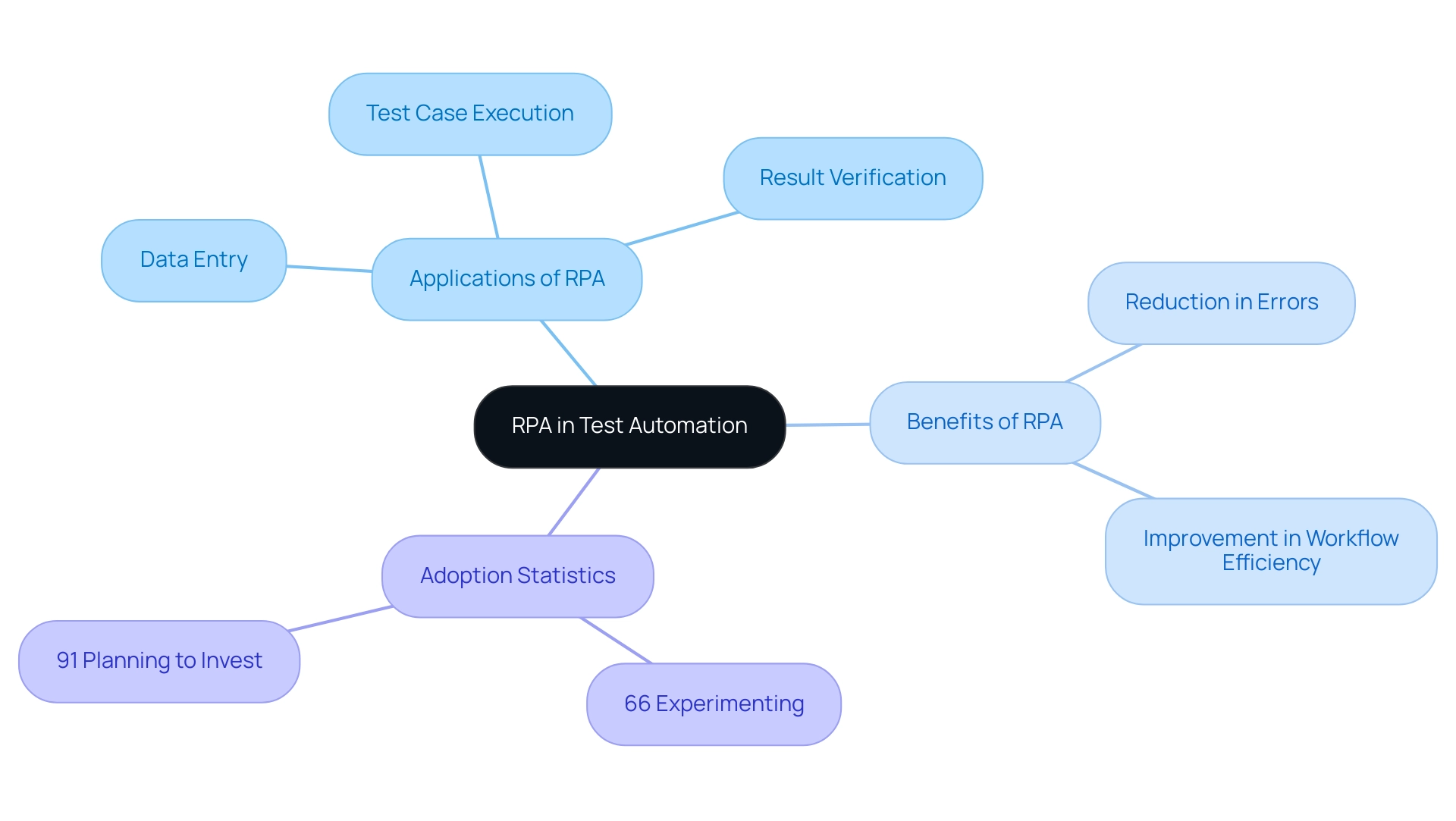
Key Benefits of RPA for Test Automation
Implementing Robotic Process Automation (RPA) in test automation presents a range of transformative benefits that can significantly enhance operational efficiency:
-
Increased Efficiency: Automating repetitive tasks allows entities to accelerate test execution, enabling a greater number of tests to be conducted within shorter time frames. This shift results in faster feedback cycles, which is critical for agile development practices. Notably, the heaviest processes took only 9 weeks to automate, showcasing the rapid deployment capabilities of RPA. By utilizing innovative tools like EMMA RPA and Microsoft Power Automate, which are examples of RPA for test automation, companies can further streamline operations and reduce the burden of task repetition fatigue, addressing one of the key challenges faced by many teams.
-
Enhanced Accuracy: One of the standout advantages of RPA is its ability to minimize human error. By consistently executing tests with precision, RPA helps maintain the high-quality standards essential in software development. According to recent studies, automated evaluation can achieve accuracy rates significantly higher than manual methods, making it a reliable solution for quality assurance. This precision not only enhances employee morale but also fosters a culture of excellence within the company.
-
Cost-Effectiveness: By decreasing dependence on extensive manual evaluation resources, RPA leads to notable cost savings. Organizations can allocate these resources to more strategic initiatives, thereby optimizing their operational budget. Users have reported that transitioning to solutions like Automation Anywhere not only lowers initial costs but also enhances cognitive capabilities, making it a preferred choice over competitors like UiPath and Blue Prism. As Gajanan S., a Software Engineer at OMFYS Technologies India Pvt. Ltd., stated, “Before using Automation Anywhere I checked Blue Prism & UI Path but I preferred Automation Anywhere because it is best in quality. It also has Document Automation for unstructured data converting in structure.”
-
Scalability: RPA empowers organizations to scale their testing efforts seamlessly. As workloads grow, teams can modify their strategies without a corresponding increase in resource needs, offering essential flexibility in the fast-paced software environment.
-
Improved Test Coverage: The capacity to automate a larger number of test cases—including regression tests—enhances overall test coverage. This comprehensive approach ensures that more scenarios are validated prior to release, thereby reducing the risk of defects in production. The case study titled “Comparison of Automation Solutions” highlights how users compared Automation Anywhere with other RPA solutions, emphasizing its superior cognitive abilities and cost-effectiveness.
In conclusion, the use of RPA for test automation in test procedures not only streamlines processes but also delivers substantial benefits that foster improved operational efficiency and elevate software quality. With the current advancements in RPA technologies like EMMA RPA and Power Automate, businesses are well-positioned to leverage these tools to enhance their testing frameworks into 2024 and beyond. Moreover, the integration of robotics in the workplace, as illustrated by the friendly robotic figures collaborating with human operators, symbolizes the potential for overcoming outdated systems and enhancing productivity.
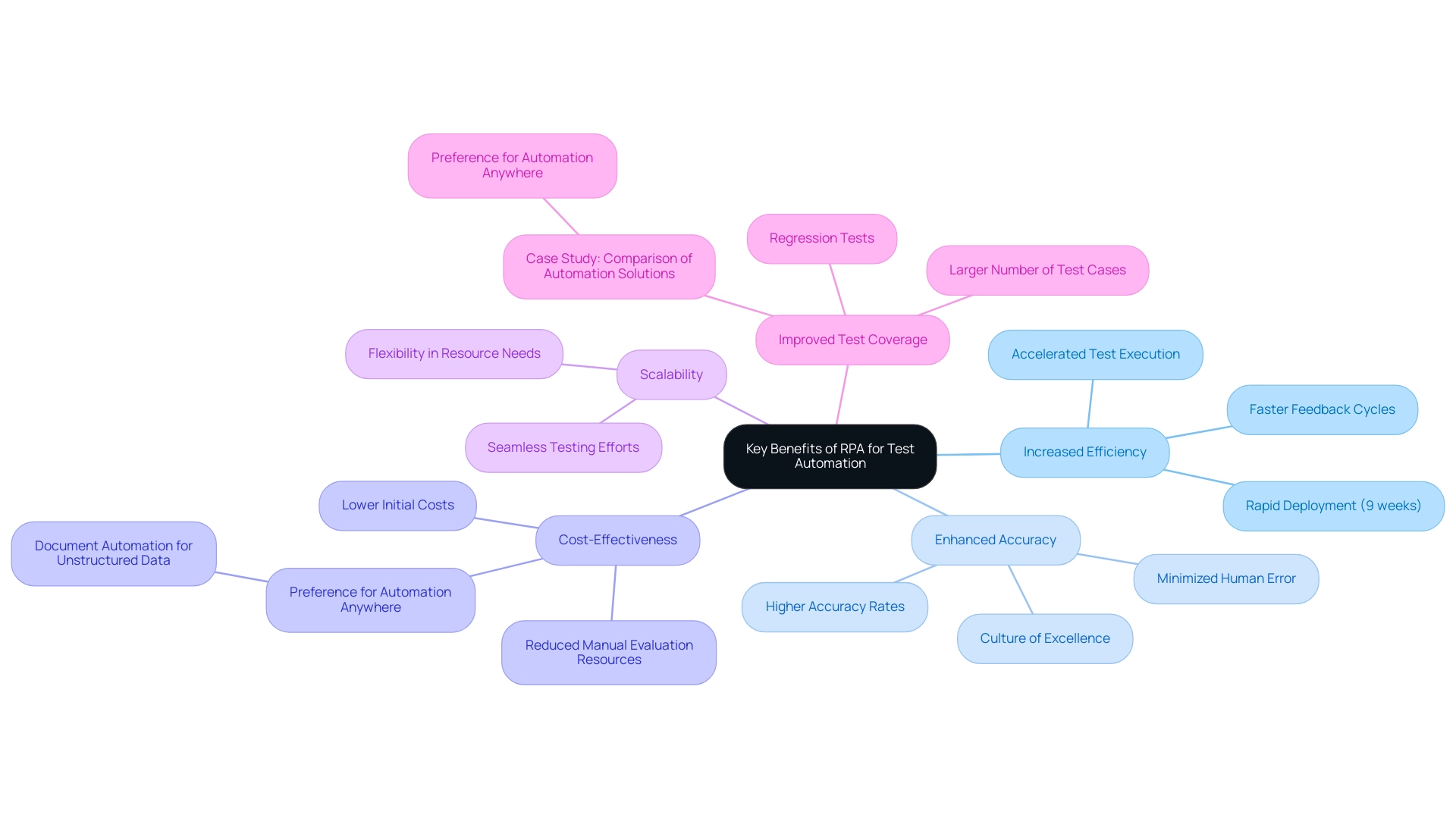
Challenges of Implementing RPA in Test Automation
While Robotic Process Automation (RPA) presents substantial advantages for testing, organizations often face several hurdles during its implementation:
-
Initial Cost and Investment: The journey towards RPA can demand a significant initial outlay for technology and training. Organizations must carefully evaluate these upfront costs against the long-term advantages that mechanization can provide, such as boosting efficiency and reducing errors. With SMEs projected to adopt RPA solutions at a growth rate of 25% annually, the urgency to navigate these costs effectively is paramount.
-
Resistance to Change: Employee resistance is a common barrier to RPA adoption, often stemming from fears of job loss or discomfort with unfamiliar technologies. Addressing these concerns with effective change management strategies is crucial to cultivate acceptance and cooperation among staff, ensuring that RPA does not just streamline workflows but also enhances employee morale.
-
Complexity of Implementation: The integration of RPA into existing evaluation frameworks can be intricate. Organizations need to ensure compatibility with their current systems and establish a robust infrastructure to support automation effectively. The global RPA market is projected to grow at a CAGR of 27.7% from 2023 to 2028, highlighting the critical nature of overcoming these complexities.
-
Maintenance and Updates: RPA bots necessitate ongoing maintenance to keep pace with changes in software applications and testing processes. It’s essential for entities to allocate resources for continuous monitoring and updates, ensuring optimal performance over time.
-
Skill Gaps: The shortage of qualified personnel capable of managing and operating RPA tools can impede progress. Investing in training and development is essential for optimizing the advantages gained from RPA.
By proactively tackling these challenges, including the incorporation of customized AI solutions and Business Intelligence, companies can create a clear plan for successful RPA execution in their testing efforts. This strategic approach not only mitigates risks but also enhances the overall effectiveness of initiatives, allowing teams to focus on more strategic, value-adding work while overcoming issues related to outdated systems.
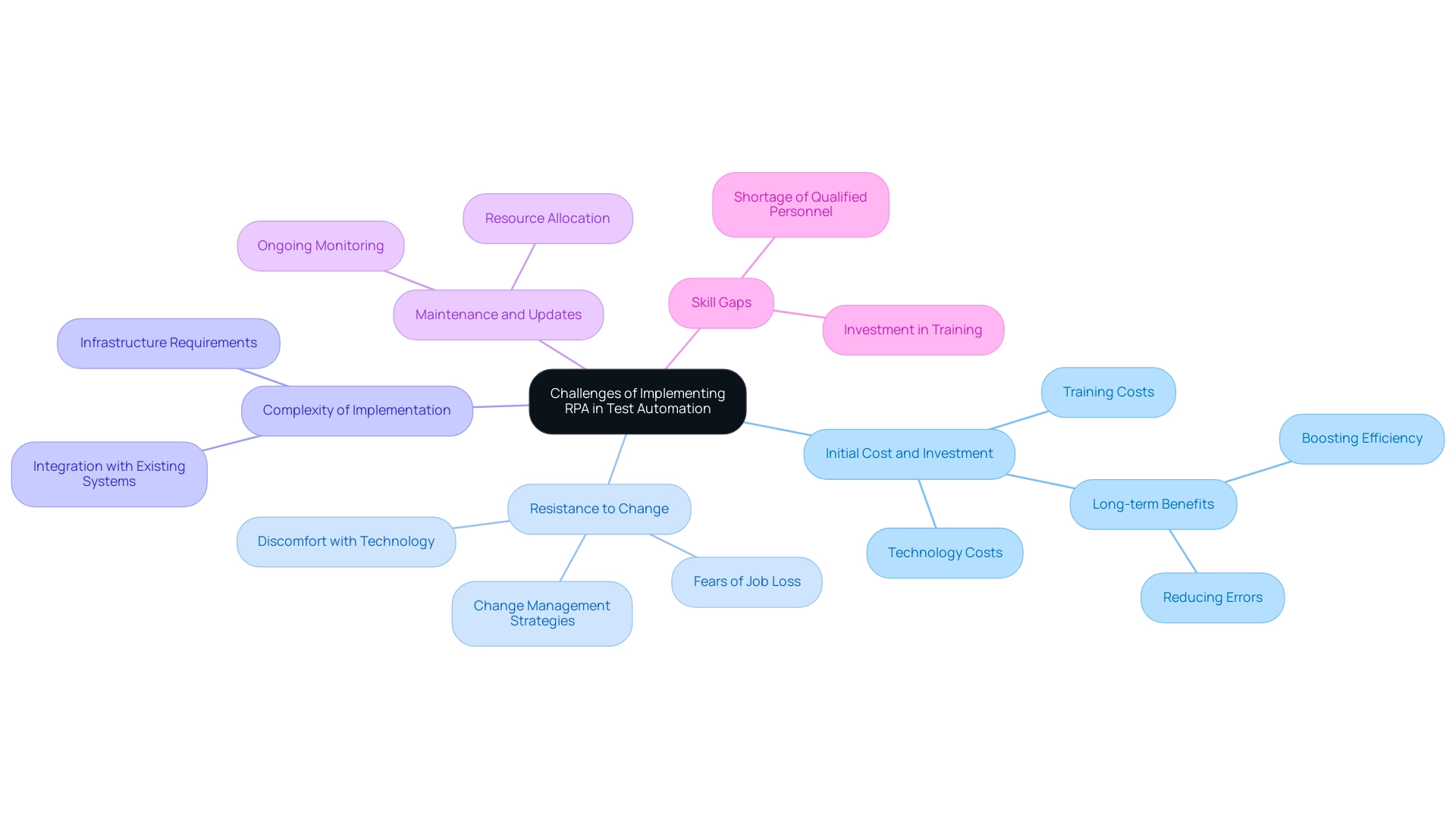
Best Practices for RPA Implementation in Test Automation
To achieve a successful implementation of Robotic Process Automation (RPA) in test automation, organizations should adhere to the following best practices:
-
Conduct a Thorough Assessment: Begin with a comprehensive evaluation of your current testing processes. Identifying specific areas where mechanization can deliver substantial value is critical for maximizing the return on investment in RPA. Significantly, 53% of participants have already begun their RPA journey according to the Deloitte Global RPA survey, emphasizing the increasing trend toward mechanization.
-
Start Small and Scale Up: Pilot projects are invaluable for evaluating RPA for test automation’s effectiveness in targeted areas. These initial implementations allow organizations to refine their strategies before a broader rollout, enhancing the likelihood of success. Insights from the case study titled “Demystifying RPA Evaluation” reveal that various assessment approaches, including functional and end-to-end evaluation, can significantly enhance the performance and reliability of RPA solutions.
-
Engage Stakeholders: Actively involve key stakeholders—testers, developers, and management—from the outset. Their insights are essential to ensure that RPA initiatives align with organizational goals and effectively address real-world challenges. Early detection and resolution of issues during testing are crucial, as they enhance overall performance and maximize ROI from RPA investments.
-
Invest in Training: Comprehensive training on RPA tools and methodologies is crucial. Equipping employees with the necessary skills alleviates apprehensions, fosters confidence, and empowers teams to utilize RPA effectively.
-
Monitor and Optimize: Ongoing monitoring of RPA bot performance is vital. Gathering user feedback and performance data can inform continuous optimization efforts, leading to enhanced efficiency and effectiveness.
-
Leverage Tailored AI Solutions: Incorporating tailored AI solutions can help entities in identifying the right technologies that align with their specific business needs, further enhancing the effectiveness of RPA initiatives.
-
Utilize Data-Driven Insights: Emphasizing data-driven decision-making can assist entities in extracting meaningful insights from their automated processes, driving growth and innovation.
By applying these best practices, organizations can significantly enhance their chances of successful integration of RPA for test automation in testing. As noted by Poonam Bhardwaj,
Test frameworks are reusable structures that provide an organized approach to designing, executing, and managing your RPA test cases.
Such frameworks, alongside insightful strategies, are essential for cultivating a robust testing environment that maximizes the benefits of RPA investments.
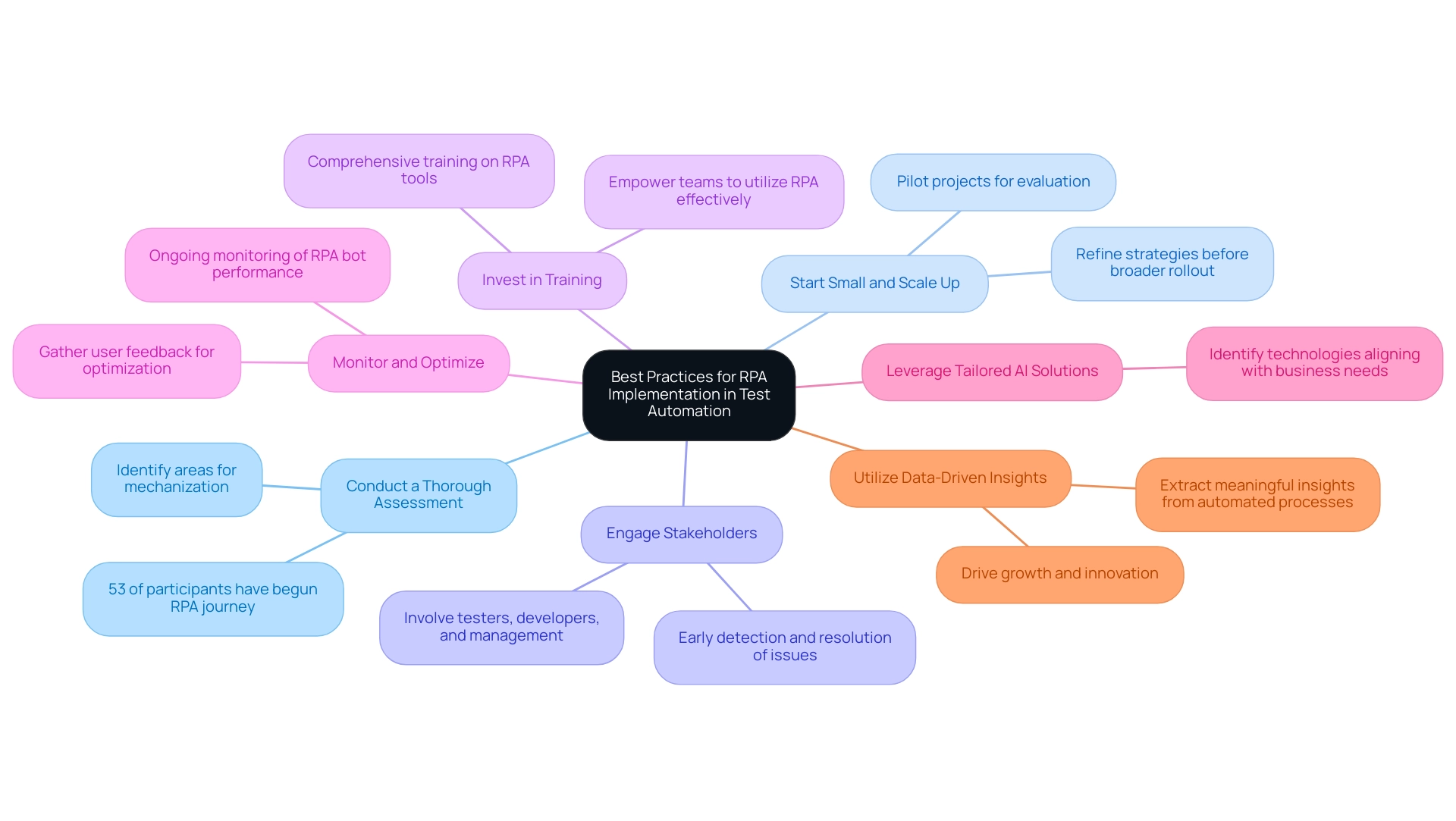
Future Trends in RPA and Test Automation
The landscape of test automation is rapidly evolving, bringing forward several key trends that will shape the future of RPA:
-
Integration with AI and Machine Learning: A significant shift is occurring as RPA merges with AI and machine learning technologies. This integration enables intelligent mechanization capable of adapting to dynamic environments, ultimately enhancing decision-making processes. As Kumarpal Nagar, Python team lead at MindInventory, states, “With my passion for always being up-to-date with AI/ML advancements and experimenting with AI/ML, I have set up a proven track record of success in helping organizations leverage the power of AI/ML to drive meaningful results and create value for their customers.”
-
Cognitive Automation: The advancement towards cognitive automation indicates that future RPA systems will not only perform tasks but will also learn from data patterns. This capability allows bots to make informed decisions, significantly improving the evaluation process and its overall effectiveness.
-
Increased Focus on Security: As organizations embrace RPA, there is an escalating focus on implementing robust security measures. Protecting sensitive data and ensuring compliance with regulatory standards will be critical as the adoption of RPA becomes more widespread.
-
Collaboration with DevOps: The synergy between RPA and DevOps practices is anticipated to strengthen, driving continuous evaluation and delivery. This collaboration is vital for agile development methodologies, ensuring that automation keeps pace with rapid deployment cycles.
-
Greater User Accessibility: Future RPA tools are set to become increasingly user-friendly, empowering non-technical users to automate testing processes without needing extensive programming expertise. This democratization of technology will facilitate broader adoption across various organizational levels.
These trends underscore the critical role of RPA for test automation in addressing challenges related to poor master data quality and the general apprehension surrounding AI adoption. By leveraging tailored AI solutions and Business Intelligence, companies can enhance productivity and informed decision-making, turning perceived complexities into competitive advantages. Moreover, utilizing RPA for test automation significantly contributes to increasing productivity and reducing operational costs, making it an essential strategy for businesses aiming to optimize their processes.
The importance of these trends is highlighted by the statistic that 64.2% of respondents use Selenium for testing, making it the top choice. This reflects its flexibility and browser compatibility, as highlighted in the case study titled “Selenium as the Top Choice for Test Automation.” By remaining attuned to these trends, organizations can strategically position themselves for the future of test automation, leveraging RPA for test automation not just as a tool, but as a competitive advantage in their operational efficiency.
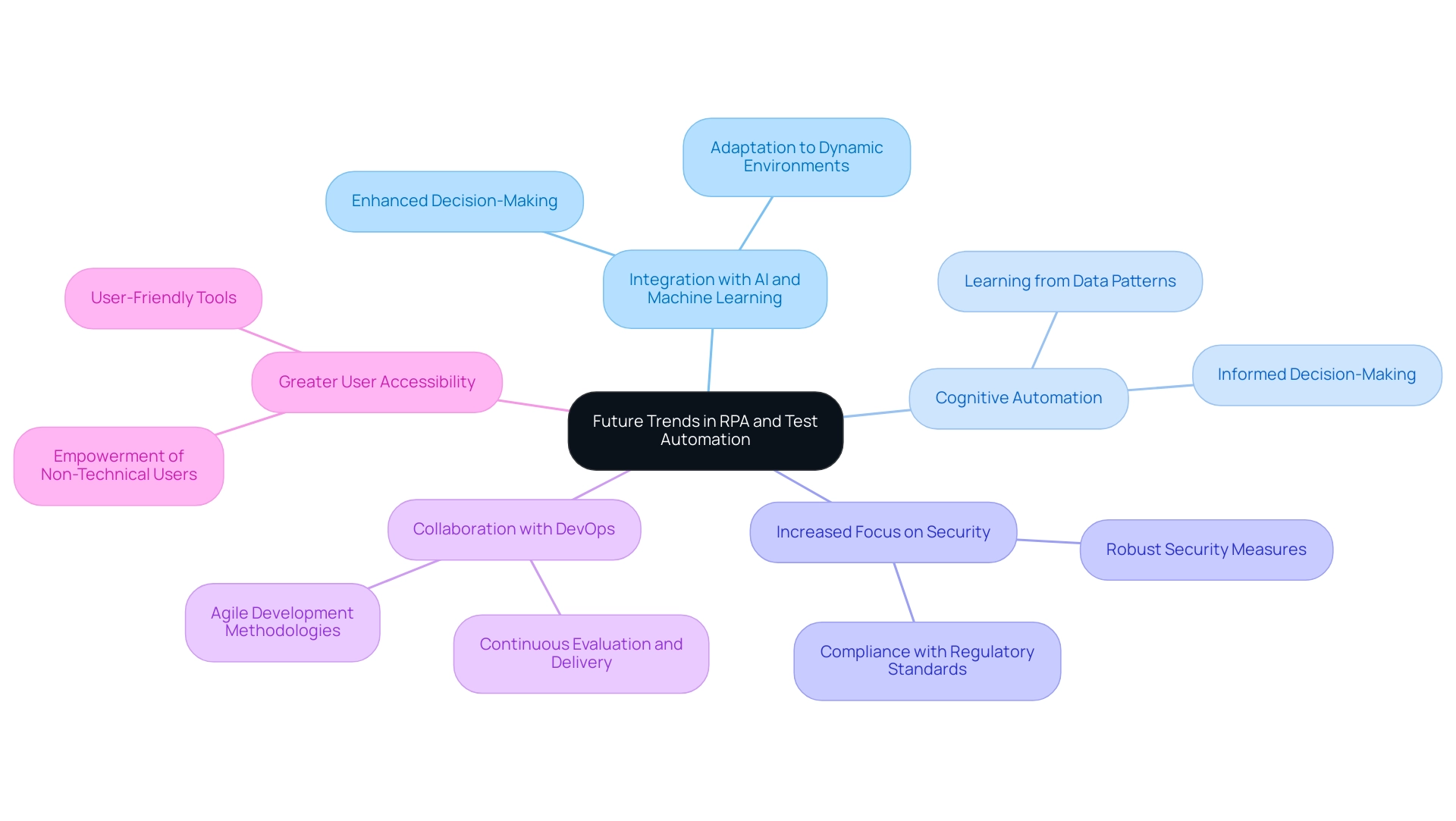
Conclusion
Integrating Robotic Process Automation (RPA) into test automation is a transformative step for organizations aiming to enhance operational efficiency. The advantages of RPA are clear:
- Increased efficiency
- Enhanced accuracy
- Cost-effectiveness
- Scalability
- Improved test coverage
By automating repetitive and rule-based tasks, businesses can significantly reduce errors and accelerate testing cycles, allowing teams to focus on more complex challenges that add value.
However, successful implementation of RPA is not without its challenges. Organizations must navigate:
- Initial costs
- Resistance to change
- Complexities of integration
Addressing these challenges through strategic planning, stakeholder engagement, and comprehensive training is essential for maximizing the benefits of RPA. By adopting best practices and leveraging tailored AI solutions, companies can build a robust framework that supports their automation initiatives.
Looking ahead, the future of RPA in test automation is poised for exciting developments. The integration of AI and machine learning will drive intelligent automation, while increased focus on security and collaboration with DevOps will ensure that organizations can adapt to evolving demands. By staying attuned to these trends, businesses can harness the full potential of RPA as a strategic asset, positioning themselves for success in a competitive landscape. Embracing RPA is not just about automation; it’s about unlocking new opportunities for growth, efficiency, and innovation.
Introduction
In the rapidly evolving landscape of automation, organizations are increasingly recognizing the necessity of a robust governance framework for Robotic Process Automation (RPA). As businesses strive to enhance operational efficiency and adapt to new technological advancements, establishing clear roles, responsibilities, and processes becomes paramount.
This article delves into the critical components of effective RPA governance, including:
– The creation of a Center of Excellence
– The importance of auditability
– The implementation of performance monitoring systems
By embracing these strategies, organizations can not only streamline their automation initiatives but also foster a culture of continuous improvement and innovation, ultimately positioning themselves for success in an increasingly competitive environment.
Establishing a Robust Enterprise Framework for RPA Governance
To effectively manage RPA initiatives, entities should implement a comprehensive enterprise oversight framework that outlines the roles, responsibilities, and processes essential for RPA governance. This framework must encompass clear guidelines for project selection, risk management, and adherence to regulatory compliance. A centralized management model is essential, as it ensures that all RPA projects align with the entity’s strategic objectives, ultimately enhancing operational efficiency and productivity.
This approach not only helps manage stakeholder expectations but also promotes a collaborative culture across departments. ‘As noted, ‘92% of organizations plan to invest in AI tools such as chatbots in 2024,’ highlighting the growing trend towards automation and the necessity for strong management frameworks. Furthermore, as businesses face the increasing demand for real-time data processing—predicted to result in over 55% of deep neural networks analyzing data at the source by 2025—effective RPA governance becomes crucial for the successful implementation of RPA solutions.
The case study of a mid-sized company utilizing GUI automation illustrates how local data processing can identify deeper patterns, streamline AI deployment, and significantly enhance operational performance, particularly in sectors like healthcare. Additionally, RPA can boost efficiency and reduce errors, freeing up teams for more strategic, value-adding work. With 50% of new system implementations expected to take place in the cloud instead of as standalone point solutions, companies must adjust their management frameworks accordingly, boosting their ability to encourage innovation and attain successful RPA results.
It is also essential to recognize the evolving roles and responsibilities in RPA governance, ensuring that teams are equipped to navigate the complexities of these initiatives effectively, particularly with tailored AI solutions that can further enhance decision-making capabilities.
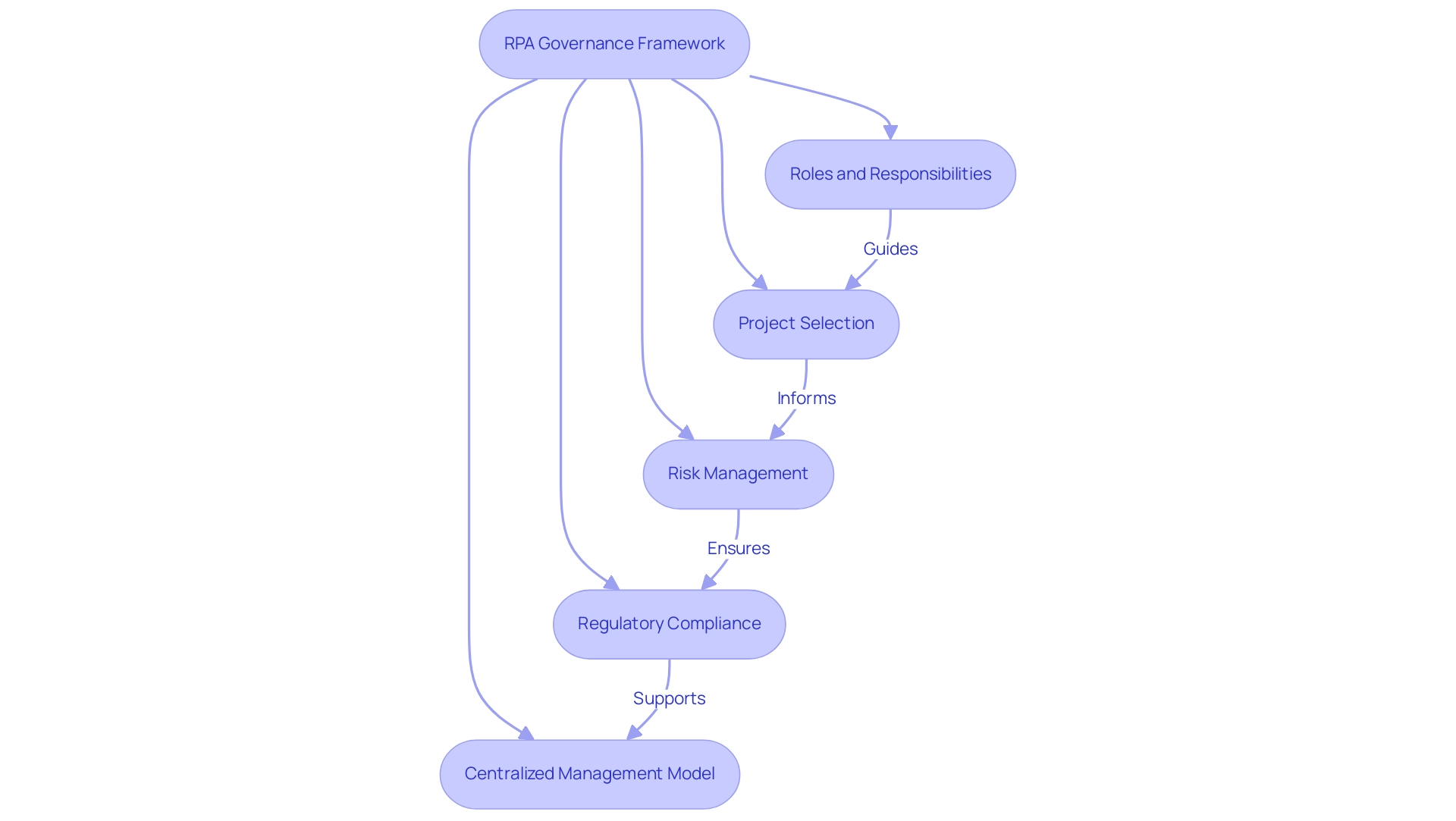
Creating a Center of Excellence for Effective RPA Management
Establishing a Center of Excellence (CoE) for RPA governance is pivotal for organizations aspiring to achieve lasting success with their automation initiatives. The CoE’s primary responsibilities include:
- Defining best practices
- Delivering comprehensive training and resources
- Fostering knowledge sharing among teams
By centralizing expertise, the CoE ensures that RPA projects are executed consistently and effectively, leveraging innovative tools like EMMA RPA, which offers seamless digitalization and user-friendly applications, and Microsoft Power Automate, known for its ability to connect apps and streamline workflows, to enhance operational performance and employee morale.
For instance, the New York Psychotherapy and Counseling Center (NYPCC) has harnessed the UiPath Bridge program to address the mental health needs of underserved communities, showcasing the transformative impact of focused RPA efforts. Hisato Hirakata from Sumitomo Mitsui Trust Bank emphasizes that UiPath stands out as the most flexible tool across various company functions, reinforcing its value in a Code framework. Furthermore, Ey’s experience demonstrates the potential of RPA management via a CoE, as they grew from 5 to 500 robots in only 18 months, emphasizing substantial growth and effectiveness.
Research indicates that training effectiveness in RPA Codes can lead to a 30% increase in productivity and improved employee morale, further supporting the argument for establishing a Code. As entities look to 2024 and beyond, the Code will be crucial in not only implementing best practices but also adjusting to ongoing technological advancements, ultimately fostering greater productivity and innovation in their RPA strategies. This proactive approach is essential for overcoming outdated systems and automating manual workflows, ensuring businesses can thrive in a rapidly evolving AI landscape while enhancing productivity through tailored AI solutions and robust business intelligence.
Book a free consultation to learn how we can help you establish a successful RPA CoE.
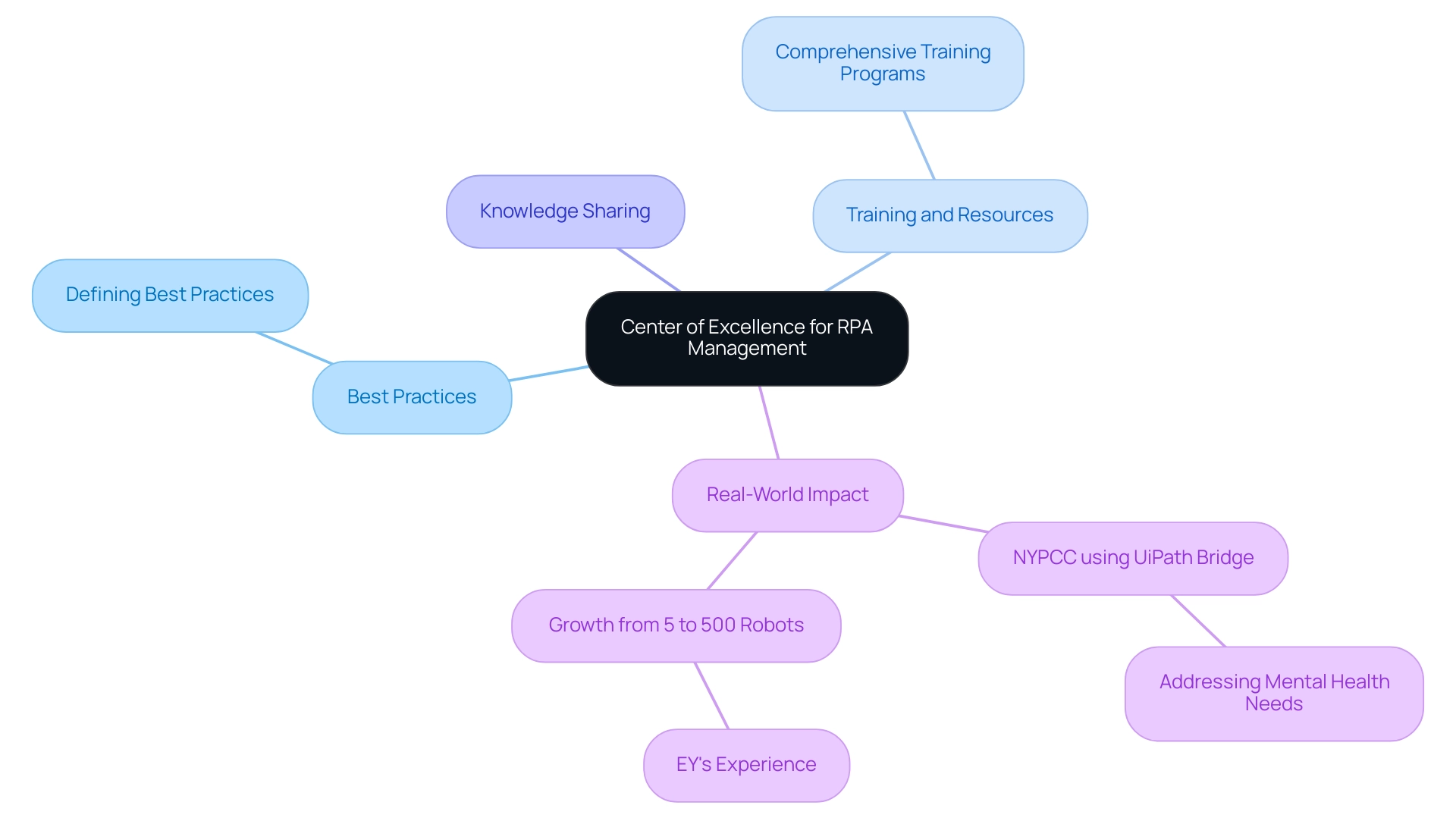
Ensuring Auditability in RPA Processes
Prioritizing auditability in RPA governance processes is crucial for effective management, particularly as manual, repetitive tasks can significantly slow down operations, leading to wasted time and resources. Organizations must adopt a proactive stance in this regard. Implementing robust logging and monitoring systems is crucial for RPA governance, as it helps in tracking RPA activities, ensuring transparency, and facilitating compliance with regulatory standards.
By leveraging Robotic Process Automation (RPA), entities can automate these manual workflows, significantly boosting operational efficiency and freeing up resources for strategic initiatives. Clear documentation for each automated process is not only a best practice but also a prerequisite for effective RPA governance, which aids in the extraction of valuable insights through Business Intelligence. By defining specific roles for monitoring and oversight, entities enhance their ability to manage risks associated with RPA governance in automation.
As highlighted by Claire Qian, PwC’s Risk and Compliance Leader, the third line of defense can significantly contribute by sharing insights and assuring that compliance measures are in place. Moreover, training and upskilling in data and technology are vital for Intelligent Automation (IA) functions to remain relevant and effective in this rapidly evolving landscape. Furthermore, key factors in finance RPA indicate that it is not a standalone product, operates independently from applications, and necessitates human supervision for quality control, highlighting the significance of management in automation.
Pioneering entities that strategically focus on their operations—dedicating 66% of their efforts to key areas—demonstrate how a clear understanding of business objectives leads to effective audit mechanisms. This proactive approach enables them to swiftly identify and address potential issues, minimizing the risks linked to automation. As we progress into 2024, current trends suggest that a strong focus on logging and monitoring will be crucial in creating robust oversight frameworks for RPA governance activities.
Furthermore, with half of IA functions authoring position papers on new risks, trends, or regulations, entities should remain vigilant in adapting their RPA governance strategies.

Implementing Performance Monitoring for Continuous Improvement
Implementing robust performance monitoring systems is essential for entities seeking to assess the effectiveness of their RPA initiatives. This begins with the careful selection of key performance indicators (KPIs) that align with overarching business goals. Critical KPIs might include:
- Process cycle time
- Error rates
- User satisfaction metrics
For instance, as highlighted in a recent case study, a mid-sized healthcare company faced significant challenges such as:
- Manual data entry errors
- Slow software testing
- Difficulty integrating outdated systems without APIs
By implementing GUI automation, they improved operational efficiency, resulting in a remarkable 70% reduction in data entry errors and a 50% acceleration in testing processes. This underscores the financial impact of inefficiencies and the necessity for effective performance monitoring.
Regularly reviewing these indicators enables entities to pinpoint areas ripe for improvement and make informed, data-driven decisions to refine their RPA processes. The need for continuous monitoring is underscored by the fact that 83% of employees utilizing AI-powered automation believe it significantly alleviates burnout and enhances job satisfaction. Moreover, as small and medium-sized enterprises (SMEs) are projected to adopt RPA solutions at an impressive growth rate of 25% annually, the importance of these systems cannot be overstated.
An effective performance monitoring approach cultivates a culture of accountability and innovation within teams, ultimately driving ongoing enhancements in automation strategies. As RPA technology evolves, integrating artificial intelligence and machine learning—as discussed in the case study on future trends—will enable smarter, more adaptive bots that can meet shifting business demands. This evolution further reinforces the value of a comprehensive performance monitoring framework, with the ROI achieved within six months highlighting the effectiveness of the implemented solution.
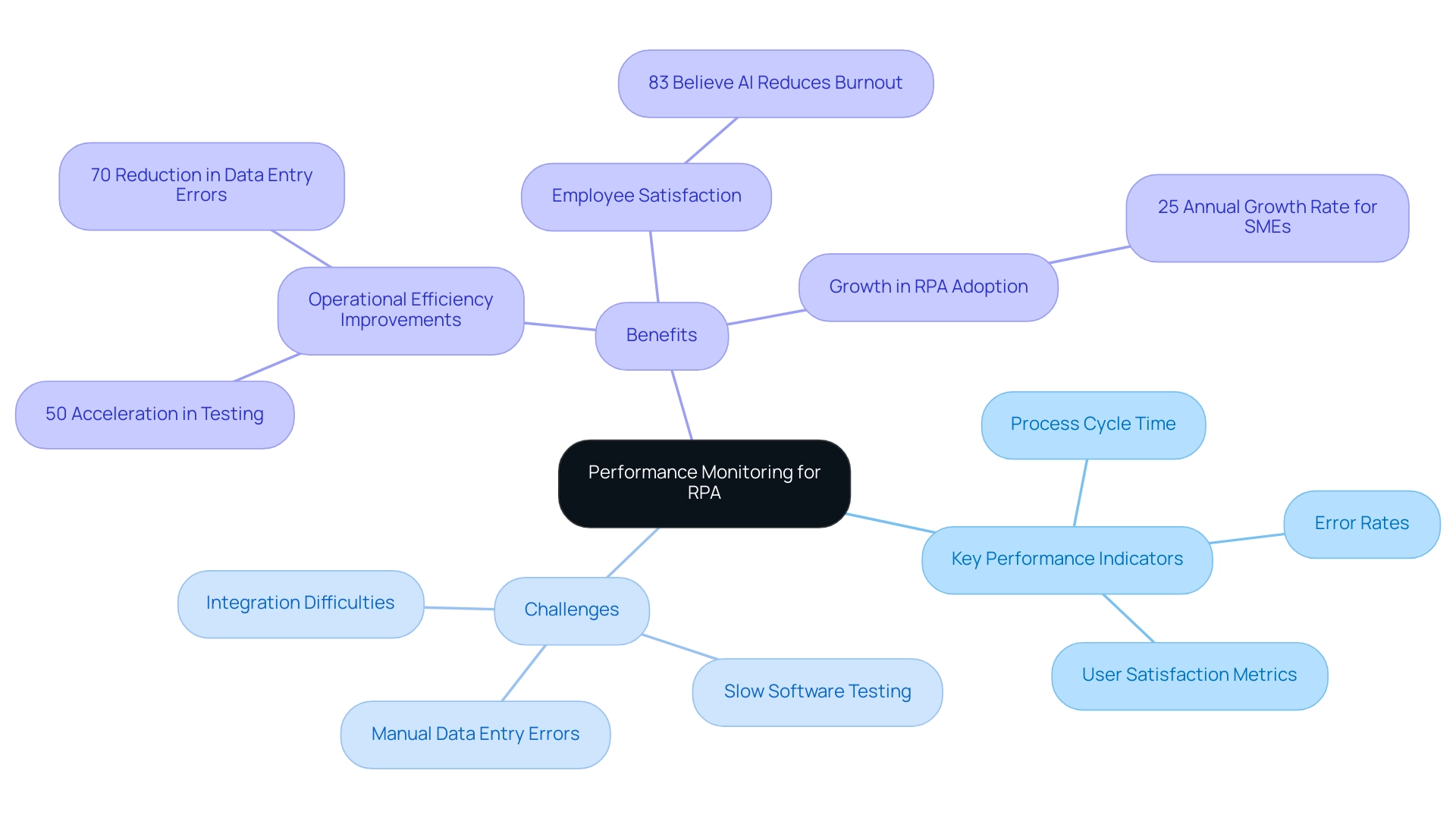
Unlocking the Benefits of Effective RPA Governance
Establishing efficient RPA management can stimulate substantial change within a company. By establishing a strong management framework and integrating RPA governance through a Center of Excellence, organizations position themselves to improve operational performance and achieve significant cost reductions. These frameworks ensure auditability and facilitate performance monitoring, allowing for informed decision-making based on reliable data.
The effect of effective RPA management extends beyond immediate financial benefits; it cultivates a culture of continuous improvement and innovation. Teams are empowered to shift their focus from manual, repetitive tasks to strategic initiatives, driving sustainable growth. Organizations prioritizing RPA management not only benefit from operational efficiencies but also gain a competitive advantage in an increasingly automated landscape.
Additionally, tailored AI solutions play a crucial role in this transformation by providing the necessary tools to navigate the complexities of automation. As highlighted in recent analyses, the global public cloud computing market is anticipated to attain around $679 billion by 2024, emphasizing the importance of RPA governance and the necessity for efficient oversight frameworks. Furthermore, in today’s data-rich environment, companies often struggle to extract meaningful insights, which can leave them at a competitive disadvantage.
Case studies on Business Intelligence and tailored AI solutions illustrate how organizations leveraging RPA have achieved significant operational efficiencies and enhanced decision-making capabilities, reinforcing the need for robust RPA governance.
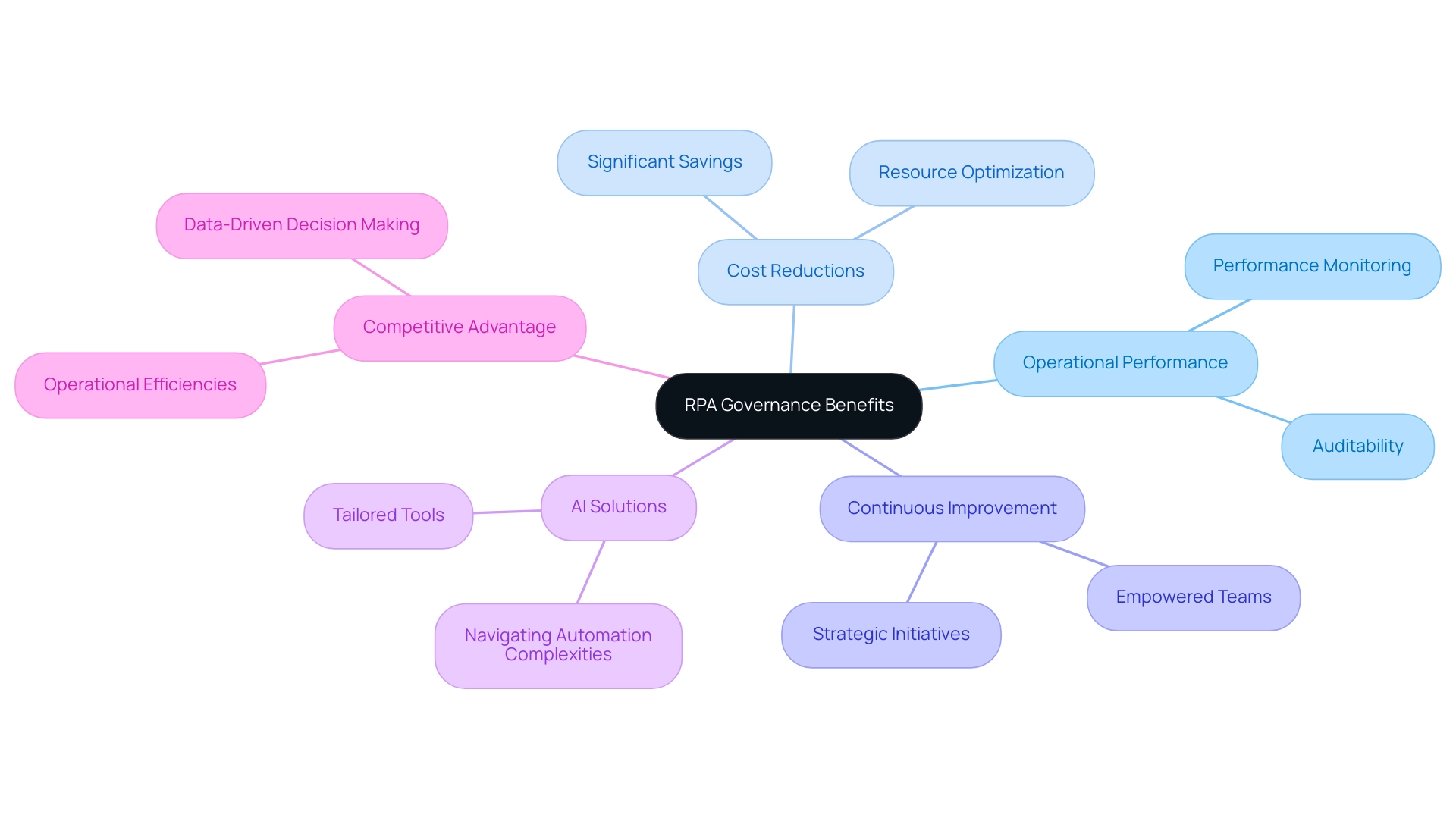
Conclusion
Establishing effective governance for Robotic Process Automation (RPA) is critical for organizations aiming to thrive in an increasingly automated landscape. By implementing a comprehensive enterprise governance framework, organizations can clarify roles and responsibilities, ensuring that RPA initiatives align with strategic objectives. The establishment of a Center of Excellence further centralizes expertise, promotes best practices, and facilitates knowledge sharing, ultimately driving innovation and efficiency.
Moreover, prioritizing auditability and implementing robust performance monitoring systems are essential in maintaining transparency and enhancing decision-making capabilities. These strategies not only foster compliance but also empower teams to focus on strategic initiatives rather than repetitive tasks. As demonstrated through various case studies, organizations that embrace these governance principles are better positioned to unlock substantial operational efficiencies and cost savings.
In conclusion, the journey towards effective RPA governance is not merely about managing automation; it is about cultivating a culture of continuous improvement and adaptability. By prioritizing governance, organizations can navigate the complexities of automation, leverage tailored AI solutions, and ultimately secure a competitive advantage in their respective markets. Now is the time to harness the benefits of RPA governance and position for success in the future.
Introduction
In the rapidly evolving automotive industry, the integration of Robotic Process Automation (RPA) is not just a trend; it is a transformative force reshaping how companies operate and engage with their customers. As organizations navigate the complexities of data management, product development, compliance, and customer service, RPA emerges as a pivotal solution that streamlines processes and enhances efficiency.
By automating repetitive tasks, RPA empowers teams to focus on innovation and strategic initiatives, ultimately driving superior outcomes. From improving warranty claims processing to revolutionizing after-sales support, the potential of RPA is vast and impactful.
This article delves into the myriad ways RPA is enhancing operational performance, fostering collaboration, and elevating the customer experience within the automotive sector, providing practical insights for organizations looking to thrive in a competitive landscape.
Empowering Data-Driven Decisions in Automotive
RPA in automotive is transforming the vehicle industry by allowing organizations to efficiently utilize data through the streamlining of collection and analysis processes. With a staggering 90% of data being classified as unstructured, integrating RPA tools is essential for streamlining data flow from diverse sources. This capability allows for real-time insights that significantly inform strategic decisions, similar to the success seen in the case study of a mid-sized company that implemented GUI automation, resulting in a 70% reduction in data entry errors and an 80% improvement in workflow efficiency.
For instance, vehicle manufacturers can automate the gathering of market information and client feedback, resulting in more accurate forecasting and enhanced product alignment with consumer preferences. This data-driven approach not only enhances operational efficiency but also fosters innovation, empowering companies to swiftly adapt to ever-changing market dynamics. By leveraging RPA in automotive, including innovative tools like EMMA RPA and Microsoft Power Automate, organizations within the car industry can position themselves to not only meet but exceed customer expectations in a competitive landscape.
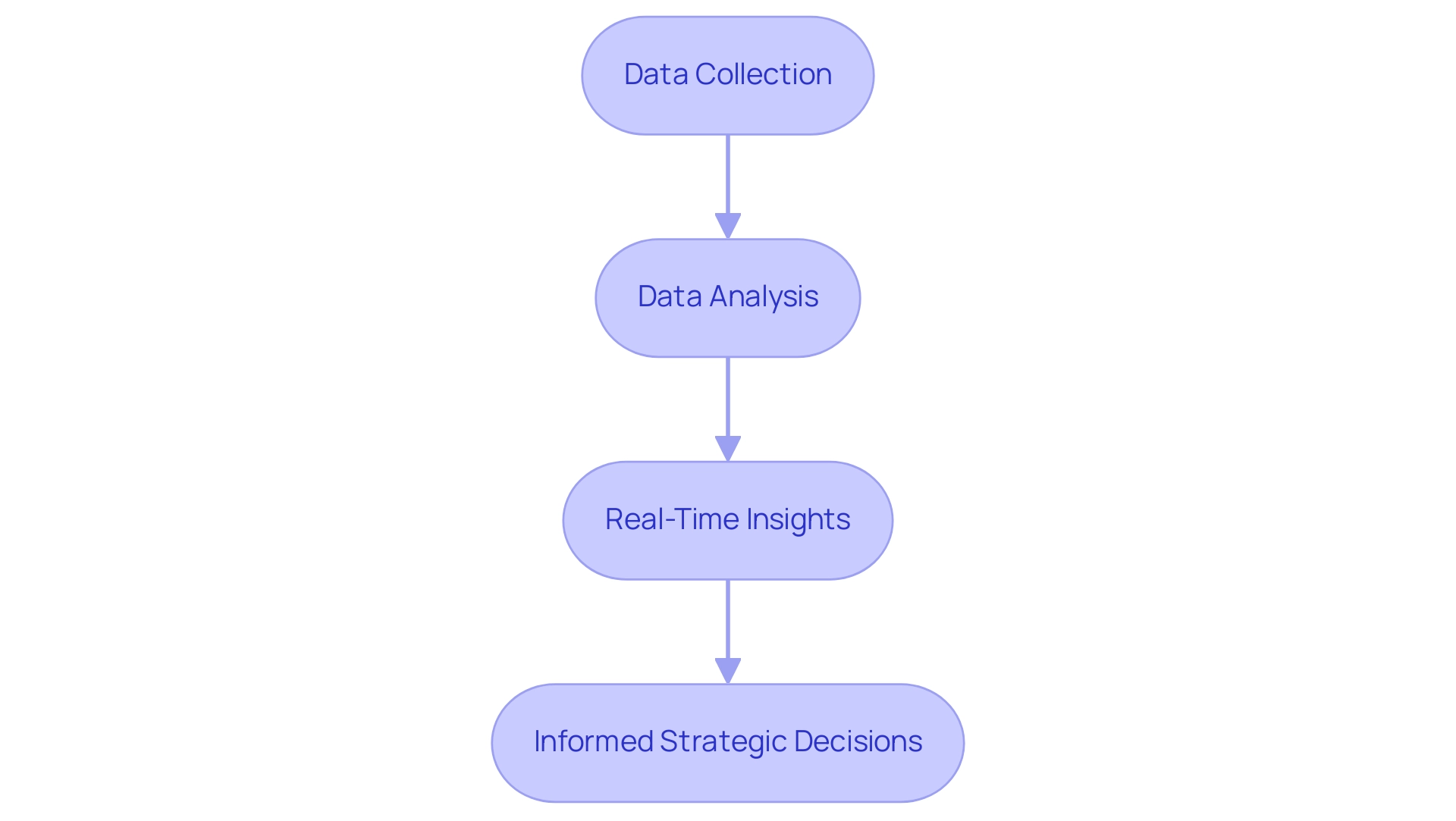
Accelerating Product Development Through RPA
Robotic Process Automation (RPA) in automotive is transforming product development across various industries by automating repetitive tasks such as data entry, testing, and compliance checks. This technology streamlines the entire prototyping phase, allowing companies to automate simulations and testing processes that traditionally consume substantial time and resources. Many organizations struggle with staffing shortages and outdated systems that hinder productivity, leading to employee exhaustion and low morale.
For instance, a mid-sized company that implemented GUI automation reduced data entry errors by 70% and accelerated testing processes by 50%, leading to an impressive 80% improvement in workflow efficiency. Forecasts for 2024 indicate that RPA can lead to significant time savings of up to 30%, enabling teams to redirect their focus from mundane tasks to more creative and strategic initiatives. As Charles Komanoff, Developer of the Balanced Transportation Analyzer (BTA), states, ‘New York should have the world’s best urban transportation system, and congestion pricing is critical to achieving this goal.’
This sentiment reflects the broader need for innovative solutions in the vehicle industry, highlighting the key role of RPA in automotive. Furthermore, Tesla’s recent expansion of its app with an AI-driven trip planning feature exemplifies the use of RPA in automotive by optimizing travel times and energy consumption, thus improving the overall driving experience. As a result, organizations can accelerate innovations and expedite the rollout of new models, enhancing their competitive edge.
The implementation of RPA in automotive lessens manual intervention, encouraging a more agile response to consumer demands and nurturing an environment conducive to groundbreaking advancements in design and functionality. Current trends show that companies utilizing RPA in automotive are better positioned to meet the fast-paced changes in market expectations, ultimately driving efficiency and improving overall product quality.
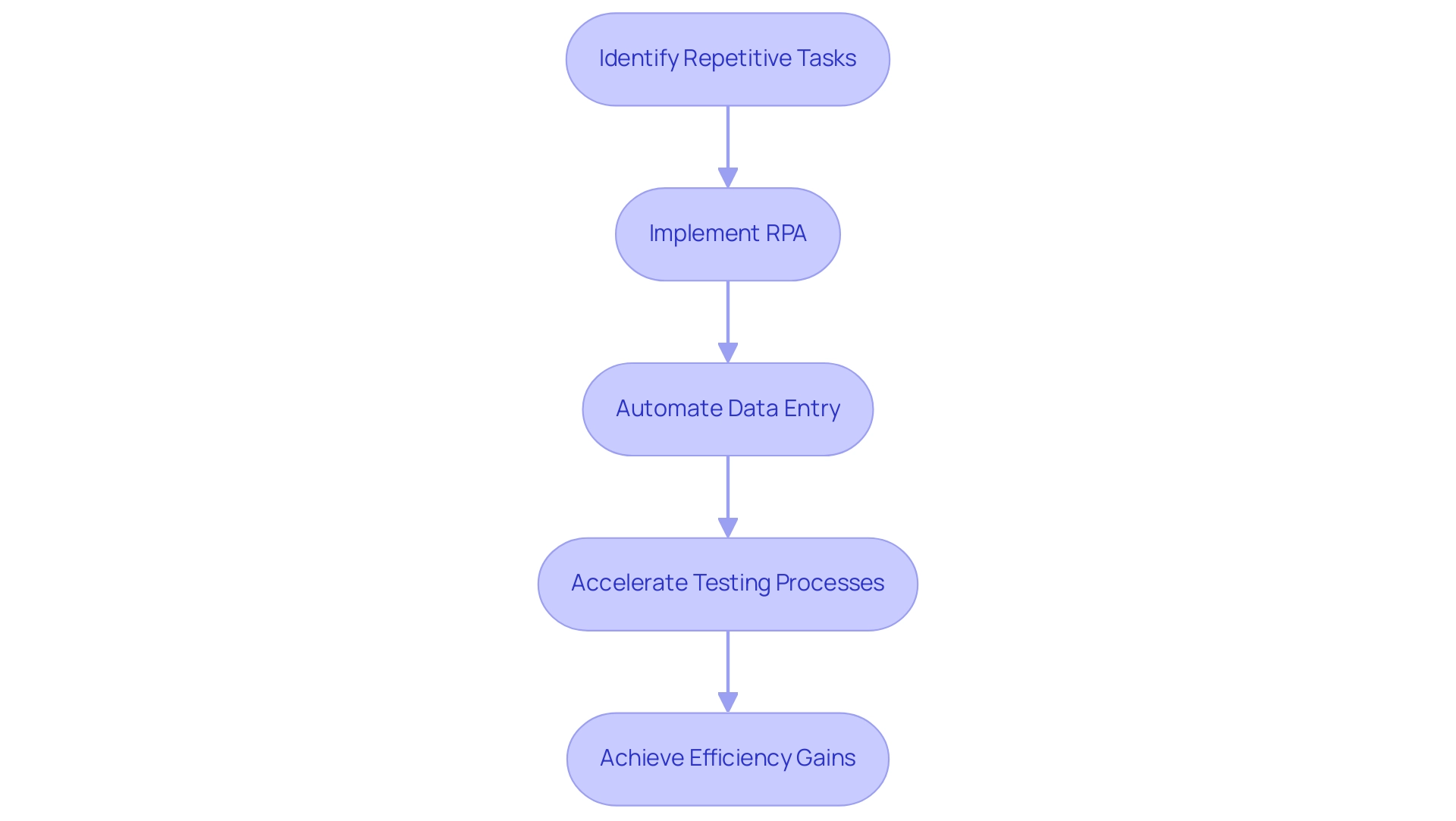
Enhancing Compliance and Safety Standards with RPA
Robotic Process Automation (RPA) significantly enhances compliance by streamlining the monitoring and reporting of safety standards and regulatory requirements. In the vehicle manufacturing sector, producers can utilize advanced RPA in automotive solutions like EMMA RPA to automatically monitor compliance documentation, ensuring that teams are promptly notified of any discrepancies or approaching deadlines. This proactive approach minimizes human error and helps organizations stay aligned with evolving regulations.
A pertinent case study titled ‘Use Case: Implementation in Safety and Risk Management’ illustrates this effectively, showcasing how integrating UiPath’s robotic process technology into safety protocols streamlines safety checklists and inspections, leading to a reduction in human error and the establishment of a safer working environment. Ary Santiago highlights the wider effects of mechanization, stating,
- ‘In conclusion, mechanization has emerged as a transformative force in the vehicle industry, revolutionizing processes and driving tangible benefits across various aspects of compliance and safety standards.’
By leveraging RPA tools, vehicle manufacturers can cultivate a robust culture of safety and compliance, effectively avoiding costly penalties and bolstering their market reputation.
Furthermore, EMMA RPA and Microsoft Power Automate address key challenges like task repetition fatigue and staffing shortages, streamlining processes and enhancing productivity. Statistics indicate that compliance automation in the vehicle sector is expected to see a growth rate of over 30% in 2024, underscoring the critical role of RPA in automotive to ensure that safety standards are not just met but exceeded, ultimately enhancing employee morale and operational efficiency.
Book a free consultation to learn more about how our RPA solutions can benefit your organization.

Streamlining Warranty Claims Processing with RPA
Robotic Process Automation (RPA) in automotive is revolutionizing warranty claims processing by automating essential tasks such as:
- Data entry
- Verification
- Communication
For instance, when an individual submits a warranty claim, RPA can swiftly validate the claim against purchase records, determine eligibility, and process approvals—all without the need for manual intervention. This accelerated method not only streamlines the claims process but also significantly reduces the potential for human error, ultimately enhancing the client experience.
As organizations face common challenges such as staffing shortages and outdated systems, RPA emerges as a vital solution, addressing these issues head-on. Moreover, by alleviating employees from repetitive tasks, RPA can improve morale and job satisfaction, allowing staff to focus on more strategic initiatives. According to recent statistics, the implementation of RPA in automotive can enhance warranty claims processing efficiency by up to 30% in 2024, allowing automotive companies to develop stronger client loyalty while also reducing the operational costs usually linked to claims management.
As noted by industry professional Bell, ‘Don’t miss the chance to join a diverse, inclusive environment where you feel a sense of belonging.’ This sentiment reflects the broader impact of RPA on fostering a collaborative atmosphere that prioritizes client satisfaction. Furthermore, a case study from Textron Aviation highlighted how their implementation of RPA in automotive warranty claims processing led to a 25% reduction in processing time, showcasing the tangible benefits of RPA in automotive for enhancing operational efficiency and addressing workplace challenges.

Transforming After-Sales Support with RPA
RPA in automotive is transforming after-sales support by streamlining service interactions and optimizing support ticket management. For example, chatbots driven by RPA technology can efficiently manage routine inquiries, enabling human agents to concentrate on more complex client issues. This transition not only speeds up response times—cutting them by up to 30%—but also guarantees that clients receive prompt follow-up communications and service reminders, ultimately improving their overall experience.
As highlighted in the B2B Sales Statistics case study, the increasing complexity of the sales process necessitates effective solutions like RPA to assist organizations in navigating multiple decision-makers and extensive buyer research. Additionally, studies reveal that:
- 65% of businesses have seen improved performance in their contact centers through the integration of AI tools.
- This system results in enhanced client satisfaction, promoting loyalty and repeat sales.
According to John Doe from the Wharton School of Business, the lifetime value of referred clients is on average 16% higher than that of non-referred clients. By leveraging innovative RPA solutions like EMMA RPA, which enhances operational efficiency through intelligent automation, and Microsoft Power Automate, which enables seamless workflow integration, organizations can enhance their after-sales support system through RPA in automotive. These tools specifically address challenges such as task repetition fatigue and staffing shortages, ultimately meeting the evolving expectations of their customers and enhancing productivity.
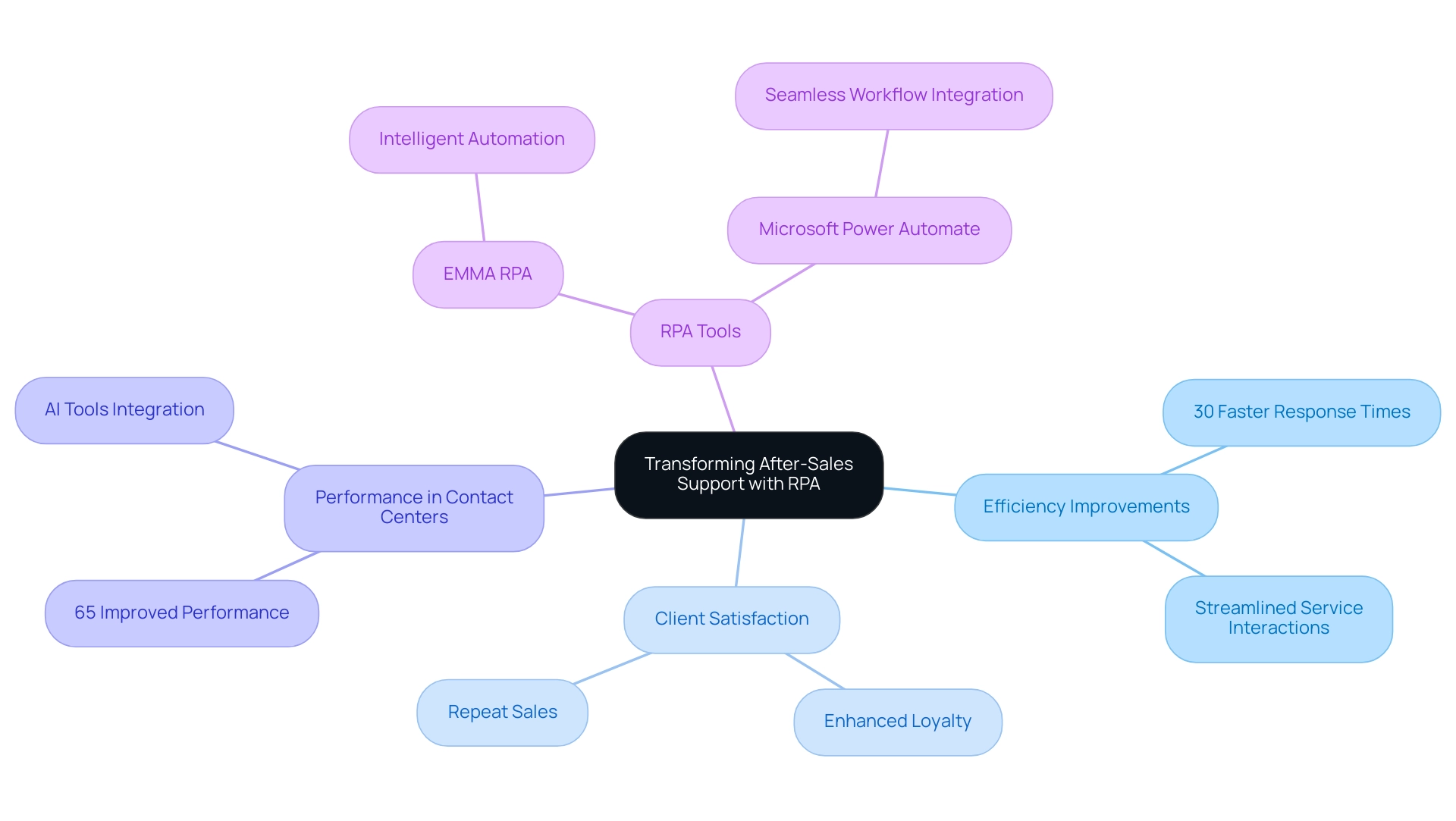
Enhancing Supply Chain Collaboration Through RPA
RPA in automotive significantly enhances collaboration within the vehicle supply chain by automating the sharing of essential data and communication between partners. By facilitating the seamless exchange of inventory levels, shipment statuses, and order updates, RPA provides stakeholders with real-time visibility that is crucial for informed decision-making. This capability allows companies to swiftly adapt to fluctuations in demand or respond to supply disruptions.
Wes Brown, Head of Operations at Black Claw LLC, shares his experience, noting, ‘ShipBob has an analytics tab in their dashboard with all of this information, which is great for end-of-month reconciliations.’ Moreover, with 31% of respondents voicing worry about labor displacement resulting from technology, it is crucial to consider the workforce implications of implementing RPA. The case study on demand forecasting from ShipBob illustrates how RPA tools, including innovative solutions like EMMA RPA and Microsoft Power Automate, can enhance decision-making in inventory management, allowing businesses to track SKU performance and plan for future inventory needs effectively.
Such functionalities not only streamline processes but also empower vehicle manufacturers to optimize their supply chain operations, significantly reduce lead times, and enhance overall efficiency. As reported, the implementation of RPA in automotive is projected to yield notable improvements in supply chain efficiency in 2024, underscoring the technology’s growing importance in the industry. Moreover, it is important to recognize that 45% of business teams play crucial roles in RPA in automotive, highlighting the collaborative aspect of business process automation implementation in the automotive supply chain.
Additionally, RPA offers significant productivity and cost benefits, making it a vital component in overcoming technology implementation challenges. Tailored AI solutions and business intelligence further enhance the effectiveness of RPA, enabling companies to leverage data for strategic decision-making.
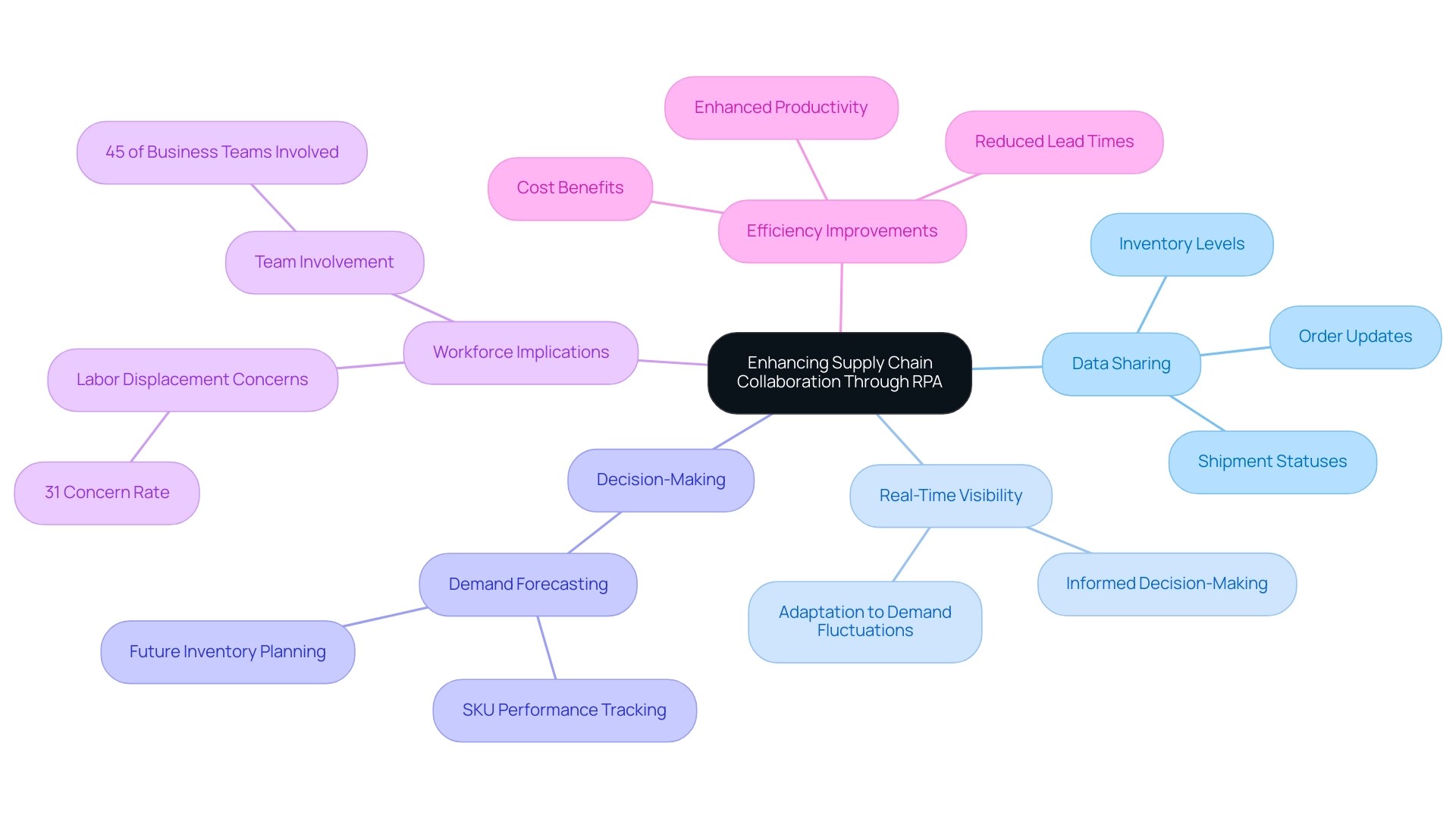
Revolutionizing the Dealership Experience with RPA
The implementation of RPA in automotive is fundamentally transforming the dealership experience by automating critical processes, ranging from inventory management to improving client interactions. With innovative tools like EMMA RPA and Microsoft Power Automate, dealerships can efficiently manage vehicle inventories by automatically monitoring stock levels and generating alerts when supplies run low, ensuring that they never miss a sales opportunity due to inventory shortages. Moreover, in the realm of client engagement, RPA in automotive solutions personalize communications by tailoring messages to individual preferences and automating appointment scheduling, significantly reducing wait times and improving service quality.
RPA in automotive solutions effectively tackle task repetition fatigue, staffing shortages, and outdated systems, which are common challenges in the industry. As highlighted in the 2024 Gartner® Magic Quadrant™ for Analytics and Business Intelligence Platforms, Qlik has been recognized as a Leader for the 14th consecutive year, underscoring the importance of robust analytics in driving operational efficiency. This shift towards automation, especially with RPA in automotive, not only boosts operational efficiency but also fosters stronger relationships, as dealerships can provide timely and relevant interactions.
A quote from industry leaders encapsulates this necessity:
‘It was imperative to provide our managers with a solution that is easily accessible via mobile applications to provide them with information in real time.’
By creating a seamless and satisfying experience for clients, the implementation of RPA in automotive not only drives increased sales but also cultivates loyalty, setting dealerships apart in a competitive market. Furthermore, similar to how Merck & Co. employs Qlik Sense across 60 countries for enhanced oversight of its portfolio, dealerships can leverage RPA to improve their operational efficiency.
As they continue to embrace these advancements, the positive impact of RPA in automotive on both inventory management and customer experience becomes increasingly evident. The accompanying illustration depicts a human figure collaborating with robotic figures, visually representing the integration of RPA in automotive, emphasizing automation and collaboration between human and machine.
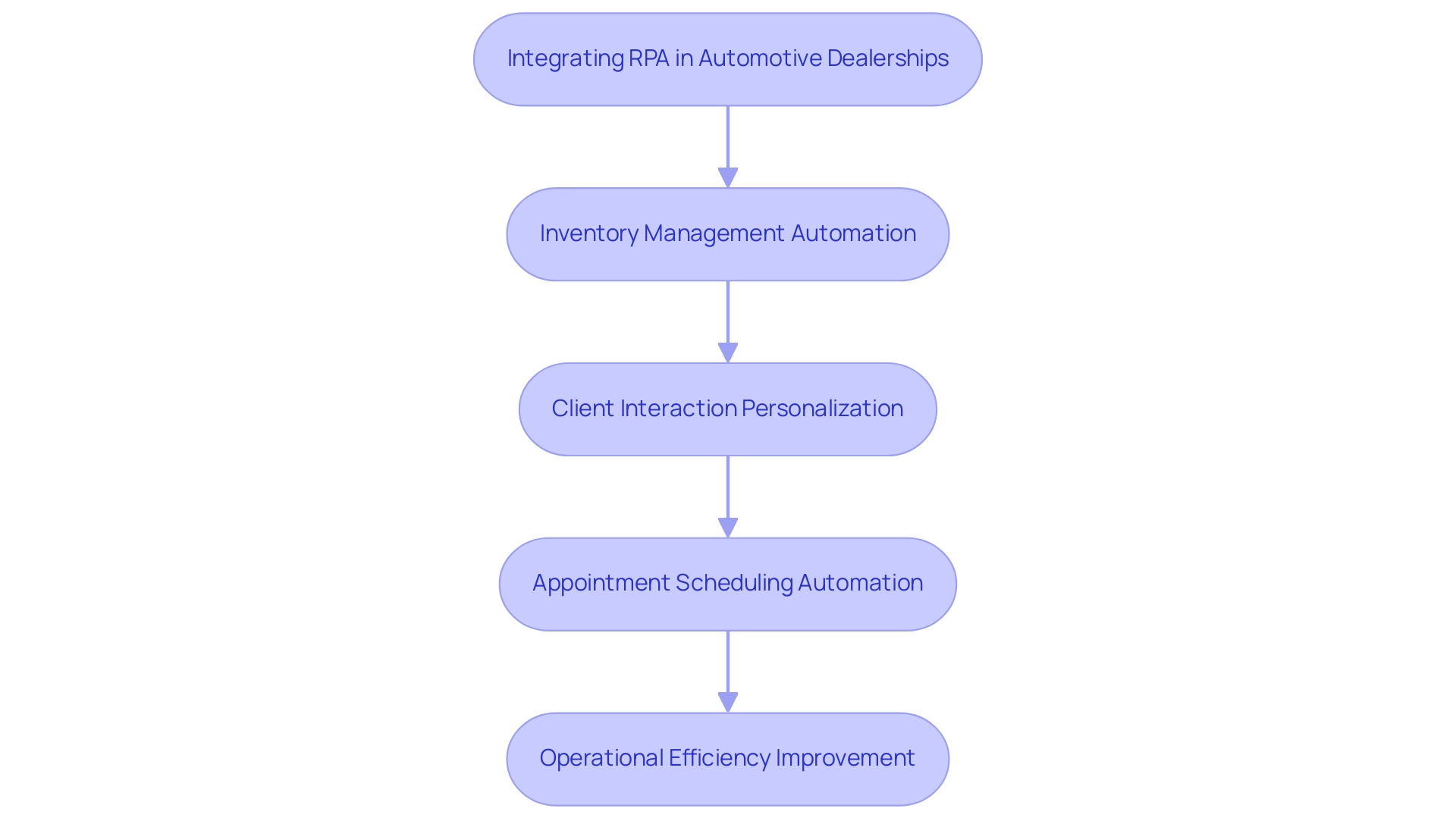
Conclusion
The automotive industry stands on the brink of a transformative era, largely driven by the adoption of Robotic Process Automation (RPA). Throughout this exploration of RPA’s impact, key themes have emerged, emphasizing its role in:
- Enhancing data-driven decision-making
- Accelerating product development
- Bolstering compliance and safety standards
By automating repetitive tasks, RPA not only streamlines operations but also empowers teams to focus on innovation, ultimately fostering a culture of agility and responsiveness.
In the realm of warranty claims processing and after-sales support, RPA has demonstrated its capacity to significantly improve efficiency and customer satisfaction. The ability to handle tasks automatically reduces human error and enhances the overall customer experience, ensuring organizations can build stronger relationships with their clientele while mitigating operational costs. Additionally, the integration of RPA within supply chain management facilitates real-time data sharing, optimizing collaboration and decision-making among partners.
As the automotive landscape continues to evolve, embracing RPA solutions will be crucial for organizations looking to maintain a competitive edge. The potential for increased productivity, improved compliance, and enhanced customer interactions is not just a possibility; it is becoming a reality for those willing to innovate. By leveraging RPA technologies like EMMA RPA and Microsoft Power Automate, companies can position themselves not only to meet current demands but also to anticipate future challenges, driving sustained growth and success in an increasingly dynamic marketplace.
Introduction
The landscape of artificial intelligence is evolving at an unprecedented pace, with Machine Learning (ML) and Generative AI emerging as powerful catalysts for operational efficiency and innovation. These technologies not only enable organizations to analyze vast amounts of data but also empower them to create entirely new content, redefining the boundaries of creativity and functionality.
As businesses grapple with the complexities of integrating these advanced solutions, understanding the distinct roles of ML and Generative AI becomes essential. This article delves into their definitions, key differences, real-world applications, and the challenges organizations face in implementation.
By exploring these facets, it provides insights into how tailored AI solutions can drive growth, enhance productivity, and ultimately transform the operational landscape. As the future unfolds, organizations that strategically harness these technologies will be well-positioned to navigate the ever-changing demands of their industries.
Defining Machine Learning and Generative AI
The discussion of ML vs generative AI emphasizes that Machine Learning (ML) is a crucial subset of artificial intelligence centered on developing algorithms that enable computers to learn from information, make predictions, and support informed decision-making. These algorithms enhance their accuracy and capabilities as they process larger datasets over time, excelling in pattern recognition and predictive analytics. A key aspect of machine learning algorithms is their capacity to adjust and enhance consistently, which enables organizations to utilize insights based on information for efficiency in operations.
In contrast, generative AI represents a dynamic sector of artificial intelligence that focuses on producing new material or information, highlighting the differences in capabilities when considering ML vs generative AI. This includes the creation of innovative images, text, music, and more. Significant generative AI models, like Generative Adversarial Networks (GANs) and transformers, employ vast collections to create original results that mirror the attributes of the training sets.
The advancements in generative AI have fueled creativity and innovation across various sectors, demonstrating its potential to revolutionize content creation.
As of 2024, the adoption of machine learning technologies is projected to grow significantly, especially in discussions around ML vs generative AI, with statistics indicating that approximately 75% of organizations are expected to integrate machine learning into their operations, recognizing its value in enhancing efficiency. Furthermore, the growth of generative AI technologies, especially when considering ML vs generative AI, is anticipated to accelerate, with market analysts predicting a 30% increase in investment in this area, providing new avenues for creativity and functionality in diverse applications. A relevant case study, titled ‘Maximiza tu calidad con TMMi,’ illustrates successful practices for maximizing quality using the TMMi model, showcasing how organizations can implement machine learning algorithms to improve outcomes.
In light of these developments, it’s essential to explore not just the capabilities of these technologies but the underlying principles that define them.
As Steve Polyak aptly remarked, ‘Before we work on artificial intelligence, why don’t we do something about natural stupidity?’ This perspective highlights the challenges of poor master information quality and the reluctance organizations face in adopting AI due to perceptions of complexity, cost, and integration issues. Overcoming these barriers is essential for utilizing the full potential of AI and improving efficiency through customized solutions like Small Language Models (SLMs) that provide effective, secure, and economical analysis.
Moreover, the integration of Business Intelligence can greatly change raw information into actionable insights, allowing informed decision-making that promotes growth and innovation. By utilizing RPA, organizations can streamline workflows, reduce operational inefficiencies, and allocate resources more effectively, further enhancing overall productivity. Together, these technologies pave the way for a more efficient and data-driven organizational landscape.
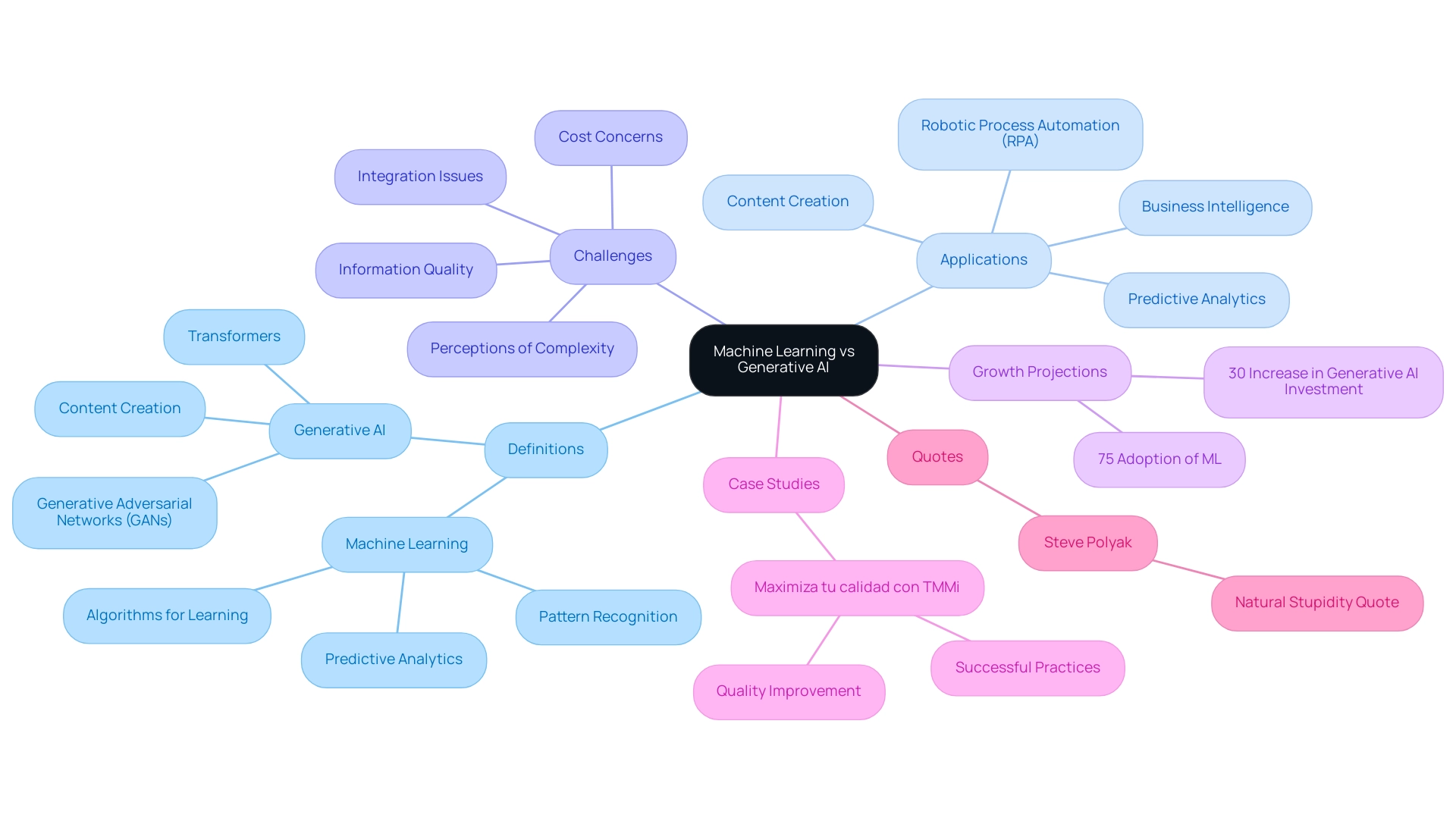
Key Differences Between Machine Learning and Generative AI
-
Purpose: At its core, Machine Learning (ML) is designed to analyze existing information to make informed predictions or decisions. In contrast, creative AI goes a step further by not only comprehending information patterns but also producing new content that reflects those learned patterns. As Ian Goodfellow, a Research Scientist at Apple, states, “Generative models are a key enabler of machine creativity, allowing machines to go beyond what they’ve seen before and create something new.” This distinction highlights a fundamental shift in capability—from analysis to creation, especially when considering ml vs generative ai.
-
Data Utilization: ML relies heavily on historical data to train its models, enabling it to predict future outcomes based on past trends. For example, Maker’s Mark produces 34 million bottles of bourbon annually, showcasing how ML can optimize production processes. Meanwhile, Robotic Process Automation (RPA) can be utilized to automate repetitive tasks, streamlining workflows, reducing errors, and enhancing operational efficiency. AI utilizes existing datasets to understand the underlying distribution, enabling it to produce new instances that fit seamlessly within that framework. This approach opens up innovative avenues for content generation and creativity.
-
Output Type: The outputs produced by ML models are typically structured, yielding predictions such as classifications or regression results. In contrast, this type of AI excels in producing unstructured outputs, including images, text, and audio, which can lead to transformative applications in various fields. RPA complements these technologies by ensuring that the processes feeding into ML and AI are efficient and error-free, thereby enhancing the overall output quality.
-
Complexity of Models: The spectrum of ML models ranges from straightforward linear regressions to sophisticated neural networks. However, AI often utilizes more complex architectures, such as Adversarial Networks (GANs) and deep learning models, which require significant computational resources and expertise. This complexity enables creative AI to push boundaries in material creation, while RPA simplifies the integration of these advanced technologies into existing workflows, tackling challenges posed by manual, repetitive tasks.
-
Applications: The applications of ML are diverse, encompassing areas like predictive analytics, fraud detection, and recommendation systems. In contrast, creative AI finds its niche in artistic domains such as art generation, content creation, and even the development of synthetic data for training other models, highlighting the distinctions between ml vs generative ai. The integration of RPA across these applications emphasizes the importance of operational efficiency in scaling these technologies effectively, as it reduces errors and frees up team resources.
-
Training Process: ML models typically utilize supervised or unsupervised learning methods to refine their predictions. This type of AI, however, frequently employs adversarial training methods, where two models compete against each other to enhance the quality of generated outputs. This unique training process is a hallmark of Ai’s innovative capabilities, highlighting the differences in ml vs generative ai, paired with RPA that ensures the underlying data processes are optimized.
-
User Interaction: Interactivity with ML applications often necessitates user input for training and validation, reinforcing the importance of human oversight. In contrast, AI can autonomously create content without direct human intervention, fostering a new era of innovation and creativity in automated content generation. By leveraging RPA, organizations can enhance user interactions by minimizing manual input while maximizing output quality.
-
Current Discourse: The landscape of AI is rapidly evolving, with discussions surrounding regulation gaining traction. Sam Altman has suggested that the US government might consider licensing and testing requirements for AI models with advanced capabilities to ensure safety and global coordination. This emphasizes the significance of grasping both ML and creative AI within the context of operational efficiency, customized AI solutions, and regulatory frameworks, ensuring businesses navigate the overwhelming AI landscape effectively.
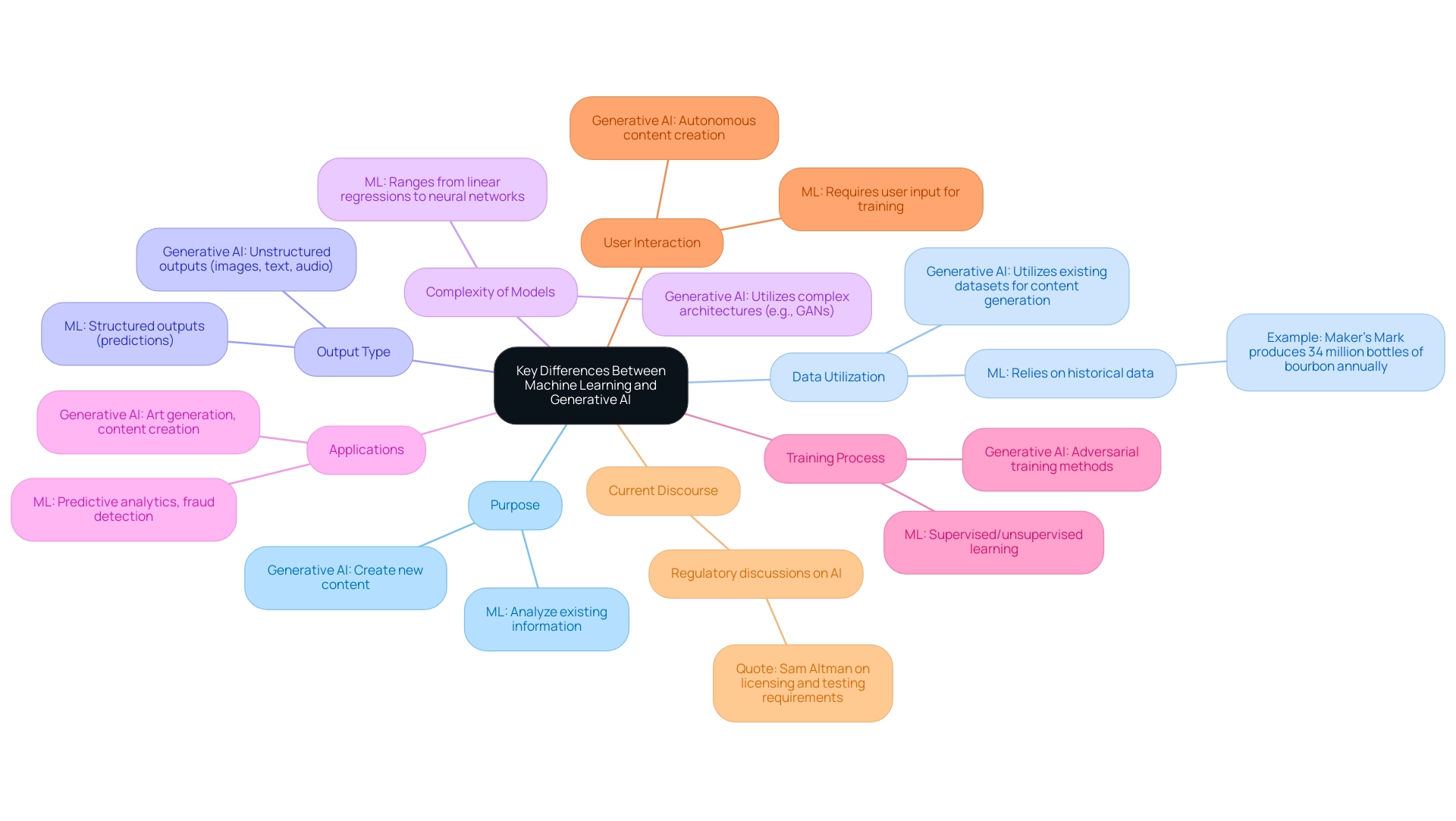
Real-World Applications of Machine Learning and Generative AI
Machine Learning (ML) is a transformative force across multiple industries, offering significant advantages in areas such as:
- Finance: Utilizing sophisticated algorithms to detect fraudulent activities and assess risk by meticulously analyzing transaction patterns, thereby safeguarding assets and enhancing trust.
- Healthcare: Leveraging historical data to predict patient outcomes and tailor treatment plans, which not only optimizes patient care but also improves overall health system efficiency.
- Retail: Powering recommendation systems that analyze purchasing behaviors, these systems enrich customer experiences by providing personalized suggestions that boost sales and customer loyalty.
Conversely, Generative AI is revolutionizing creative industries through applications such as:
- Creative Industries: Fostering innovation by generating artwork, music, and written content, thus enabling creators to explore new dimensions of creativity and expression.
- Gaming: Crafting immersive environments and adaptable characters that evolve based on player interactions, enhancing the gaming experience and keeping players engaged.
- Marketing: Generating personalized content at scale, this technology empowers brands to connect with their audiences more effectively, tailoring messages that resonate and drive engagement.
As we move further into 2024, the integration of technologies such as ML vs Generative AI, along with Robotic Process Automation (RPA) to automate manual workflows, is set to reshape industries. RPA not only boosts efficiency by reducing errors but also frees up team resources, allowing staff to focus on more strategic initiatives. For instance, a recent statistic indicates that 80% of financial institutions are utilizing ML for fraud detection, underscoring its critical role in safeguarding assets.
Furthermore, Daniel H. Wilson’s case study, “The Future of Robotics,” discusses the limitless possibilities in robotics and AI integration, highlighting advancements that parallel the development of driverless cars, a key point emphasizing AI’s transformative impact. Notably, the insights of Isaac Asimov serve as a reminder of the ethical considerations in this journey:
A robot may not injure a human being or, through inaction, allow a human being to come to harm.
By leveraging tailored AI solutions that directly address functional challenges, organizations can navigate the overwhelming array of options and harness Business Intelligence for actionable insights, ultimately enhancing productivity and informed decision-making.
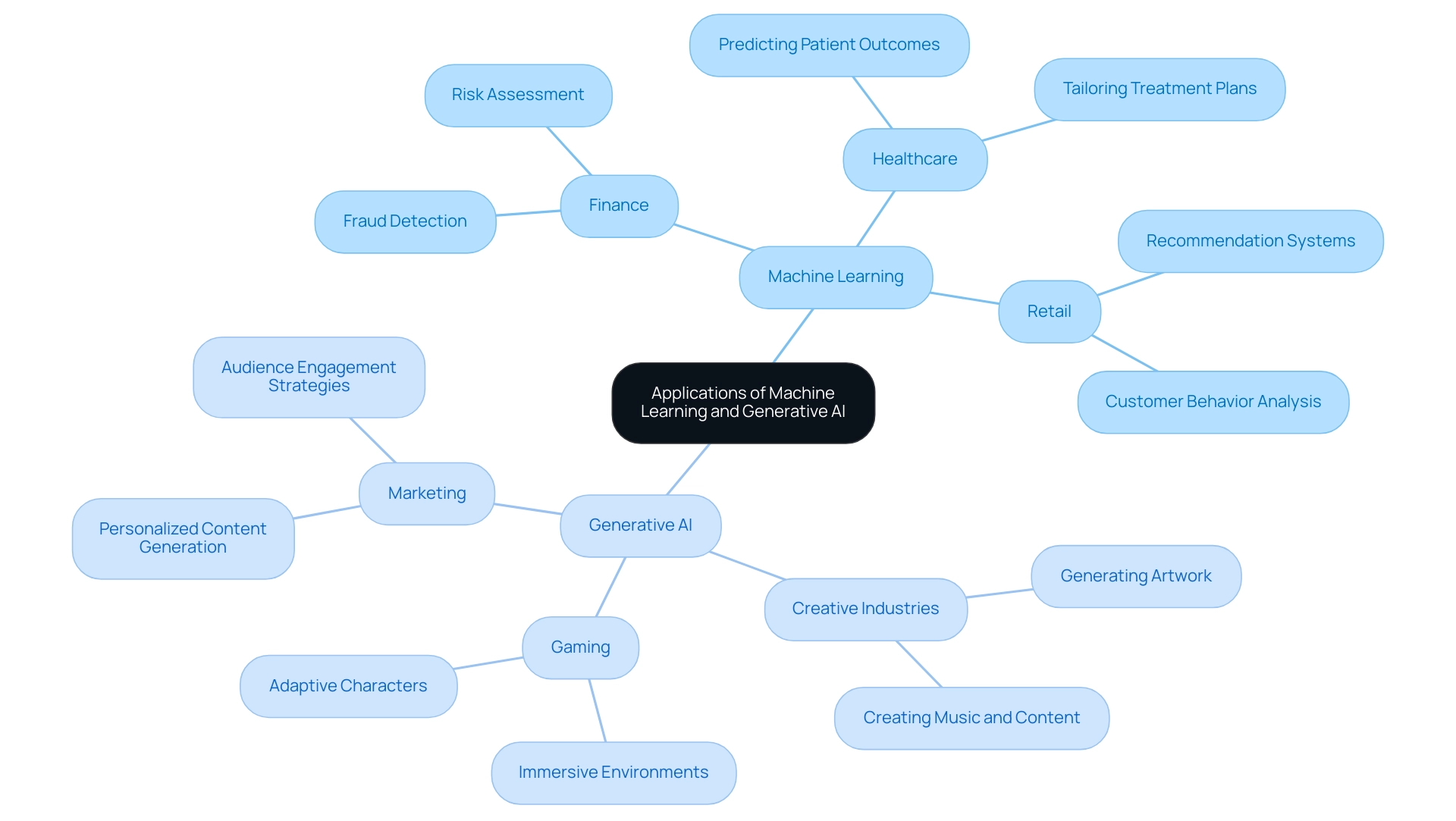
Challenges and Considerations in Implementing ML and Generative AI
Implementing ml vs generative ai presents a variety of challenges that, when addressed thoughtfully, can lead to significant operational improvements. Here are some key considerations:
-
Information Quality: High-quality, relevant information is crucial for the effective training of both technologies. Research shows that organizations with over 50 analytics initiatives frequently observe only 1 or 2 that provide genuine business value, highlighting how inadequate information quality can result in erroneous forecasts or inferior produced material. By prioritizing information quality, businesses can turn these statistics around, enabling successful outcomes and leveraging Business Intelligence to drive insights crucial for organizational growth.
-
Resource Intensity: AI projects tend to be resource-intensive, requiring substantial computational power and specialized expertise. Understanding the resource demands associated with implementing ml vs generative ai is essential. Organizations should thoughtfully strategize and distribute resources to address these needs efficiently, taking into account how Robotic Process Automation (RPA) can simplify workflows and improve efficiency in a swiftly changing AI environment.
-
Ethical Considerations: The application of AI brings forth important ethical issues, especially concerning privacy, algorithmic bias, and the possible consequences of AI-generated materials. As industry thought leader Steve Polyak aptly stated,
Before we work on artificial intelligence, why don’t we do something about natural stupidity?
This emphasizes the need for responsible AI practices that prioritize ethical standards and align with the principles taught in our GenAI workshops, ensuring that AI solutions are integrated thoughtfully and ethically. -
Change Management: Resistance from employees can be a significant barrier when introducing AI technologies. Effective change management strategies are vital to foster acceptance and collaboration. For instance, SnappCar’s recent MLOps setup not only optimized operations but also facilitated smoother transitions by addressing employee concerns. This showcases how strategic initiatives, including hands-on training from our workshops, can lead to substantial cost reductions while hitting multiple targets.
-
Minimum Viable Products: Focusing on Minimum Viable Products rather than just proof of concept is crucial for successful implementation. This approach allows organizations to validate their ideas quickly and efficiently, reducing the risk associated with more extensive deployments.
-
Current Insights: To stay informed about the evolving landscape of ml vs generative ai, Bernard’s latest book, ‘Generative AI in Practice,’ offers valuable insights into practical applications and considerations for organizations embarking on these initiatives.
By proactively addressing these challenges related to ml vs generative ai, organizations can enhance their implementation strategies, leverage tailored AI solutions effectively, and position themselves for long-term success in integrating machine learning and generative AI.
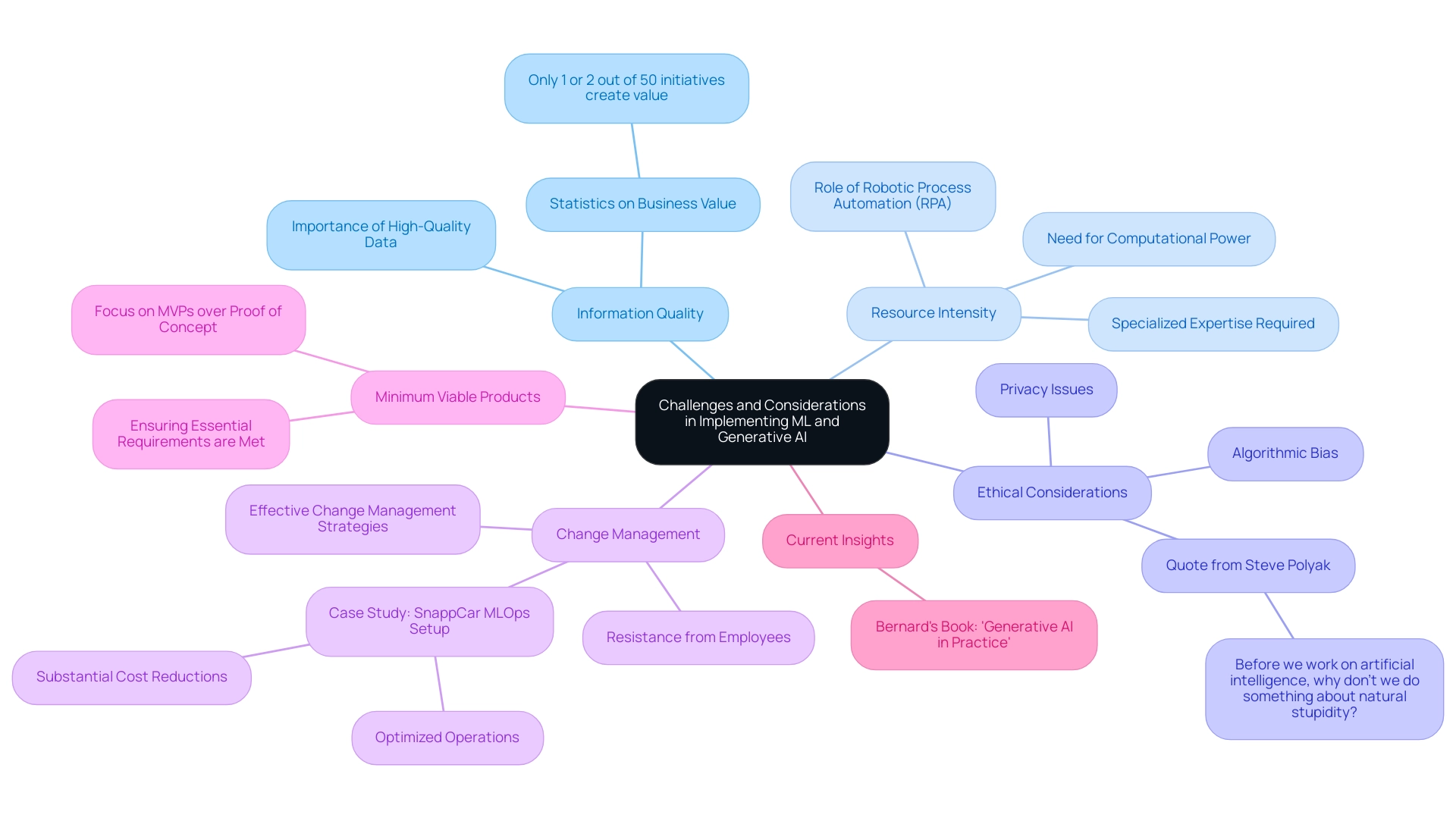
The Future of Machine Learning and Generative AI
The future environment of ML vs generative AI is set for significant expansion, driven by a growing dependence on information across sectors. A recent statistic reveals that 70% of AI users bring their personal AI tools to work, reflecting a significant trend toward AI adoption. Here are some key trends to anticipate:
- Increased Automation: Advanced ML algorithms will facilitate the automation of more processes, enabling organizations to streamline operations and redirect human resources toward strategic initiatives that foster innovation and efficiency.
Leveraging Robotic Process Automation (RPA), businesses can eliminate manual, repetitive tasks that hinder productivity, ultimately enhancing operational efficiency.
-
Enhanced Creativity: AI is set to revolutionize creative fields by producing original content that transcends traditional boundaries, opening new avenues for artistic expression and innovation, which can be strategically utilized for competitive advantage.
-
Ethical AI Development: As AI technologies proliferate, there will be a growing emphasis on developing ethical frameworks to guide responsible AI practices, ensuring that advancements benefit society and align with organizational values.
-
Integration Across Industries: ML and AI will increasingly permeate various sectors, driving novel applications and business models that leverage their capabilities to enhance operational efficiency and customer engagement. Our custom Small Language Models (SLMs) exemplify this by providing tailored, cost-effective solutions for efficient data analysis while ensuring enhanced privacy and compliance. These models are designed to address common concerns about AI projects being time-intensive and costly, making them easier to implement and maintain.
Furthermore, the case study titled ‘Language as Code’ by Lisa Huang, Head of AI at Fidelity Investments, illustrates how generative AI is reshaping our understanding of communication. Huang states,
Generative AI is teaching us that the way you speak is actually code itself.
This insight underscores the importance of viewing human-machine interactions through the lens of language as a form of code, which is crucial for enhancing automation and operational efficiency in the coming years. By integrating these insights, we can better understand the transformative potential of ML vs generative AI in the workplace, which empowers directors of operations efficiency to navigate challenges and harness the benefits of tailored AI solutions and business intelligence for informed decision-making. To explore how our solutions can work for you, book a free consultation today.
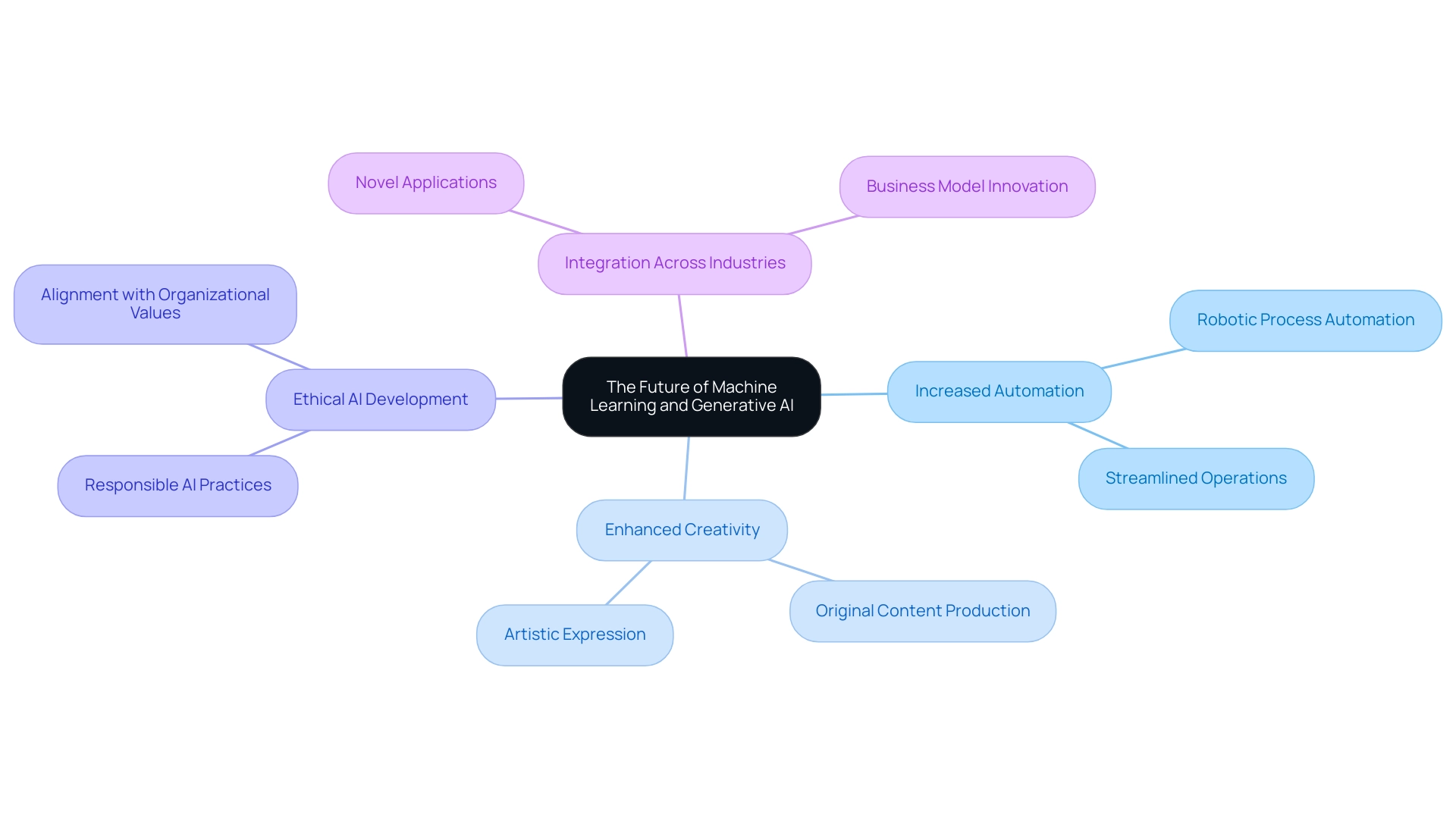
Conclusion
The exploration of Machine Learning (ML) and Generative AI reveals their profound impact on operational efficiency and innovation across industries. Understanding the distinct roles these technologies play is crucial for organizations aiming to harness their potential. ML excels in analyzing existing data to enhance decision-making and predictive capabilities, while Generative AI pushes the boundaries of creativity by generating new content that reflects learned patterns.
Real-world applications underscore the versatility of these technologies, from fraud detection in finance to personalized content creation in marketing. However, the journey toward successful implementation is not without challenges. Data quality, resource intensity, ethical considerations, and change management are pivotal factors that organizations must address to fully leverage the benefits of AI. By adopting strategies such as focusing on Minimum Viable Products and ensuring robust data practices, businesses can navigate these complexities effectively.
Looking ahead, the future of ML and Generative AI is bright, characterized by increased automation, enhanced creativity, and a commitment to ethical AI development. As organizations integrate these technologies into their operations, they will not only transform their workflows but also redefine their competitive advantage in the market. By embracing tailored AI solutions and prioritizing data-driven insights, businesses can position themselves for long-term success, ensuring they remain agile and responsive in an ever-evolving landscape.
Introduction
In an era defined by rapid technological advancements, the convergence of generative AI and machine learning is reshaping how organizations operate and innovate. These powerful tools not only enhance creativity and streamline processes but also empower businesses to make data-driven decisions that drive growth.
As companies grapple with the complexities of integrating these technologies into their workflows, understanding the nuances between generative AI and traditional machine learning becomes essential. This article delves into the mechanisms behind generative AI, explores the principles of machine learning, and highlights the benefits and challenges each presents.
By examining the future landscape of these technologies, organizations can unlock their full potential and navigate the evolving demands of operational efficiency with confidence.
Defining Generative AI: Concepts and Mechanisms
Generative AI represents a transformative subset of artificial intelligence dedicated to the creation of original content, including images, music, text, and more, leading to inquiries about what is the difference between generative AI and machine learning. To understand what is the difference between generative AI and machine learning, it’s important to note that unlike traditional AI systems that primarily concentrate on analysis for predictions, generative AI utilizes advanced algorithms to create new information that closely resembles the traits of the original input. Central to this process are mechanisms such as Generative Adversarial Networks (GANs) and variational autoencoders (VAEs).
These advanced models learn from vast datasets, enabling them to produce outputs that are both innovative and contextually pertinent.
In the context of operational efficiency, the integration of Robotic Process Automation (RPA) like EMMA RPA is crucial for overcoming outdated systems that hinder productivity and innovation. EMMA RPA not only automates manual workflows but also streamlines processes that are often bogged down by inefficiencies, thus reducing errors and freeing up your team to focus on strategic initiatives that drive growth.
Moreover, as companies grapple with poor master information quality, the significance of Business Intelligence becomes evident. It empowers organizations to transform raw information into actionable insights, thus enabling informed decision-making that propels growth. However, operational challenges related to information management—particularly in sourcing, cleaning, and labeling—have intensified, with a 10% increase year-over-year in these bottlenecks.
This emphasizes the necessity for strategic collaborations and long-term solutions to improve accuracy.
Additionally, workshops focused on Small Language Models and Generative AI can provide essential training, equipping your team with the skills needed to leverage AI effectively. As we encounter a landscape where information management issues are the leading challenge for AI projects in 2024, addressing these challenges is vital to unlock the full potential of generative AI, especially when considering what is the difference between generative AI and machine learning, and drive operational efficiency.
Learn more about how our solutions can help you overcome these obstacles and enhance your operational capabilities.
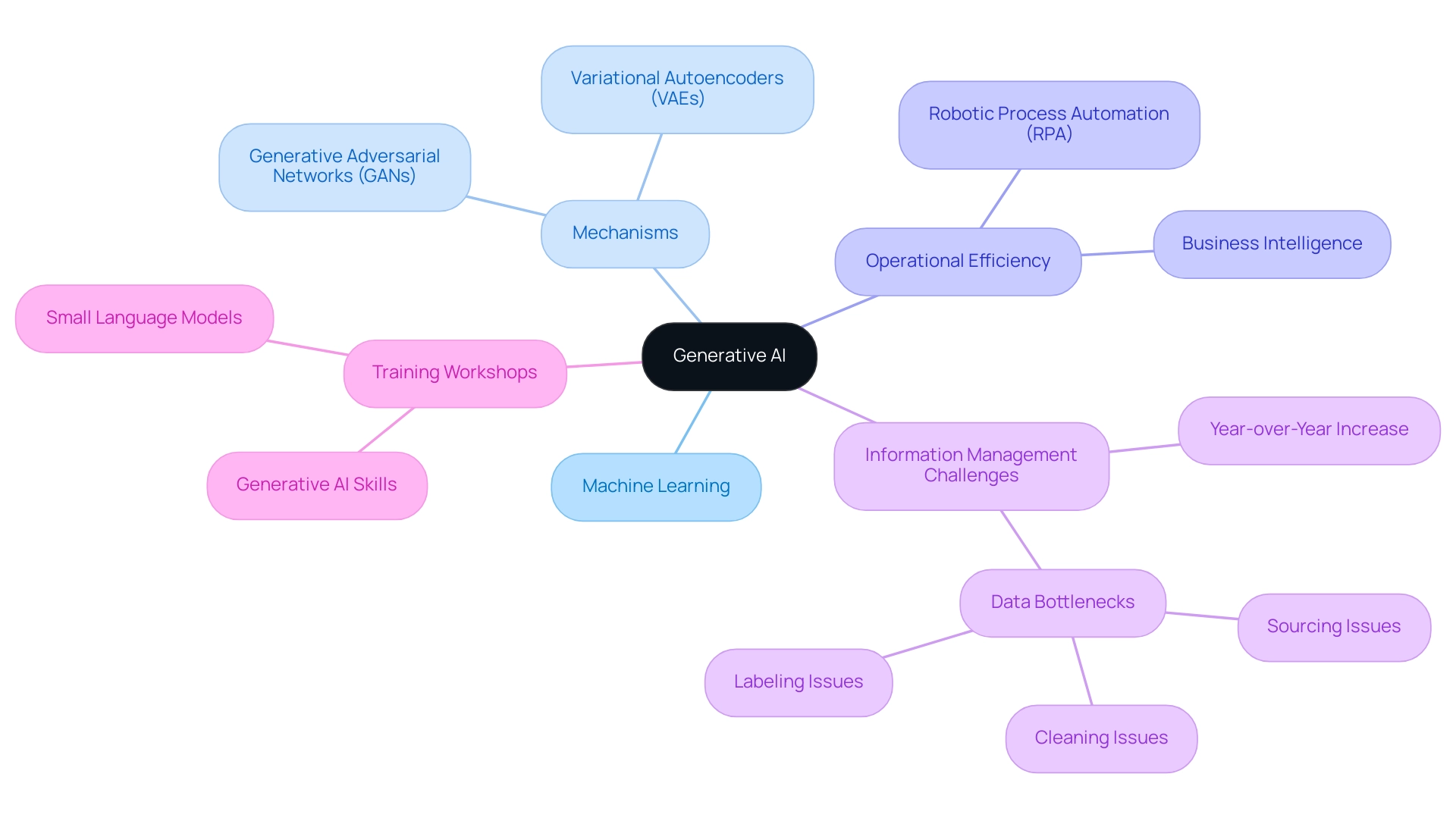
Understanding Machine Learning: Principles and Applications
Machine intelligence serves as a crucial area of artificial intelligence, enabling systems to gain knowledge from information and improve their performance independently. This field encompasses a variety of techniques, notably:
- Supervised instruction
- Unsupervised instruction
- Reinforcement training
Supervised training instructs algorithms on labeled datasets, enabling precise predictions, whereas unsupervised analysis examines unlabeled data to uncover hidden patterns and insights.
Reinforcement training, on the other hand, emphasizes decision-making through a process of trial and error, adapting strategies based on outcomes. The applications of machine learning are extensive and impactful; for instance, in finance, predictive analytics is employed to forecast market trends, while e-commerce platforms utilize machine learning to offer personalized recommendations, significantly enhancing customer experiences. As Katrina Wakefield from SAS UK observes, “As information continues to diversify and change, more and more organizations are embracing predictive analytics, to tap into that resource and benefit from information at scale.”
This observation highlights a critical shift in the industry: the development of predictive models is increasingly being undertaken by a broader array of professionals, including business analysts and consultants, not solely analysts. This democratization of model development not only bolsters operational efficiency but also empowers organizations to leverage Robotic Process Automation (RPA) and Business Intelligence. By automating manual workflows—often plagued by repetitive tasks that slow down operations and lead to staffing shortages—and transforming raw data into actionable insights, businesses can enhance efficiency and drive growth in an ever-evolving AI landscape.
Tools like EMMA RPA and Microsoft’s Power Automate exemplify how RPA can streamline processes, reduce errors, and free up teams for more strategic tasks.
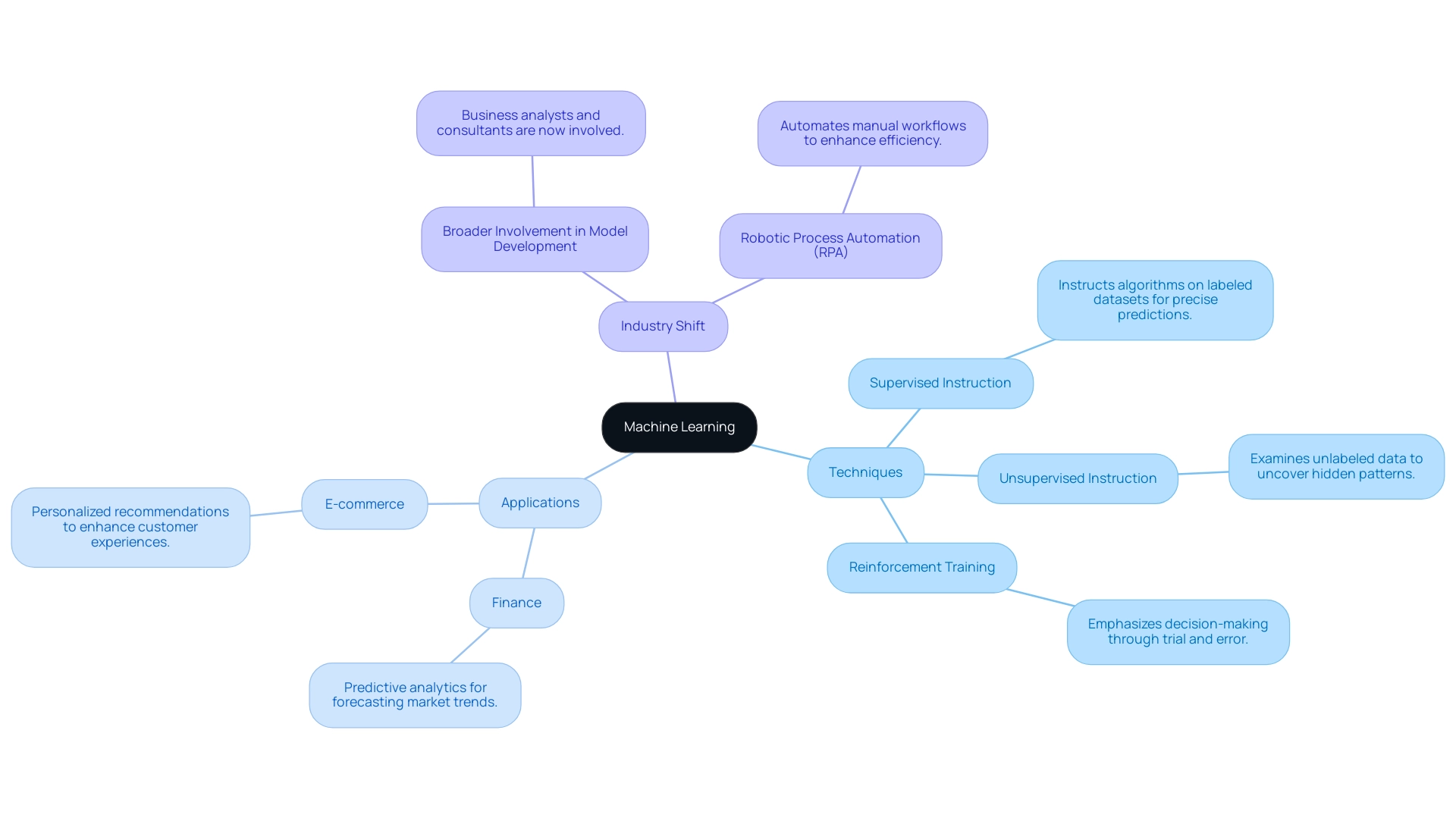
Key Differences Between Generative AI and Machine Learning
To enhance their operations, organizations must comprehend what is the difference between generative AI and machine learning, as both serve different functions within the AI ecosystem. To understand what is the difference between generative AI and machine learning, it’s important to note that:
- Generative AI is mainly focused on the production of new content, facilitating innovative solutions across different sectors.
- Machine learning emphasizes examining existing datasets to generate predictions or classifications.
Remarkably, creative AI frequently employs machine intelligence methods, yet its abilities go beyond traditional uses by encouraging innovation.
For instance, while machine learning can predict customer behavior by examining historical information, generative AI can craft personalized marketing content designed specifically for those insights. Understanding what is the difference between generative AI and machine learning is essential for organizations aiming to harness both technologies effectively.
To further enhance productivity and efficiency, integrating Robotic Process Automation (RPA) can streamline manual workflows, reducing repetitive tasks and freeing teams to engage in more strategic activities.
RPA not only boosts efficiency but also significantly reduces errors, allowing organizations to allocate their human resources to higher-value tasks. However, businesses may face challenges in technology implementation, such as:
- Resistance to change
- The need for proper training
As highlighted in the context of Oman’s experience with mobile positioning information, scheduled for a webinar on April 20, 2021, this achievement of utilizing Big Data is a paradigm shift in the production processes of high-quality official indicators.
Moreover, leveraging Business Intelligence is crucial for transforming raw data into actionable insights, facilitating informed decision-making that drives growth and innovation. By acknowledging the differences and synergies between creative AI and machine learning, alongside the advantages of RPA and Business Intelligence, companies can navigate the evolving landscape with customized solutions that improve operational strategies.
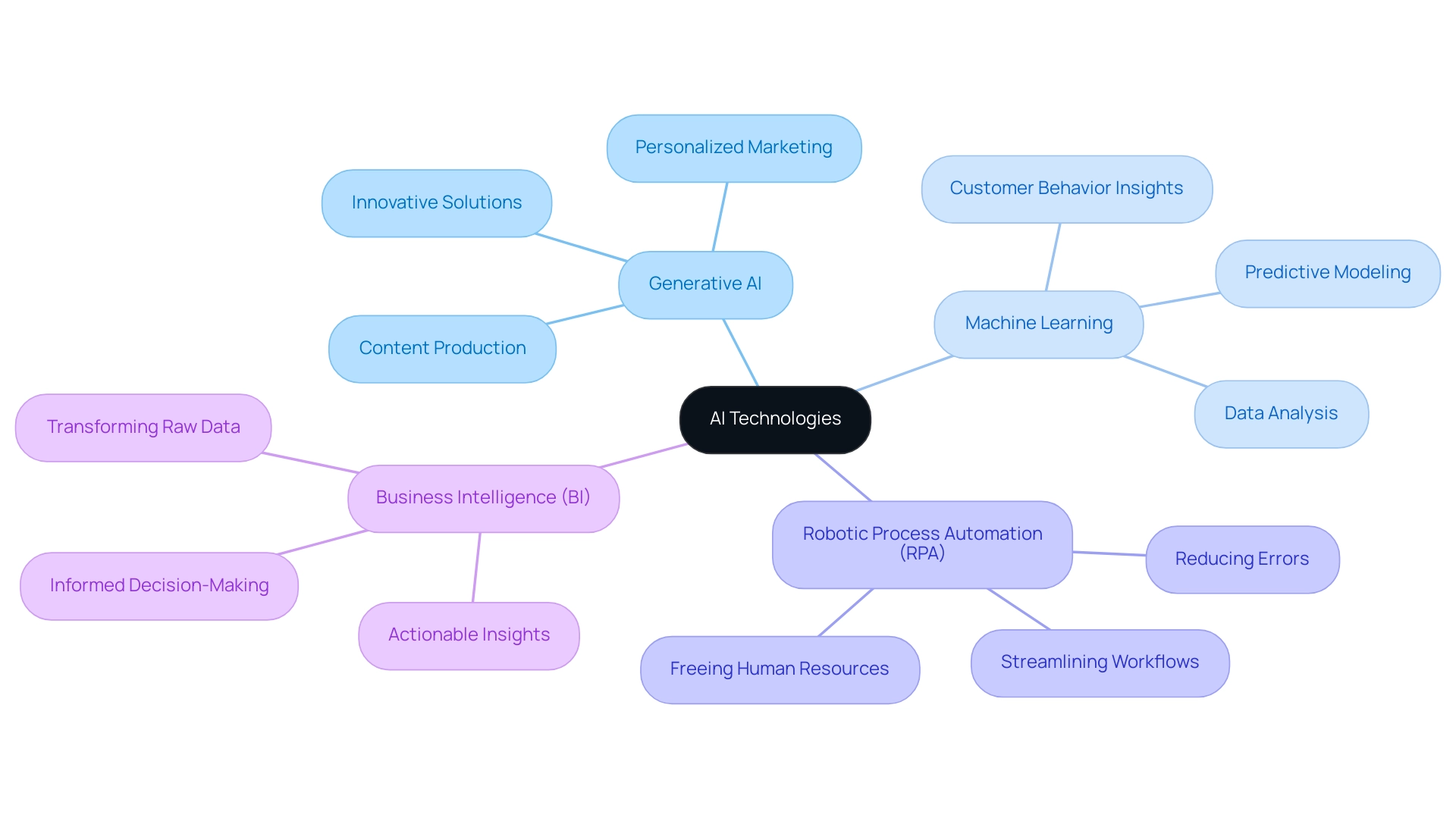
Benefits and Concerns of Generative AI
When discussing the benefits of generative AI, it is important to understand what is the difference between generative AI and machine learning, as generative AI stands at the forefront of technological advancement, offering businesses enhanced creativity, personalized content generation, and streamlined automation of repetitive tasks through tools like Robotic Process Automation (RPA). For instance, companies utilizing AI can create unique marketing campaigns that resonate deeply with target audiences, ultimately boosting engagement and sales. By integrating RPA, businesses can significantly reduce errors and free up valuable resources for strategic initiatives, thereby enhancing operational efficiency and driving productivity.
The scale of creative AI is exemplified by the fact that GPT-3’s training data is equivalent to about one million feet of bookshelf space, highlighting the vast amount of information these models can process. As we transition into 2024, the incorporation of creative AI in marketing is set to increase, with businesses progressively embracing customized AI solutions to improve their strategies and maintain an advantage in a competitive environment. However, alongside these advantages, significant ethical implications arise when considering what is the difference between generative AI and machine learning.
Concerns about the potential misuse of AI—such as creating deepfakes or disseminating misleading information—underscore the importance of establishing robust guidelines and ethical standards. As Alexander Sukharevsky, senior partner and global leader of QuantumBlack at McKinsey, aptly notes, ‘But before all that value can be raked in, we need to get a few things straight: What is gen AI, how was it developed, and what does it mean for people and organizations.’ Furthermore, the landscape of creative AI is rapidly evolving, with new use cases and regulatory considerations emerging.
Organizations must navigate these overwhelming AI options while utilizing the capabilities of innovative AI and Business Intelligence to convert raw information into actionable insights, ensuring its responsible and effective application in their operations, ultimately leading to reduced costs and enhanced productivity.
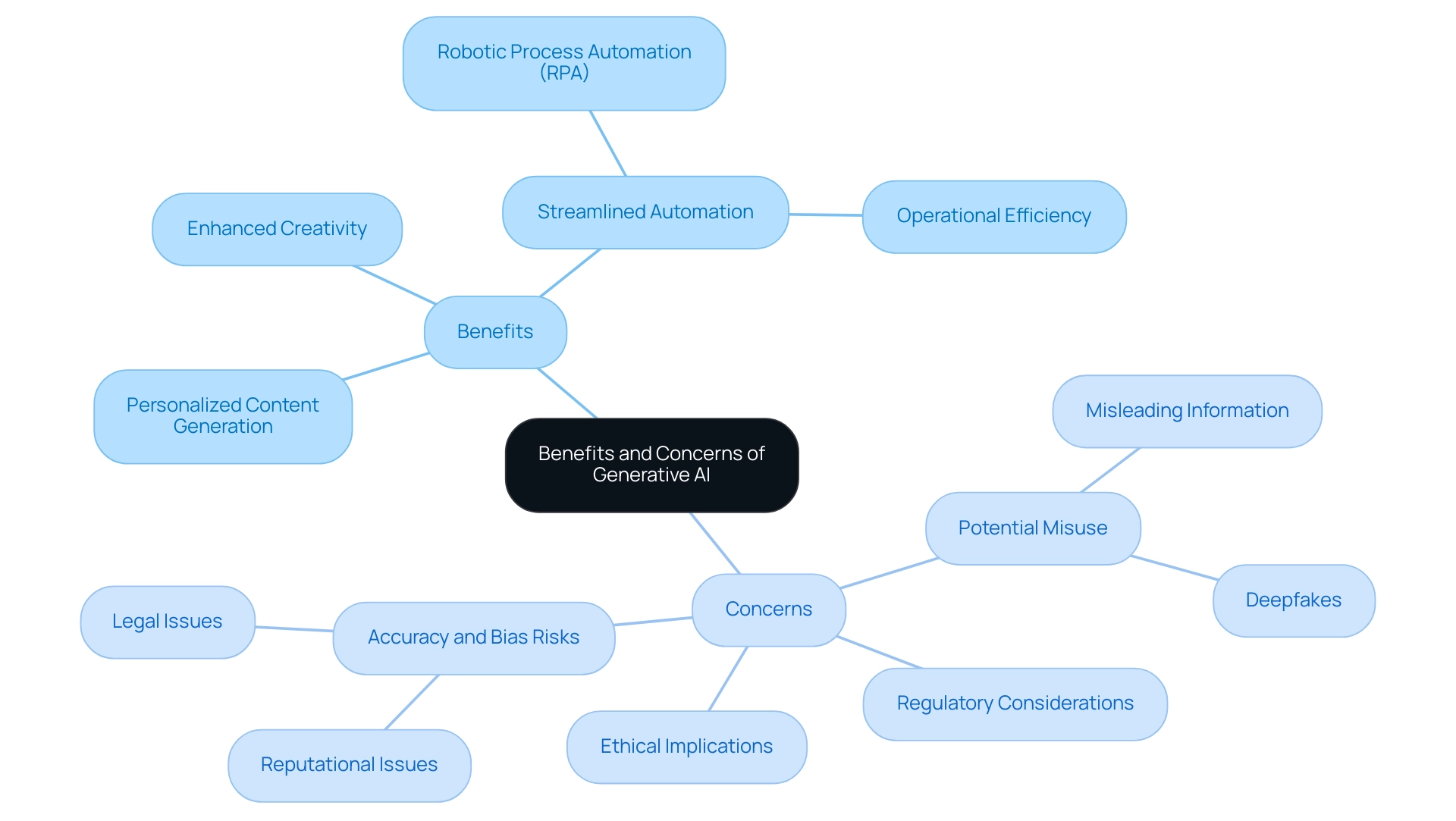
The Future of Generative AI and Machine Learning
The outlook for creative AI and machine intelligence is poised for significant expansion, driven by innovations in computational capability and information accessibility. As organizations increasingly acknowledge the transformative potential of AI in driving innovation, we can anticipate more sophisticated applications that seamlessly integrate generative AI with robotic process automation (RPA) and machine learning techniques, which raises the question of what is the difference between generative AI and machine learning. This integration not only streamlines manual workflows but also enhances operational efficiency, allowing teams to focus on strategic tasks that add value.
Moreover, the landscape of AI options can be overwhelming; therefore, leveraging tailored solutions such as Small Language Models (SLMs) can help organizations navigate these complexities, making AI implementation more efficient, secure, and cost-effective. Additionally, utilizing Business Intelligence will be crucial in transforming raw data into actionable insights, empowering informed decision-making that propels growth. Organizations that proactively adapt to emerging technologies while prioritizing ethical considerations and regulatory frameworks will likely secure a competitive edge in their industries, leading to personalized user experiences across sectors, from healthcare to entertainment.
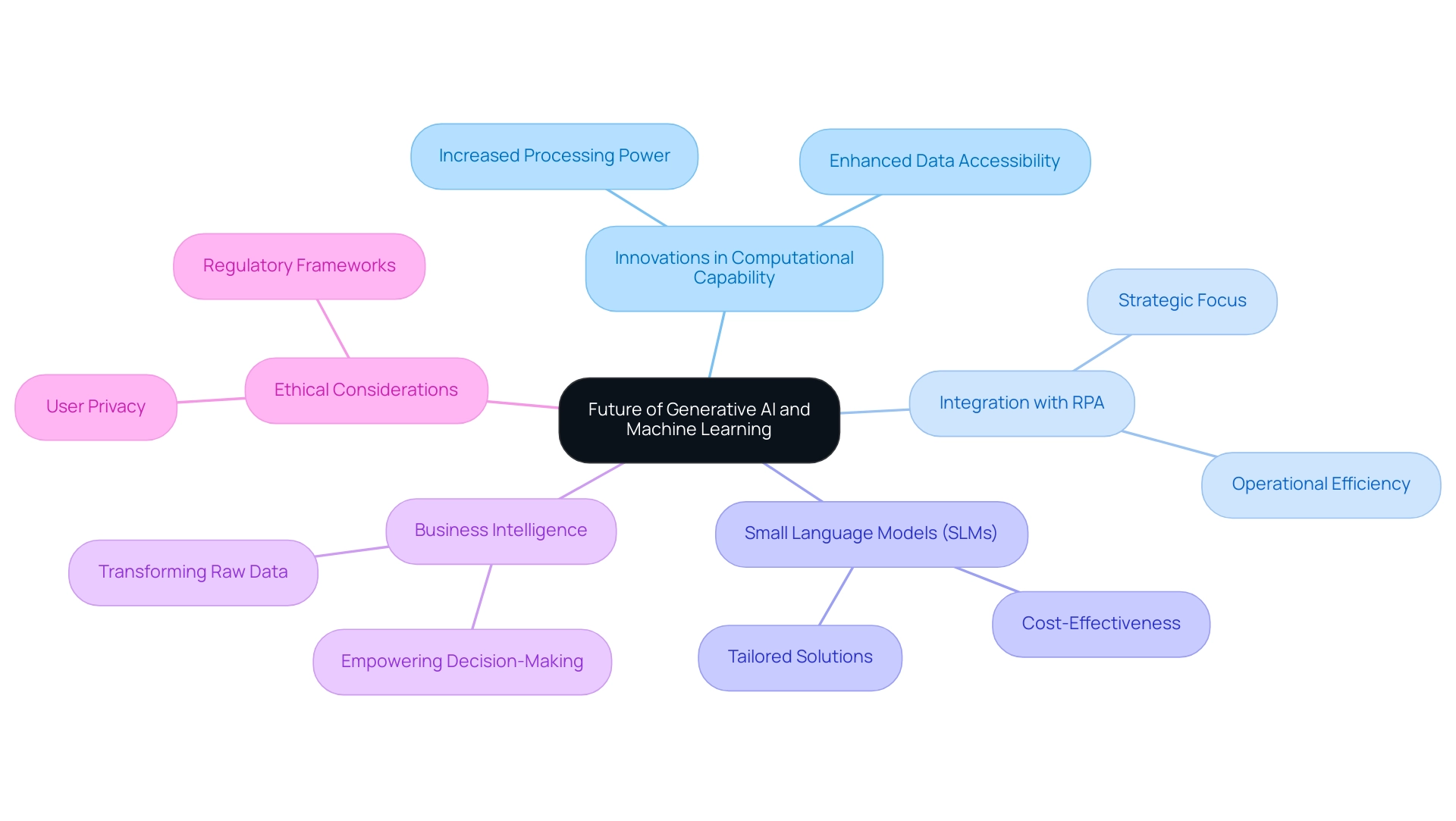
Conclusion
The integration of generative AI and machine learning marks a pivotal moment for organizations striving for operational efficiency and innovation. Generative AI’s ability to create original content and streamline processes through tools like Robotic Process Automation (RPA) provides businesses with a unique advantage in crafting personalized experiences and enhancing productivity. Meanwhile, machine learning empowers organizations to analyze data effectively, uncovering insights that drive informed decision-making and strategic growth.
Understanding the differences between these technologies is crucial for optimizing their use. While generative AI excels in creativity and content generation, machine learning focuses on data analysis and predictive modeling. Together, they can significantly reduce manual workloads and errors, allowing teams to dedicate their efforts to higher-value tasks. However, businesses must remain vigilant about the ethical implications and challenges associated with these technologies, ensuring they are harnessed responsibly and effectively.
Looking ahead, the future of AI is bright, with continuous advancements set to reshape industries. Organizations that embrace these technologies while prioritizing ethical standards and tailored solutions will position themselves for success in an increasingly competitive landscape. By unlocking the full potential of generative AI and machine learning, businesses can drive operational efficiency and sustain growth, paving the way for a more innovative and data-driven future.
Discover how our tailored AI solutions can help your business thrive—contact us today to learn more!
Introduction
In the rapidly evolving world of artificial intelligence, the size of AI models has emerged as a critical factor influencing their performance and applications. Organizations are increasingly recognizing that the number of parameters within a model not only determines its ability to learn and adapt but also significantly impacts operational efficiency and cost-effectiveness.
As businesses strive to harness the power of AI, understanding the intricate balance between model size and architecture becomes essential. This article delves into the nuances of AI model sizes, exploring:
- Their historical evolution
- The trade-offs involved in selection
- The innovative trends shaping the future
By navigating these complexities, companies can unlock the full potential of AI, streamline their workflows, and drive meaningful growth in an ever-competitive landscape.
Defining AI Model Size: A Fundamental Overview
The AI model size is determined by the quantity of parameters or weights that a machine learning framework possesses, which play a crucial role in its capacity to learn from data and produce precise predictions. Generally, larger systems can identify more complex patterns within datasets, enhancing predictive capabilities. However, it’s essential to recognize that the AI model size is not solely about the number of parameters; the architecture of the model significantly influences how effectively these parameters can be utilized.
Recent advancements in AI architectures have shown that optimized structures can enhance performance metrics, making it essential for entities to consider AI model size and architecture when implementing AI strategies. By leveraging Small Language Models (SLMs), businesses can achieve efficient data analysis that is secure and cost-effective, addressing issues of poor master data quality while overcoming the challenges of AI adoption. Additionally, our GenAI Workshops provide hands-on training, empowering teams to create tailored AI solutions that fit their specific needs.
As Mark Webster notes, ‘52% of experts believe automation will displace jobs and create new ones,’ highlighting the implications of AI adoption on workforce dynamics. With 43% of businesses planning to reduce their workforce due to technological integration, it becomes imperative for organizations to adapt and harness AI effectively. The study titled ‘Consumer Perspectives on AI‘ reveals a mix of optimism and skepticism among consumers regarding AI technologies, underscoring the need for better communication and education around AI.
By concentrating on the appropriate framework dimensions, architecture, and optimizing the AI model size, companies can improve operational efficiency and manage the challenges of AI adoption in a swiftly changing technological environment. This journey reflects a dialogue between human curiosity and artificial intelligence, symbolized by the visual metaphor of a human figure contemplating a question mark alongside a robot holding a light bulb, illustrating the innovative potential of AI.
![]()
The Implications of Model Size on AI Performance and Applications
The ai model size of an AI system plays a pivotal role in determining its performance capabilities, especially when considering the integration of Robotic Process Automation (RPA) into workflows. Larger systems, like GPT-3, which boasts an impressive ai model size of 175 billion parameters, excel in complex tasks such as natural language processing and image recognition, often resulting in outstanding language generation. However, this enhanced capability incurs increased computational demands and operational costs—ChatGPT’s initial budget, for instance, was set at €100 million annually.
In contrast, smaller ai model sizes can provide efficiency and speed, making them ideal for real-time applications, although this may involve some compromises in accuracy. As Thomas Scialom, a research scientist at Meta, suggests, ‘We can put more compute in the smaller ai model sizes, and in the larger ai model sizes, we will have better designs with the same recipe in five years’ time.’ This viewpoint motivates organizations to reassess their strategy for selection, especially regarding RPA, which can optimize manual workflows, diminish mistakes, and allow teams to focus on more strategic, value-enhancing tasks.
Choosing the future we wish to simulate is both a functional and spiritual choice about our identity, highlighting the importance of aligning model capabilities with organizational values and goals. Furthermore, President Macron’s advocacy for open-source options in France highlights the increasing importance of accessible AI technologies. Insights from Jeff Wittich further suggest that optimizing LLM performance with CPUs may challenge the conventional reliance on high-end hardware for AI tasks, paving the way for more affordable computing options.
By thoughtfully evaluating their particular needs and operational objectives, businesses can select the suitable framework that balances performance with resource efficiency, ultimately resulting in more effective AI integration, improved business productivity, and an appropriate AI model size. Furthermore, smaller systems can be particularly cost-effective, allowing organizations to implement RPA solutions without incurring substantial operational costs, thus enhancing overall efficiency.
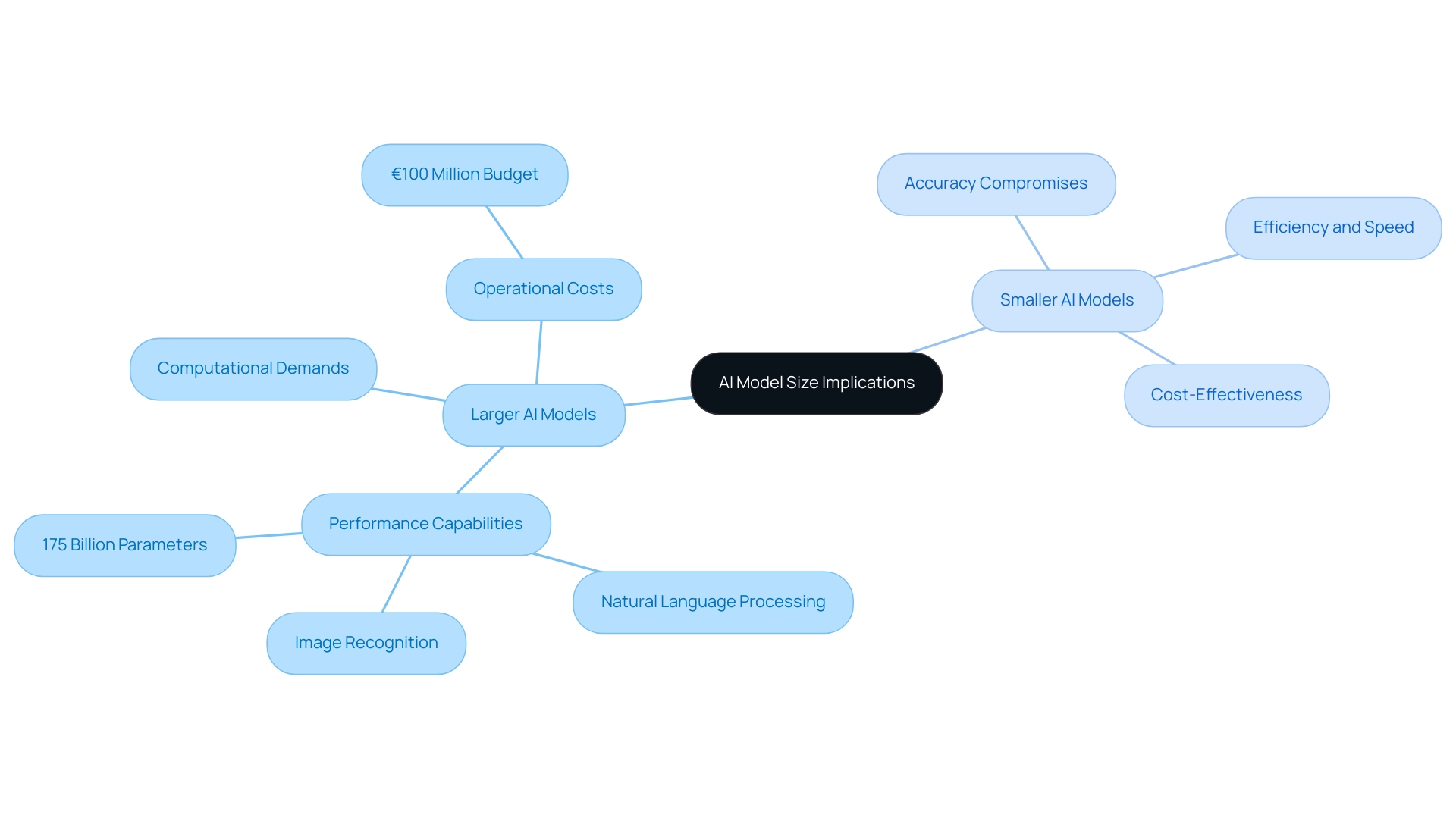
A Historical Perspective on AI Model Size Evolution
The evolution of AI model sizes has been a remarkable journey, beginning with early machine learning algorithms that were limited by a small number of parameters. As computational power increased and large datasets became accessible, AI systems expanded considerably. The introduction of deep learning marked a transformative moment, enabling the development of neural networks capable of handling millions of parameters.
This shift has been pivotal, allowing AI systems to tackle increasingly complex tasks. From 2010 to 2024, the quantity of parameters in prominent systems has skyrocketed, with trends indicating a clear move toward even larger frameworks. Notable examples include Google’s BERT and OpenAI’s GPT series, which have set new benchmarks in natural language processing.
Claude 4, developed by Anthropic, further illustrates the rapid growth trajectory of AI model sizes. This evolution reflects not just technological progress but also the growing expectations placed on AI systems, particularly concerning AI model size, to perform sophisticated functions, driving innovations that are shaping the future of artificial intelligence. In this context, leveraging Robotic Process Automation (RPA) can help streamline workflows by automating manual, repetitive tasks, thereby boosting efficiency, reducing errors, and freeing up your team for more strategic, value-adding work.
This enables entities to navigate the overwhelming options in the AI landscape effectively. As Steve Polyak poignantly remarked, ‘Before we work on artificial intelligence, why don’t we do something about natural stupidity?’ This quote serves as a reminder of the challenges faced in AI development.
Dr. Alan D. Thompson emphasizes the importance of aligning AI advancements with practical applications, including tailored AI solutions that can help organizations identify the right technologies to meet their specific business goals. For example, implementing AI-driven analytics tools can transform raw data into actionable insights, enabling informed decision-making. A tangible illustration of this evolution is OpenAI’s ChatGPT, which has attained extensive usage and acknowledgment for producing coherent and contextually appropriate responses, highlighting the practical effects of enhanced AI model size and system capabilities.
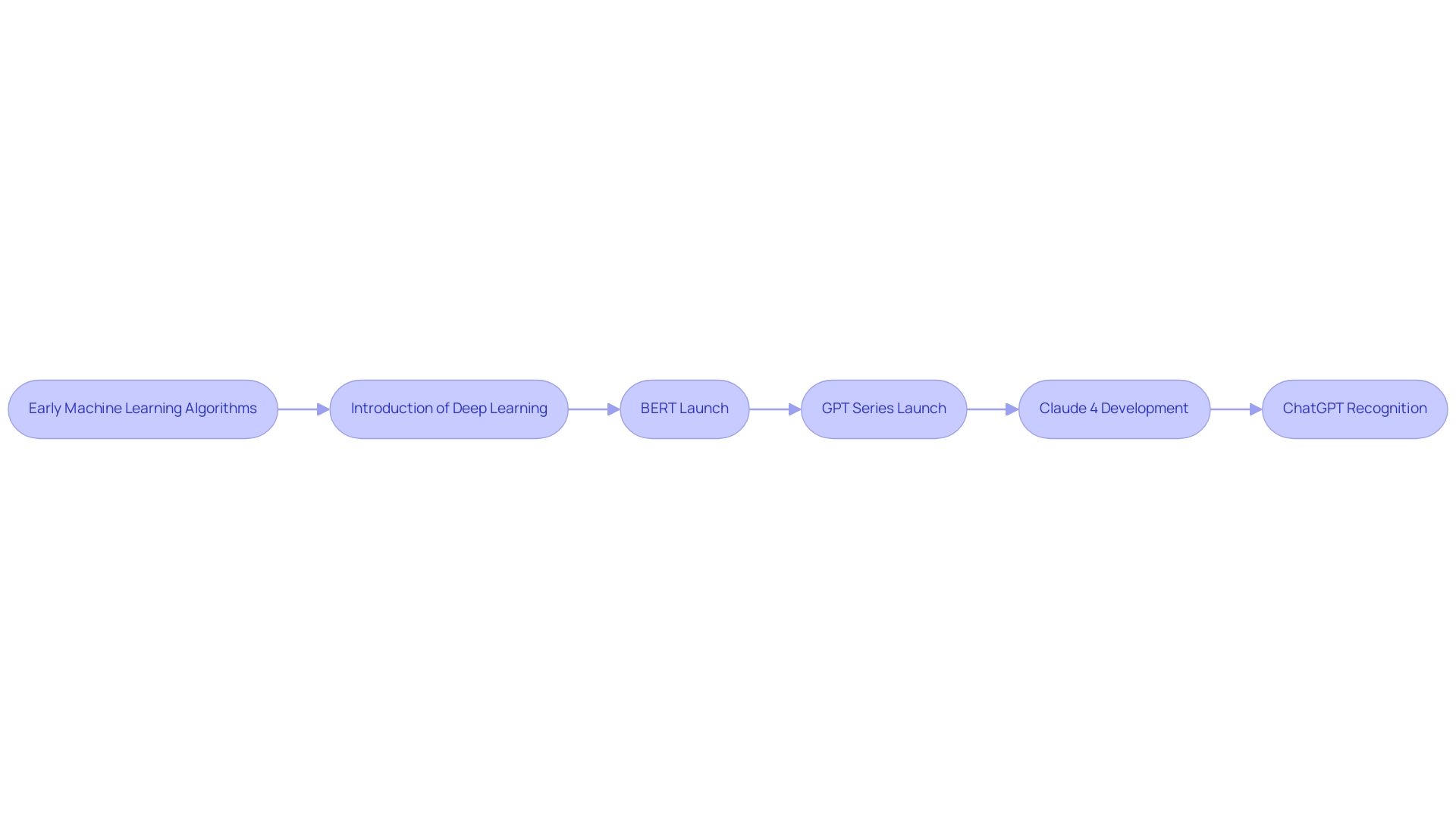
Navigating Trade-offs: Costs and Resources in Model Size Selection
Choosing the suitable AI model size is a nuanced decision that involves considering various trade-offs, particularly in the context of enhancing operational efficiency through RPA. Manual, repetitive tasks can significantly slow down operations, leading to wasted time and resources, which RPA aims to alleviate by automating these workflows. Larger systems, while capable of delivering enhanced performance, demand substantial computational resources that are influenced by the AI model size, leading to increased expenses related to hardware and energy consumption.
OpenAI’s recent pricing adjustment to one-fifth of one cent for approximately 750 words of output marks a significant reduction, reshaping the financial landscape for companies leveraging AI. This pricing shift has prompted organizations, including Latitude, to reassess their AI strategies. A Latitude spokesperson remarked, ‘I think it’s fair to say that it’s definitely a huge change we’re excited to see happen in the industry and we’re constantly evaluating how we can deliver the best experience to users.’
Such changes promote a reassessment of company strategies, especially as they aim to complement AI systems with RPA to automate manual workflows and enhance productivity. On the other hand, smaller AI model sizes typically provide a more budget-friendly and quicker training option, albeit often at the cost of reduced accuracy and capability. Organizations must carefully weigh their budget constraints, infrastructure capabilities, and specific application requirements to identify the optimal AI model size that aligns with their strategic objectives.
Customized AI approaches can specifically assist organizations in navigating the overwhelming AI landscape by providing targeted technologies that align with their business objectives. This consideration is particularly vital as they navigate the trade-offs between larger and smaller AI model sizes in 2024, while also exploring customized AI solutions and harnessing Business Intelligence to drive actionable insights and informed decision-making.
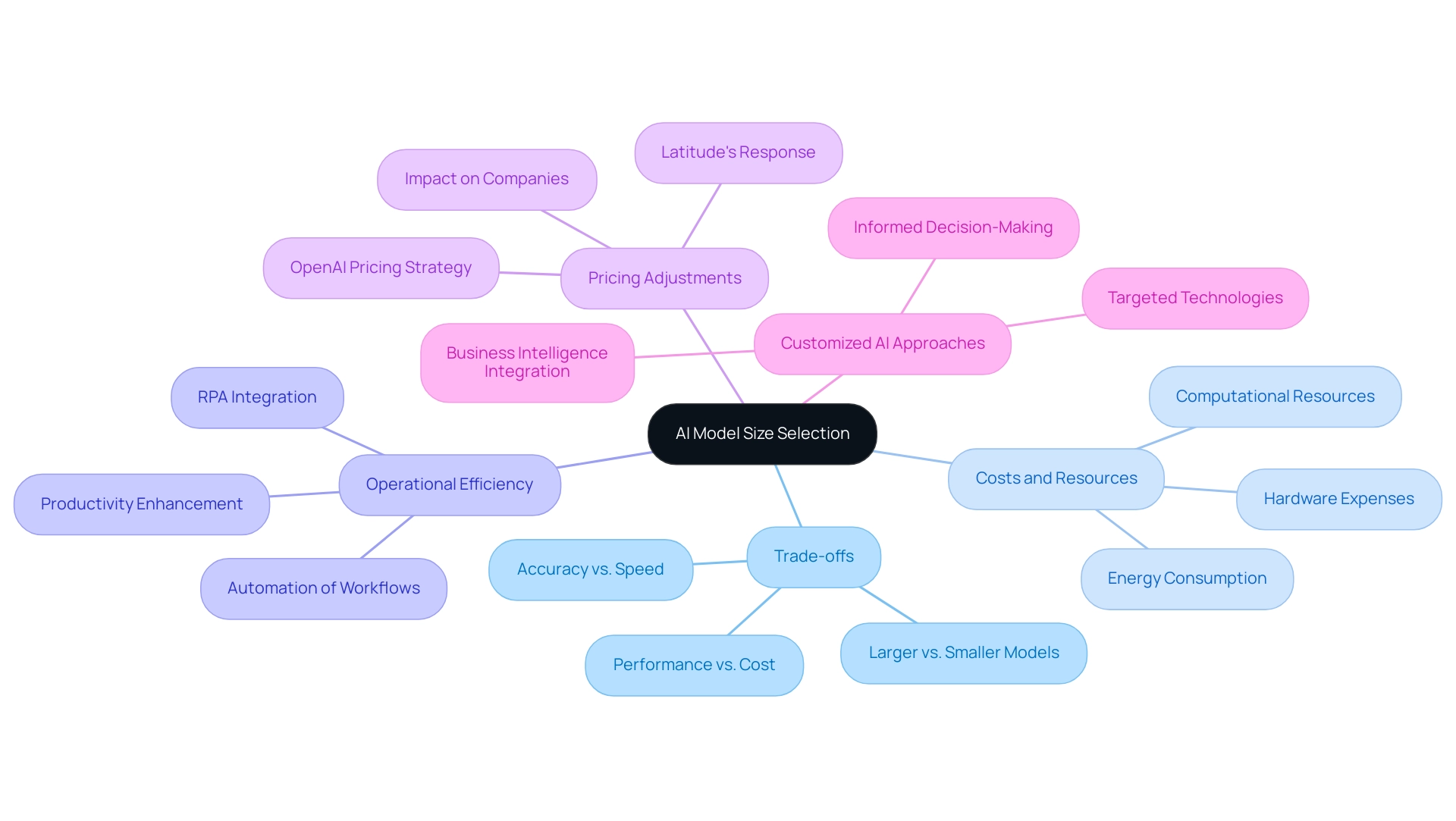
Future Trends: Innovations and Efficiency in AI Model Sizes
The landscape of AI frameworks is on the brink of transformative change, fueled by groundbreaking innovations in efficiency and advanced technology. Methods like pruning and quantization are becoming increasingly essential, allowing companies to reduce sizes without sacrificing performance. For instance, research indicates that educators utilizing AI-powered tools like Gradescope have achieved a remarkable 70% reduction in grading time, showcasing the potential of AI to streamline operations effectively.
In parallel, leveraging Robotic Process Automation (RPA) can further automate manual workflows, enhancing operational efficiency in an increasingly complex AI landscape. Sanjeev Verma, Founder & CEO, emphasizes that AI technologies handle transactions smoothly, ensuring secure payments and processing refunds without hassle, highlighting their operational efficiency. Furthermore, advancements in model architectures, particularly with transformers and attention mechanisms, are leading to the development of smaller models capable of executing complex tasks with fewer parameters.
The Biz4Group PDF Consultant AI case study demonstrates how AI innovations can save users 62% of their time on long-form content, translating to 8 days saved and increased productivity among working professionals. By referencing legal advisory platforms, we see that AI provides accessible and reliable counsel across various sectors, further broadening the discussion on its impact. As entities aim to enhance their AI systems, grasping these trends and their consequences will be crucial.
Additionally, the role of Business Intelligence in transforming raw data into actionable insights cannot be overstated, as it enables informed decision-making that drives growth and innovation. Businesses often face challenges in identifying the right AI solutions amidst the rapidly evolving landscape, making it crucial to embrace tailored AI solutions alongside RPA. By unlocking the full potential of RPA and AI technologies while managing costs and resources adeptly, organizations can set the stage for enhanced operational efficiency in the years to come.
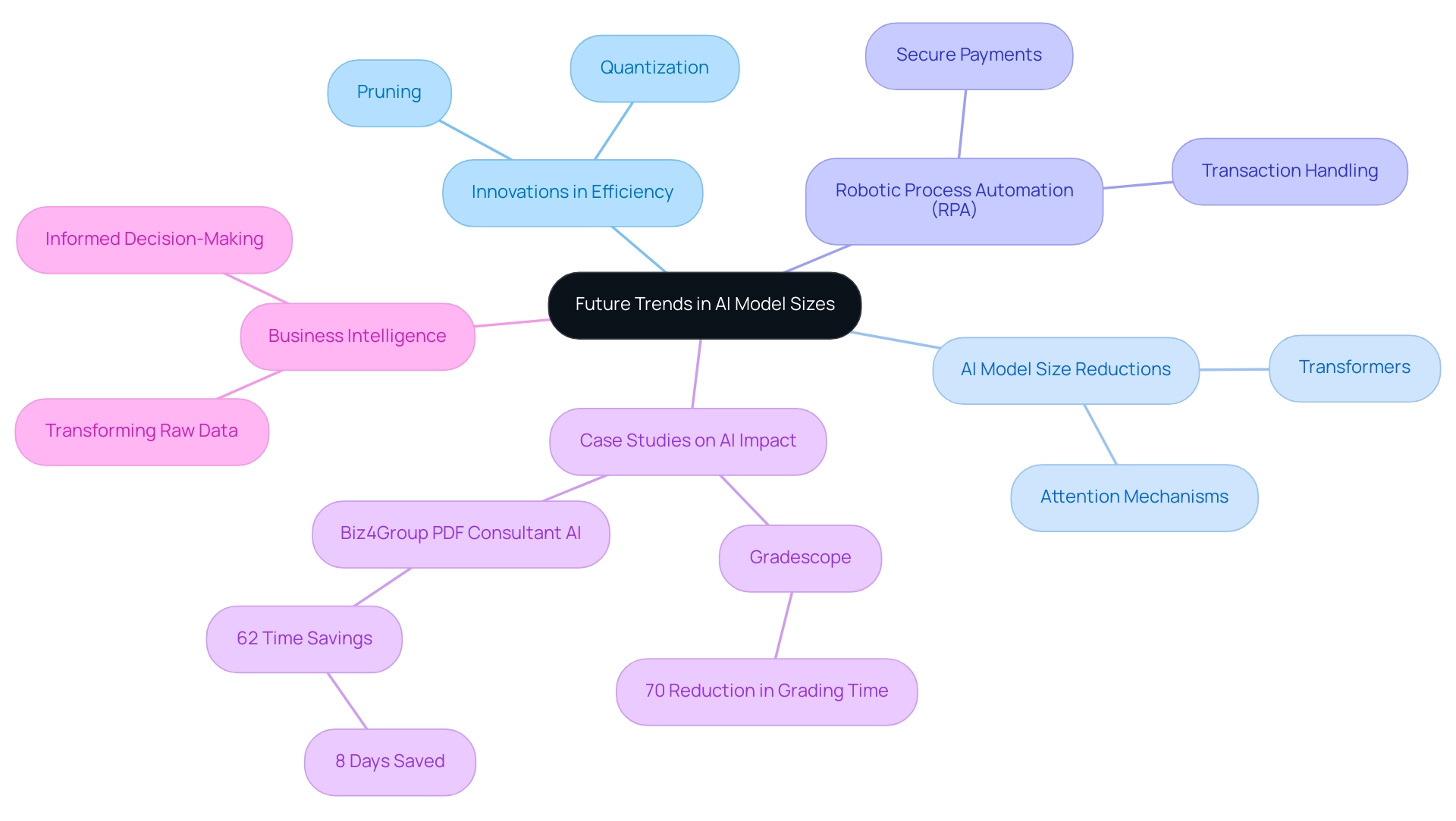
Conclusion
AI model size is a pivotal aspect that significantly influences performance, operational efficiency, and cost-effectiveness in the realm of artificial intelligence. As explored throughout this article, understanding the relationship between model size and architecture is essential for organizations looking to leverage AI effectively. The historical evolution of AI models illustrates a remarkable journey towards increased complexity and capability, with larger models demonstrating enhanced performance in tasks such as natural language processing and image recognition. However, this comes at a cost, necessitating a careful evaluation of resources and operational needs.
The trade-offs between larger and smaller models are critical for organizations aiming to enhance their workflows through AI integration. While larger models may offer superior capabilities, they also demand substantial computational resources and higher operational costs. Conversely, smaller models can provide quicker and more budget-friendly solutions, albeit with some compromises in accuracy. Businesses must strategically assess their unique requirements to select the model size that aligns with their goals, ensuring that they strike the right balance between performance and resource efficiency.
Looking ahead, the future of AI model sizes is marked by innovation and a focus on efficiency. Techniques such as model pruning and quantization are emerging as effective methods to streamline models without sacrificing their capabilities. By harnessing the advancements in AI technology and integrating Robotic Process Automation, organizations can enhance productivity and operational efficiency. As the landscape continues to evolve, embracing tailored AI solutions will be essential for navigating the complexities of AI adoption and unlocking the full potential of these transformative technologies. Through informed decision-making and strategic implementation, organizations can position themselves to thrive in an increasingly competitive environment.
Discover how our tailored AI and RPA solutions can streamline your workflows—contact us today!
Introduction
In an era where data drives decisions, Business Intelligence (BI) has emerged as a cornerstone for organizations seeking to navigate the complexities of modern markets. With tools like Power BI leading the charge, companies are empowered to transform raw data into actionable insights that enhance operational efficiency and foster strategic growth.
As the demand for data-savvy professionals continues to rise, understanding the nuances of BI and its integration with technologies such as Robotic Process Automation (RPA) becomes paramount.
This article delves into the critical components of BI, the skills necessary to excel in this field, and the future trends shaping BI education, providing a comprehensive roadmap for organizations and individuals alike to harness the full potential of their data.
Understanding Business Intelligence and Power BI
BI courses encompass the technologies and methodologies for gathering, analyzing, and presenting information, which is essential for informed decision-making. Among the top BI tools, Power BI, created by Microsoft, is notable for its capability to convert raw information into meaningful visual representations that can be shared across entities or integrated within applications and websites. This capability is especially crucial as Aditya Rayaprolu highlights, ‘69% of directors have accelerated digital transformation‘ in response to changing market conditions, emphasizing the necessity for organizations to utilize information effectively.
Companies with over 10,000 employees favor collaborative BI to enhance communication and project efficiency, illustrating a significant trend in the BI landscape. Power BI streamlines the visualization process, allowing organizations to make informed decisions effortlessly. Its user-friendly interface and robust functionality are complemented by our Power BI services, which include:
– A 3-Day Sprint for rapid report creation
– The General Management App for comprehensive management reviews
Additionally, we offer streamlined workflow automation through Power Automate, allowing you to automate processes efficiently while assessing ROI risk-free. Furthermore, our Robotic Process Automation (RPA) solutions can significantly enhance productivity by automating repetitive tasks, freeing your team for more strategic work. Tailored AI solutions also support your intelligence efforts by providing targeted technologies that align with your specific goals.
As the BI landscape experiences rapid evolution and expansion, understanding and utilizing BI courses in Power BI becomes essential for those aiming to enhance operational efficiency, tackle challenges such as time-consuming report creation, inconsistencies, and lack of actionable guidance, and propel organizational success. Explore our Actions portfolio and book a free consultation to discover how our services can transform your business intelligence capabilities.
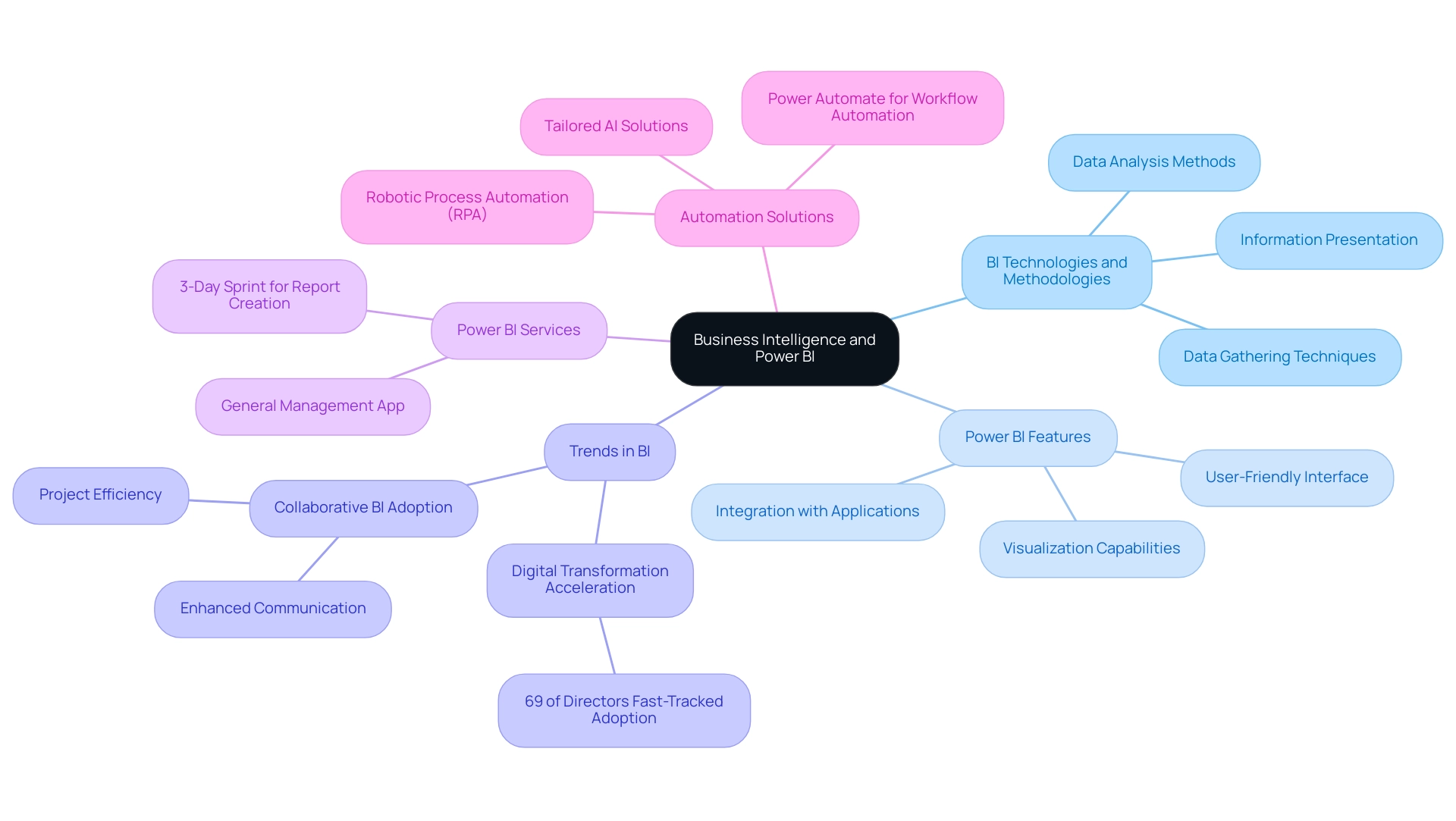
Key Skills and Learning Outcomes of BI Courses
Business Intelligence (BI) courses are specifically designed to equip participants with a comprehensive skill set vital for effective analysis and visualization, especially when navigating the complexities of today’s information-rich environment. These programs typically cover essential competencies such as connecting and preparing information from diverse sources, including Excel, databases, and cloud services. A significant focus is placed on creating interactive visuals and dashboards that effectively communicate complex insights in a clear and engaging manner.
Key learning outcomes encompass:
– Understanding information modeling principles
– Utilizing DAX (Data Analysis Expressions) for advanced calculations
– Employing best practices for compelling storytelling
Upon completing the BI courses, participants will acquire the skills needed to transform their entities’ information into actionable insights, ultimately enhancing decision-making processes and boosting operational efficiency. Additionally, with BI architects earning an average annual salary of $119,000, acquiring these skills presents a noteworthy financial advantage.
Real-world strategies, such as networking with BI professionals and leveraging job search platforms like LinkedIn, can significantly improve the chances of securing a BI analyst position, as demonstrated in the case study titled ‘Job Search Strategies for BI Analysts.’ As noted by Alexander S. Gillis, a technical writer for What is, ‘This article, originally published in 2020, was updated in October 2024 for timeliness and to add new information,’ emphasizing the ongoing relevance of BI education in today’s job market. Furthermore, grasping the difficulties of lengthy report generation, information inconsistencies, and the lack of clear actionable guidance can enable entities to utilize BI and RPA effectively.
RPA can simplify the report generation process, decreasing time spent on repetitive tasks and minimizing inconsistencies by automating information collection and reporting. Incorporating successful case studies, such as those from leading companies that have implemented BI solutions to enhance their operational efficiency and decision-making, can further illustrate the transformative potential of BI and RPA in driving growth and innovation.
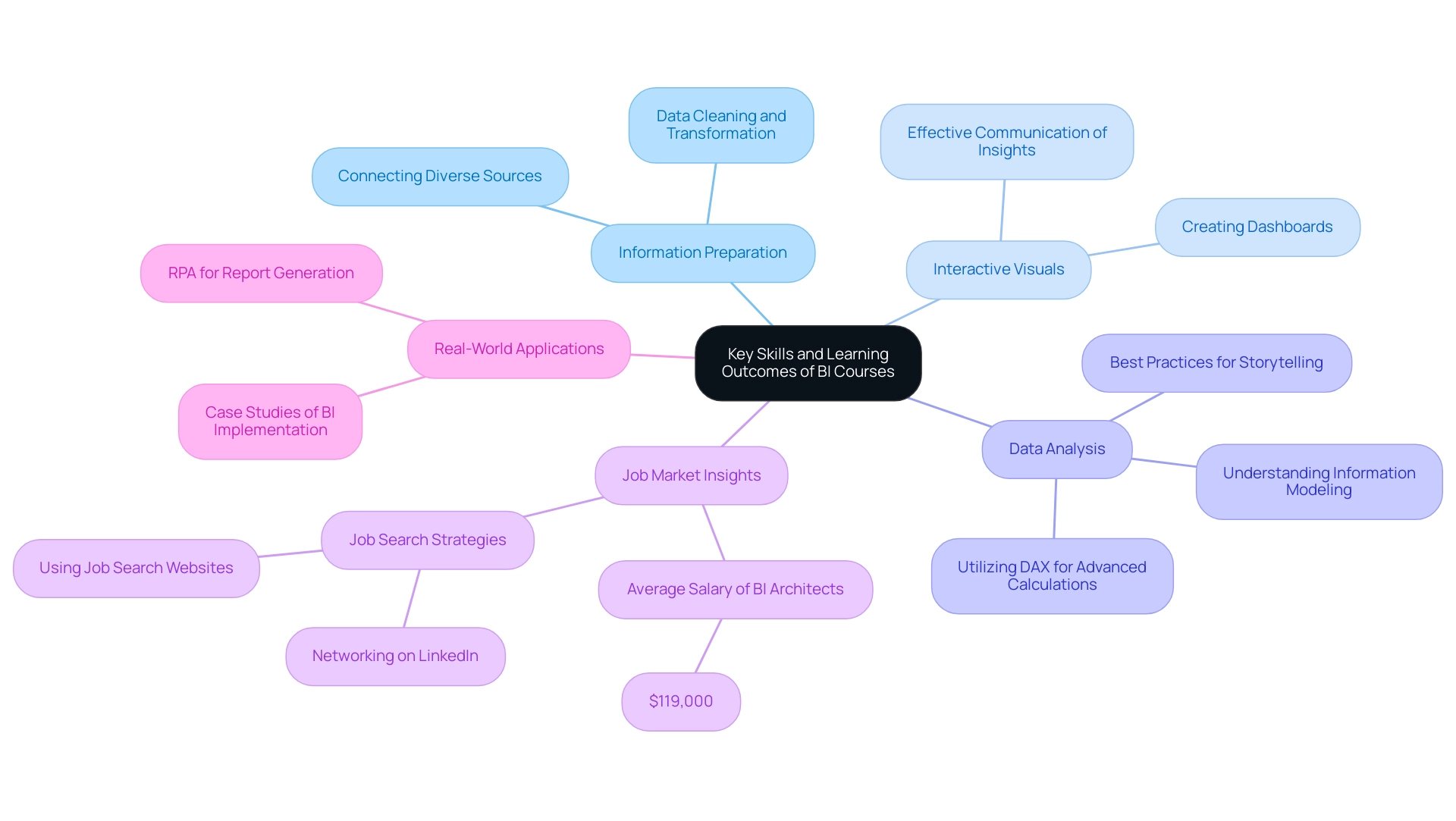
The Importance of Business Intelligence in Modern Organizations
In today’s data-centric environment, Business Intelligence (BI) is essential for entities striving to make informed decisions. By leveraging Robotic Process Automation (RPA) alongside BI tools, companies can automate manual workflows, significantly enhancing operational efficiency and reducing costs. BI enables entities to analyze extensive data sets, identify trends, and extract actionable insights that fuel strategic initiatives.
The integration of tailored AI solutions further streamlines this process, allowing businesses to navigate the overwhelming AI landscape effectively. This multifaceted approach not only elevates customer satisfaction levels but also positions organizations for growth in a rapidly evolving technological landscape. The increasing dependence on large sets of information and the necessity for real-time analytics has led to a rise in demand for professionals skilled in BI and RPA.
As a reflection of this trend, the World Economic Forum notes that 58% of companies view new innovations as a job creator, underscoring the potential for career advancement through BI courses. Furthermore, cloud computing has become the leading technology for companies investing in information and analytics, with 48% of technology leaders indicating investments in this area. PwC estimates that the economic gains from AI in regions like China and North America will reach $10.7 trillion, accounting for nearly 70% of the global economic impact, emphasizing the transformative power of data analytics in modern business.
As organizations prepare for 2024, understanding the importance of BI, RPA, and tailored AI solutions becomes crucial, given their proven impact on decision-making and operational excellence. Additionally, key considerations in the field of BI include minimizing bias, ensuring transparency, and protecting privacy, especially in light of AI advancements. To illustrate the current state of AI technology, it is important to recognize the three types of AI:
1. Artificial Narrow Intelligence (ANI)
2. Artificial General Intelligence (AGI)
3. Artificial Super Intelligence (ASI)
With only ANI being operational at present.
This context highlights the relevance of BI tools in navigating the complexities of modern data environments.
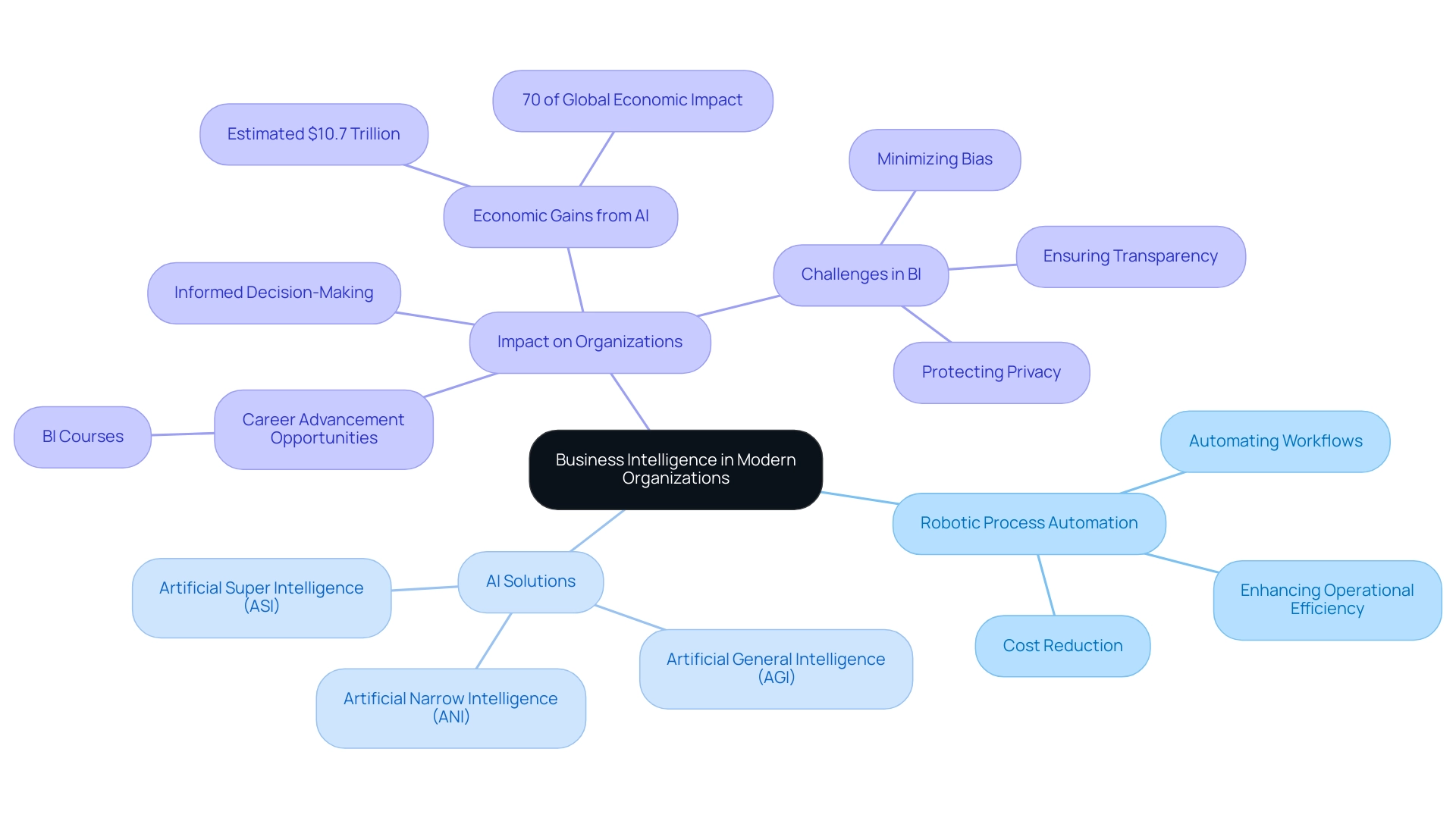
Future Trends in Business Intelligence Education
The landscape of Business Intelligence is poised for transformation as technological advancements, particularly in artificial intelligence and machine learning, continue to unfold. However, navigating the overwhelming AI landscape can be challenging for companies. Leveraging Robotic Process Automation (RPA) will not only streamline manual workflows but also enhance operational efficiency, allowing organizations to effectively address task repetition fatigue and staffing shortages.
Emerging trends in BI education will progressively incorporate these powerful BI courses, equipping students with the skills to harness AI-driven insights in their BI practices. The Hanlon Financial Systems Center offers vital technology and information sets for research and educational activities, enhancing the learning experience. Additionally, the BIA 679 Big Data Practicum, a 3-credit course, trains students to understand the entire value chain for data-intensive products and services, emphasizing data pipeline processes.
This course enables students to develop case studies that improve their critical thinking and technical skills, highlighting the significance of data-driven insights in organizational growth. The focus on cloud-based BI solutions further signifies a shift toward remote learning and collaborative environments, facilitating interaction among learners and instructors regardless of geographical boundaries. As Shardul Shinde, a graduate, wisely pointed out,
‘I selected intelligence and analytics because I wanted to engage in the tech field, but at the same time learn the commercial aspect of it.’
This combination of commerce and technology was a great fit for me. Staying informed about these evolving trends is essential for professionals eager to maintain a competitive edge in the rapidly changing BI landscape. The future of BI education includes BI courses that promise to not only enhance technical skills but also foster critical thinking through comprehensive training programs like the BIA 679 Big Data Practicum, ultimately driving business productivity and informed decision-making through the strategic application of RPA and BI.
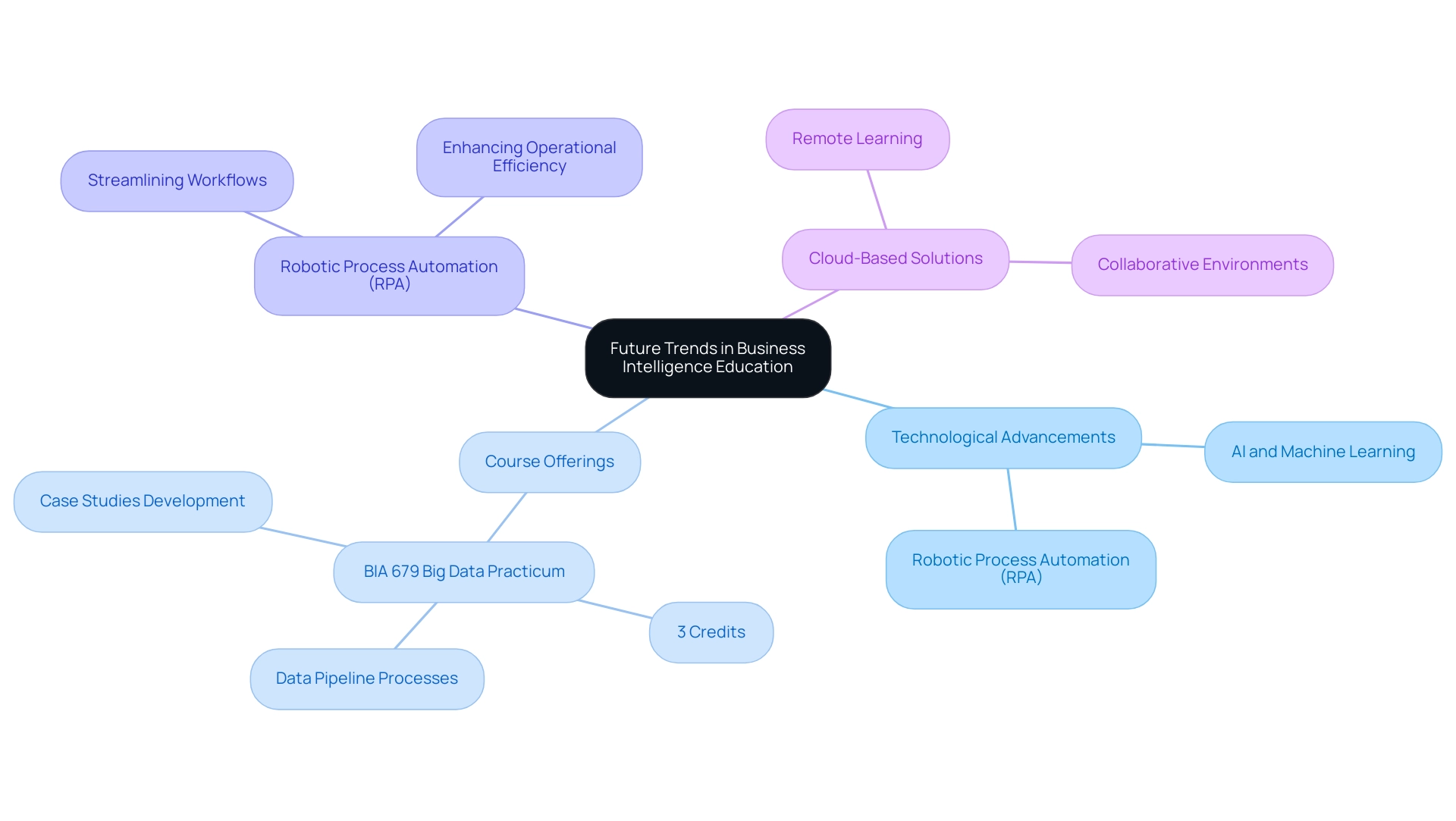
Conclusion
In the rapidly evolving landscape of Business Intelligence (BI), organizations must prioritize the integration of robust tools like Power BI and innovative technologies such as Robotic Process Automation (RPA) to unlock their data’s potential. The insights gained from effective data analysis not only enhance decision-making but also drive operational efficiency, allowing businesses to remain competitive in a data-driven world. The emphasis on equipping professionals with essential BI skills through targeted education is crucial, as it prepares them to navigate the complexities of modern data environments and fosters a culture of informed decision-making.
As organizations look toward the future, embracing the latest trends in BI education, including the incorporation of artificial intelligence and machine learning, will be vital. This evolution in learning will empower the next generation of BI professionals to harness advanced analytics effectively, ensuring they are well-equipped to meet the challenges of an increasingly complex market. By investing in these educational pathways and leveraging state-of-the-art BI tools, companies can position themselves for sustained growth and innovation.
Ultimately, the path forward is clear: embracing BI and RPA technologies is no longer optional but essential for organizations aiming to thrive in today’s competitive landscape. By transforming data into actionable insights and fostering a skilled workforce, businesses can navigate the complexities of modern markets with confidence, driving success and achieving their strategic goals.
Introduction
In the rapidly evolving landscape of artificial intelligence, organizations face a pivotal moment filled with both opportunities and challenges. As leaders in the tech industry, companies like Microsoft are navigating the complexities of AI development, emphasizing a commitment to responsible innovation while addressing pressing ethical concerns.
With the rise of Robotic Process Automation (RPA) and tailored AI solutions, businesses can enhance their operational efficiency, reduce errors, and improve customer experiences. However, the journey towards superintelligent AI is not without its hurdles—issues such as algorithmic bias and regulatory compliance loom large.
This article delves into the current state of AI technology, the importance of research and development, and the ethical considerations that must guide future advancements. By understanding these dynamics, organizations can strategically position themselves to harness the full potential of AI while fostering trust and accountability in their technological pursuits.
Microsoft’s Stance on the Timeline for Superintelligent AI
Microsoft says no chance AI soon, emphasizing that the rise of superintelligent AI is not on the immediate horizon. Executives within the company have emphasized that, according to Microsoft, the current state of AI capabilities is still a considerable distance from achieving the advanced intelligence and autonomy associated with superintelligence. This viewpoint is supported by an acknowledgment of the significant challenges that need to be tackled before such advancements, highlighting a careful and intentional method to AI progress.
In a recent statement, Emily Matzelle noted that over 40% of businesses say that customer experience is their top motivator for using artificial intelligence, illustrating the growing importance of AI in enhancing operational efficiency. Furthermore, statistics reveal that:
- 80% of the population is concerned about AI being used for cyber attacks
- 78% express worries about identity theft
This highlights significant public sentiment regarding AI technologies. This cautious stance reflects a broader industry trend that prioritizes safety and alignment with human values, ensuring that AI developments are not only innovative but also responsible.
A recent case study on GUI automation demonstrates how a mid-sized company encountered challenges like manual entry errors and slow software testing, ultimately enhancing its operational efficiency by automating these processes. The company achieved a reduction in data entry errors by 70% and accelerated testing processes by 50%. This example underlines the importance of leveraging Robotic Process Automation (RPA) and tailored AI solutions.
As Microsoft navigates these complexities, the company is setting a pragmatic timeline for AI capabilities, and as Microsoft says, no chance AI soon, they are focusing on ongoing research and ethical considerations that are vital for fostering trust and acceptance among users. Additionally, the practical applications of AI are evident, with chatbots responding to 85% of customer service interactions, further illustrating the role of AI in enhancing operational efficiency. Ultimately, Microsoft’s commitment to responsible AI development serves as a model for the tech industry, balancing innovation with the ethical implications of emerging technologies, and guiding businesses toward informed decision-making.
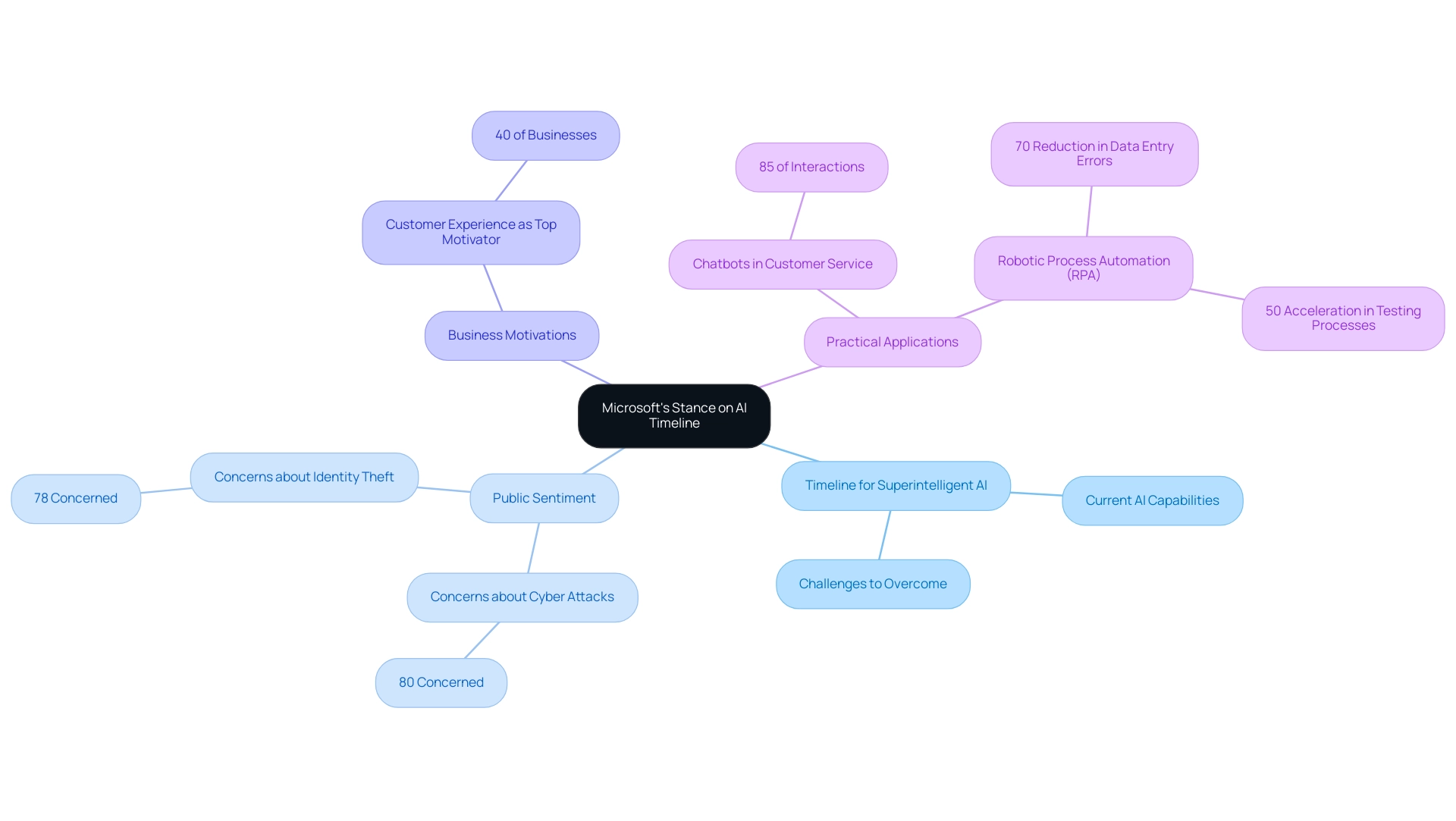
Challenges and Limitations in the Path to Superintelligent AI
The journey to attaining super intelligent AI is filled with significant obstacles and inherent limitations. Presently, AI systems face significant hurdles in generalizing knowledge and understanding context, which are crucial for advanced reasoning and nuanced emotional processing. While chatbots effectively handle 85% of customer service interactions, as noted by SEMrush, they still fall short in grasping complex human emotions and contextual subtleties.
To conquer these obstacles, utilizing Robotic Process Automation (RPA) can simplify manual workflows, significantly improving operational efficiency by minimizing errors and allowing your team to focus on more strategic, value-adding tasks. In conjunction with tailored AI solutions, organizations can cut through the overwhelming options available in the rapidly evolving AI landscape. Ethical concerns, including algorithmic biases and potential misuse of technology, present formidable barriers to progress.
Moreover, the economic implications of AGI are noteworthy, as relative prices will be impacted, with reproducible factors becoming cheaper while irreproducible factors appreciate in value. This perspective is reinforced by the case study titled ‘Abundance and Scarcity in an AGI Economy,’ which highlights that while AGI may increase abundance, true post-scarcity is unlikely due to ongoing economic trade-offs. As noted by experts, the ongoing evolution of regulatory frameworks adds another layer of complexity, generating uncertainty regarding compliance and governance in AI applications.
These challenges underscore the importance of a collaborative approach that unites technologists, ethicists, and policymakers. By addressing these critical issues collectively, organizations can position themselves strategically to navigate the intricate landscape of AI progress, leveraging Business Intelligence to transform raw data into actionable insights that drive informed decision-making and foster an environment that encourages responsible innovation and ethical advancement.
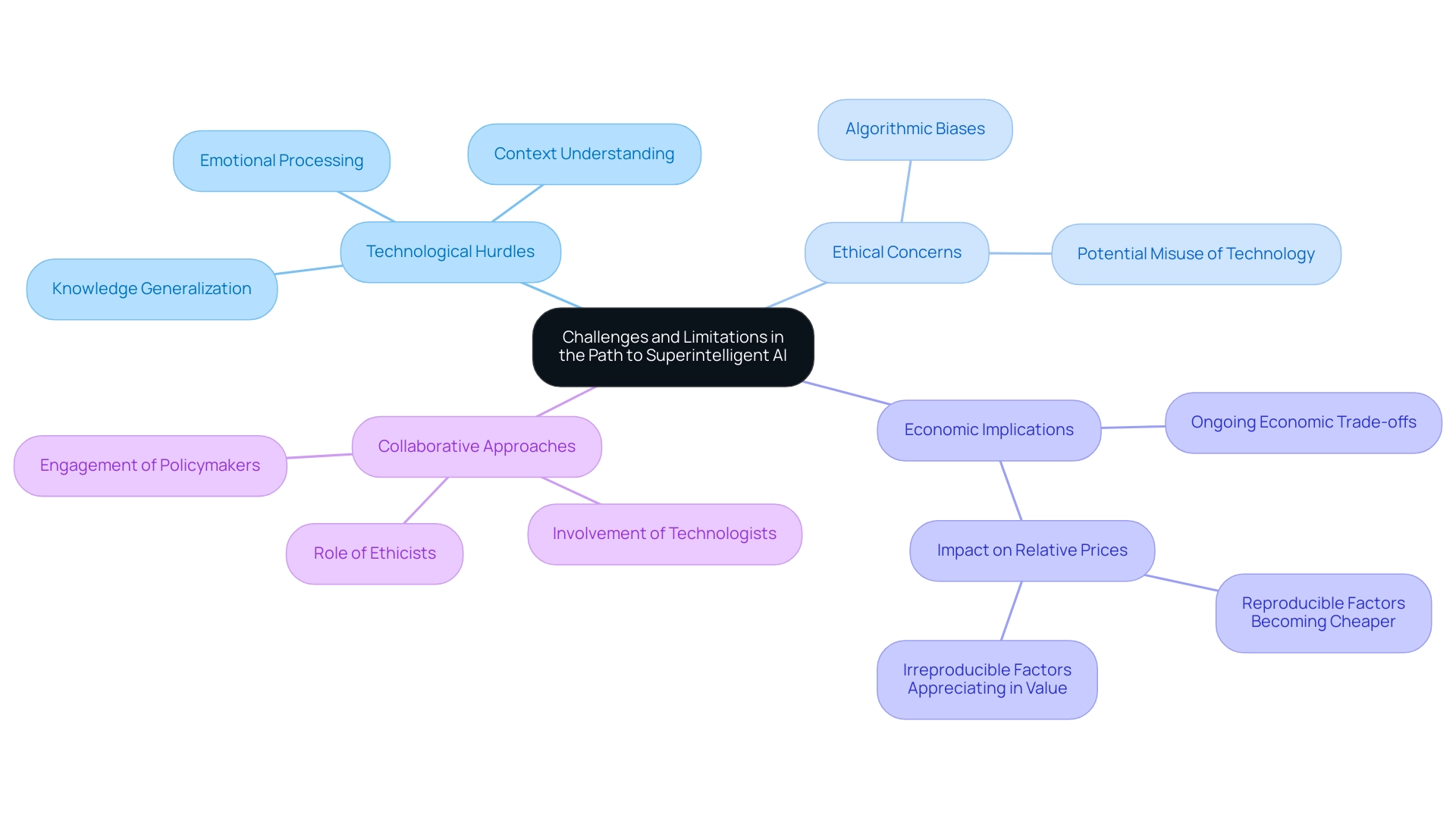
The Role of Research and Development in AI Progress
The progress of AI innovations relies heavily on strong funding in research and development (R&D), particularly in the context of utilizing Robotic Process Automation (RPA) to streamline manual workflows and improve operational efficiency. Organizations like Microsoft, which says no chance AI soon, are dedicating substantial resources to explore innovative algorithms and enhance machine learning techniques. This effort is vital as businesses aim to tackle implementation obstacles, especially those associated with manual, repetitive tasks that can consume resources and impede productivity.
Tailored AI solutions are essential to meet specific business needs, cutting through the noise of the rapidly evolving AI landscape. The collaboration between academia and industry creates a dynamic environment where theoretical knowledge can be effectively transformed into groundbreaking practical applications. For instance, in 2022, the FDA approved 139 AI-related medical devices, marking a more than 45-fold increase since 2012, demonstrating the rapid advancement and regulatory acceptance of AI technologies.
However, public sentiment continues to pose a difficulty; according to Pew data, 52% of Americans report feeling more concerned than excited about AI, and with Microsoft saying no chance AI soon, it underlines the need to address these perceptions in AI development. Businesses that have invested in AI R&D report transformative outcomes; a McKinsey survey revealed that 42% experienced cost reductions, while 59% noted revenue increases due to AI implementation. Looking toward 2024, the emphasis on R&D investment will continue to rise as companies strive to overcome the limitations of current AI systems, such as the need for fewer examples to learn effectively and enhancing interpretability.
PwC estimates that the economic gains from AI will be significant in China and North America, totaling $10.7 trillion, making the argument for R&D investment even more compelling. This commitment not only addresses urgent issues but also lays the groundwork for achieving superintelligent AI, reflecting a vision that is both empowering and essential for future progress in the field.
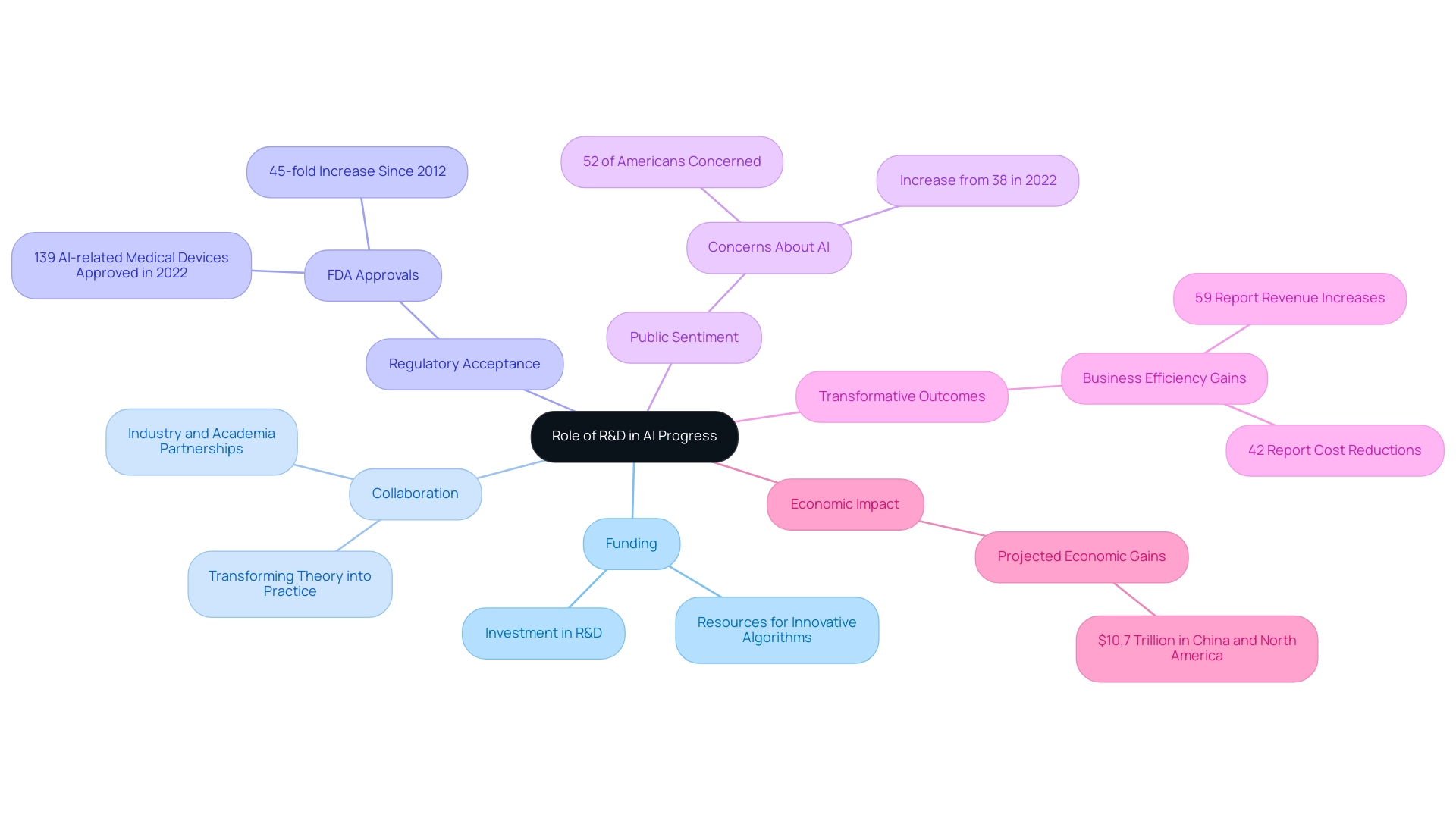
Ethical Considerations in AI Development
The advancement of AI innovations necessitates a heightened focus on ethical considerations. As organizations strive to build trust with users and stakeholders, prioritizing transparency, accountability, and fairness in AI systems becomes essential. Through our GenAI workshops, businesses can harness the power of generative AI to enhance customer experiences with personalized AI interactions, while also receiving hands-on training to effectively implement and manage these solutions.
Current challenges, such as algorithmic bias and privacy issues, underscore the urgency of developing robust ethical frameworks. Recent findings indicate that in 2024, a significant portion of AI systems will exhibit some form of algorithmic bias, highlighting the need for organizations to implement practices that mitigate these risks. For instance, chatbots are responding to 85% of customer service interactions, showcasing the practical implications of AI in customer service and the importance of ethical considerations in its deployment.
Furthermore, as Emily Matzelle notes, ‘80% of marketers already had chatbots as part of their customer experience strategy,’ providing authoritative support for the integration of AI technologies. Moreover, privacy concerns regarding information collection practices—such as comments from visitors and image uploads—highlight the importance of ethical AI usage. Organizations should adopt clear policies on information handling and ensure compliance with privacy regulations to protect user details.
Moreover, AI spending in the retail sector is expected to reach $20.05 billion by 2026, with a compounded annual growth rate of 39% since 2019, reflecting the industry’s commitment to leveraging AI for hyper personalization. To effectively integrate AI, organizations can implement strategies such as:
– Developing a clear data governance framework
– Utilizing robust data cleaning processes to address poor master data quality
– Establishing continuous monitoring systems to ensure data accuracy
By embracing responsible AI advancement through effective integration strategies and a commitment to ethical practices, organizations can align their innovations with societal values, fostering a positive community impact.
This ethical commitment not only reduces potential risks but also drives innovation; organizations that prioritize ethics are more likely to garner public support and customer loyalty, ultimately enhancing their operational efficiency and competitive edge.
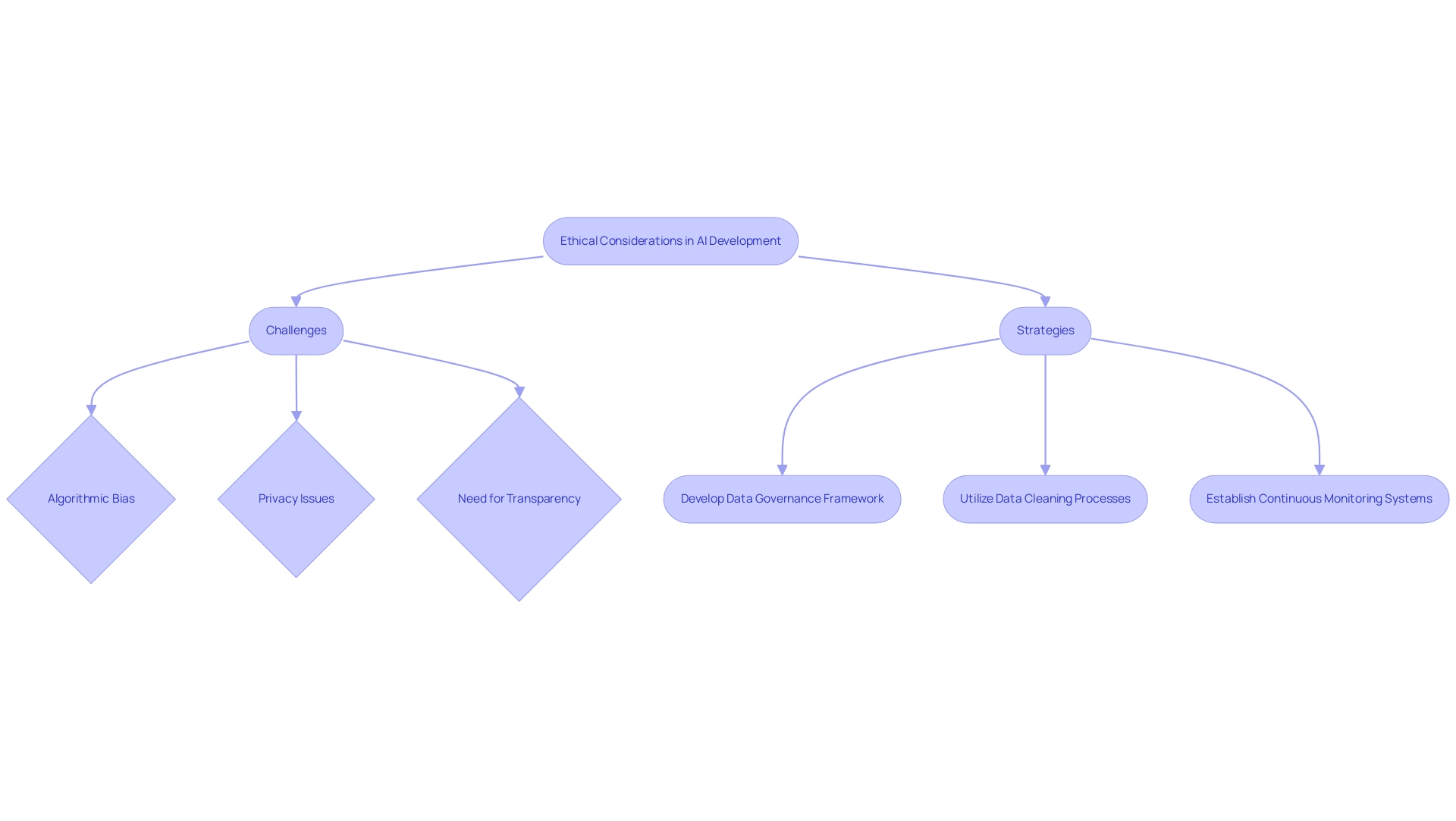
Future Directions for AI Development
The future of AI development is being shaped by several pivotal trends that organizations must embrace to thrive. As we approach 2024 and beyond, incorporating Robotic Process Automation (RPA) with advanced innovations such as quantum computing and the Internet of Things (IoT) is essential. This fusion enhances operational efficiency by reducing errors and freeing up teams for more strategic, value-adding work, driving unprecedented innovation across various sectors.
Notably, the number of AI incidents reported in 2023 reached 123, reflecting a 32.3% increase from the previous year, underscoring the critical need for interpretable and explainable AI systems. These systems empower users by clarifying decision-making processes, essential for building trust in AI technologies. Furthermore, with U.S. regulatory agencies issuing 21 new AI regulations, the growing concern over AI governance is evident.
Organizations must remain agile in their strategies to navigate this evolving landscape. The case study titled ‘AI Regulation Trends‘ highlights significant legislative efforts in 2023, with 181 bills proposed, reflecting heightened attention to AI governance. Embracing RPA alongside a culture of innovation and collaboration will position businesses at the forefront of the AI revolution, ensuring their contributions are responsible and aligned with the broader goals of superintelligent AI development.
As 64% of individuals affirm that the primary purpose of AI is to assist, enhance, and empower consumers, this underscores the potential of AI to drive significant advancements when leveraged wisely. Additionally, utilizing Business Intelligence tools can transform raw data into actionable insights, further supporting informed decision-making and addressing the challenges of AI implementation.
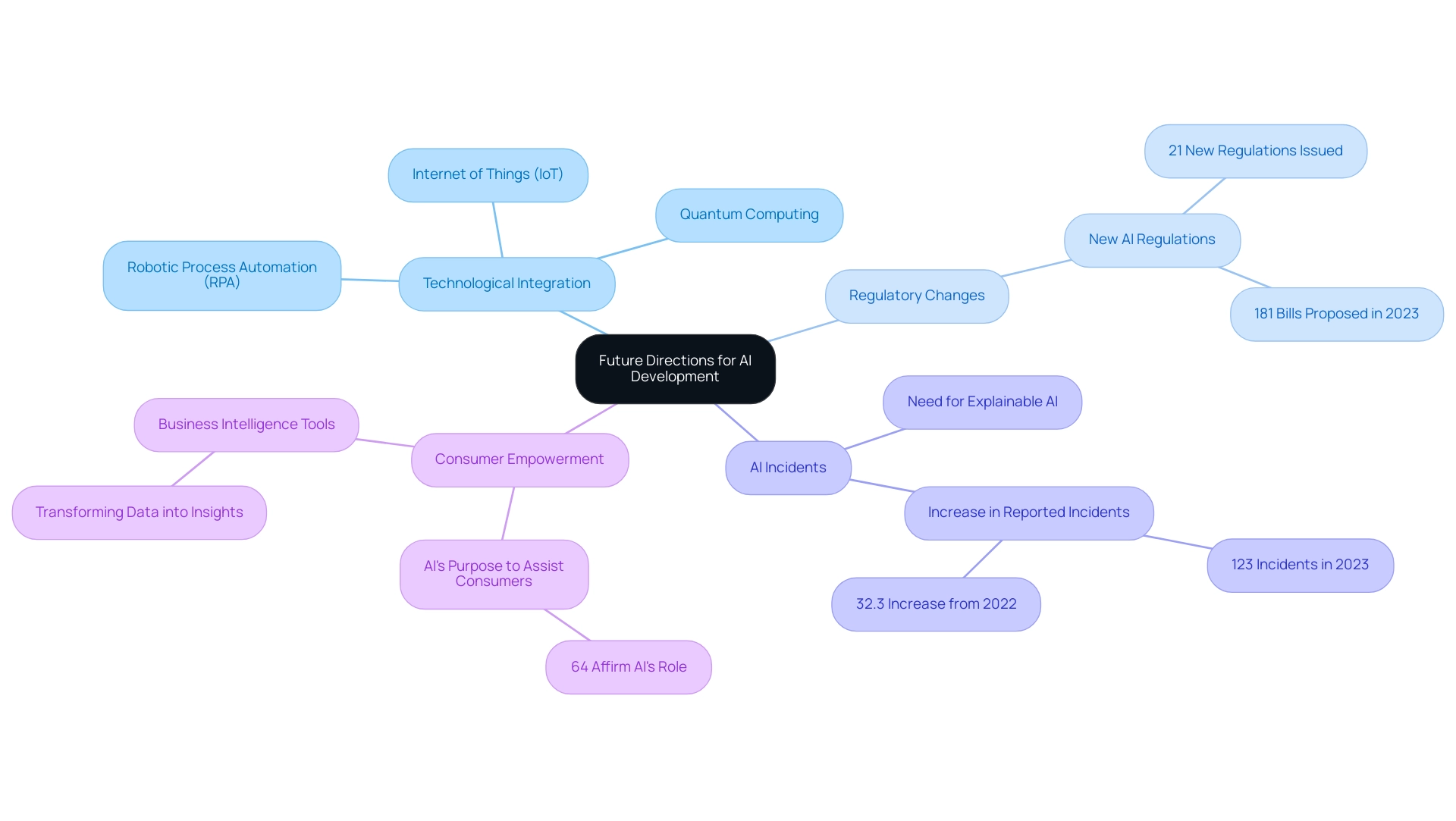
Conclusion
The journey towards superintelligent AI is a complex and multifaceted endeavor that requires a thoughtful approach to innovation. Organizations like Microsoft are leading the way by prioritizing ethical considerations and responsible development, ensuring that advancements in AI technology align with human values. This commitment not only addresses the pressing concerns surrounding algorithmic bias and privacy but also enhances operational efficiency through the integration of Robotic Process Automation and tailored AI solutions.
As the landscape of AI continues to evolve, investment in research and development remains crucial. Companies that embrace R&D are better positioned to overcome the limitations of current systems and harness the full potential of AI. The collaboration between academia and industry fosters an environment ripe for transformative breakthroughs, ultimately driving economic growth and improving customer experiences.
Looking ahead, organizations must remain agile and proactive in navigating the regulatory landscape and addressing public sentiment. By fostering transparency, accountability, and fairness in AI systems, businesses can build trust and promote a positive community impact. The future of AI holds immense potential, and by embracing ethical practices and innovative strategies, organizations can not only contribute to the evolution of superintelligent AI but also enhance their operational efficiency and competitive edge in a rapidly changing world. The time to act is now—embracing these principles will ensure that AI serves as a powerful ally in achieving organizational goals and driving meaningful advancements across industries.
